Report
Our annual report for 2017 is here. We hope you enjoy reading it.
BUTTERFLY CONSERVATION IRELAND ANNUAL REPORT 2017
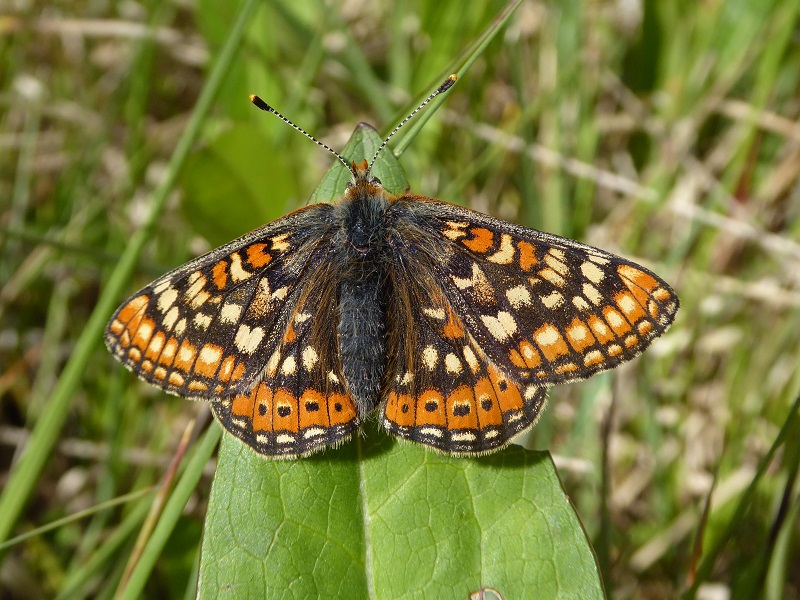
CONTENTS
- Introduction
- Butterfly Season Report
- Events Report
- Crabtree Nature Reserve Report
- Conservation News
- Garden Survey Report
- Red Admiral Garden Survey
- Garden Moth Scheme
- Species Focus: Hedge Brown
- Hungary for Butterflies
INTRODUCTION
Dear Butterfly Conservation Ireland Member,
Welcome to Butterfly Conservation Ireland’s Annual Report 2017. The year 2017 saw varied weather conditions but with less sunshine in July, August and September than we hoped for. Fortunately, there was some beautiful spring weather which provided wonderful opportunities to enjoy our countryside and butterflies. The assault on our public green spaces by state-funded bodies and the proposed changes to the closed season for hedge-cutting and upland burning in the Heritage Bill made for a very demanding year defending our natural heritage from unnecessary interference and destruction. Our small staff are fortunate in having excellent support from our active membership whenever help is needed in these endeavours. Your continued practical and financial support is greatly appreciated as we strive to ensure that our butterflies and moths continue to have an important voice for their conservation. Be assured that the conservation agenda is pursued at every opportunity. Our financial accounts were approved so thanks are due to our joint treasurers Michael Jacob and Joseph Harding. Thanks are due to Richella Duggan and Pat Bell for help in editing this report and to all who contributed to its contents and to all of our members and supporters. We hope that you enjoy reading our Annual Report 2017 and we look forward to hearing from you in 2018.
Yours in nature,
Jesmond Harding [Secretary]
Butterfly Conservation Ireland,
Pagestown,
Maynooth,
County Kildare.
Butterfly Season Report 2017
The weather for 2017 was kinder to butterflies than 2016 but 2017 was not a landmark year. The greatest known butterfly years in this part of the world were 1893, 1976, 1989 and 1990. These years saw long, hot summers. The years had different butterfly results because of the weather contexts in which they occurred. For example, the legendary summer of 1976 was not as good a summer as 1989 which had more hot, sunny days and fewer poor days but 1976 had far greater butterfly populations than 1989. This was because 1976 followed two good summers so that populations had been building. On the other hand, 1989 followed three appalling summers which had seriously depressed butterfly numbers. However, wonderful prolonged sunshine does not always benefit butterfly populations. June, July and August 1976 had little rain. The following year some species populations crashed because drought caused many larvae to starve on dehydrated and shrivelled food plants. Another notable summer was in 1995 which followed a miserable spring. The summers of 2005 and 2006 were very good for butterflies. The summer of 2017 did not deliver spectacular numbers.
In Ireland the butterfly flight season runs from March to October with some outliers. The weather in March was generally unsettled, changeable and largely mild, though wet overall especially in the West. An anticyclone then built over Ireland bringing a fine and settled spell at the beginning of the final week. This gave ample sunshine countrywide and some of the highest temperatures of the month. However, it was short lived as low pressure and unsettled conditions returned for the final days when it was a lot cloudier and more humid with occasional rain. Two warm spells early and late in March brought out our species that over-winter as adults with Brimstone numbers especially impressive.
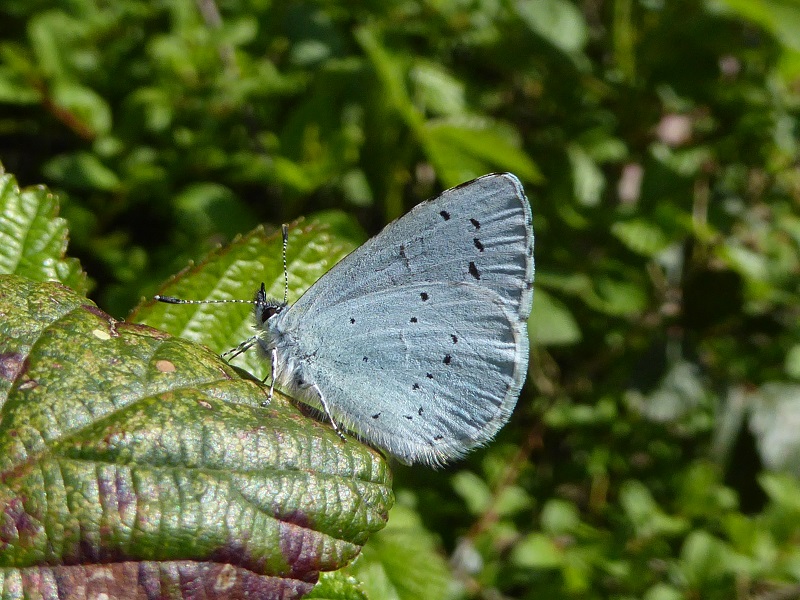
However, spring’s outstanding butterfly in much of east and the south of Ireland, and probably in many other areas was the Holly Blue. It seemed to be everywhere, with records from places it had been rare in or absent from in recent years. It showed up earlier in some areas with early April records from Donegal. A record of 26 Holly Blues from Athy on April 8th, a beautiful day, announced its prominence for the rest of spring. However, this abundance was not repeated in its second brood in July and August. April’s weather really helped spring butterflies. It was mild and dry nearly everywhere, and exceptionally dry, due mainly to the overall prevalence of high pressure. While the early part of the first week was changeable an anticyclone built over Ireland from the South on the 4th which lasted for much of the month, only becoming unsettled in the last week.
May was warm everywhere; drier than normal in most places. Good weather continued for much of the month with a rainy hiccup in week three, at the weekends after the month’s second weekend and near the end of May. These generally good conditions created good showings of Dingy Skipper, Cryptic Wood White, Wood White, Brimstone, Orange-tip, Green-veined White, Marsh Fritillary, Pearl-bordered Fritillary and even some good numbers of Wall Browns but only in areas where they are still well represented. Small Blue appeared in the third week in May in north Dublin but it did not appear in significant numbers until well into June along the Dublin coast. Common Blues also appeared in May, beginning on 8th May but this butterfly was not reported in high numbers anywhere; no count came near 100, a figure often reached on good sites. Large and Small White, always less numerous in the first brood presented themselves with Large White numbers hinting towards a big second brood. The Painted Lady had a strong showing in May and although it did not reach the population heights of 2016, it was still widespread. Interestingly, Red Admiral (the first and last butterfly reported to BCI in 2017) also promised to have a good year, and duly delivered.
June was changeable, unsettled and dull, but it was warm. The third week was especially warm though it was cloudier in the far northwest. It became unsettled again for the final week as low pressure returned, bringing lengthy spells of rain and it was notably dull on the final days. Small Heath showed in modest numbers with peak counts of 25 in Ballymacshoneen, Cork on 3rd June and in Sheskinmore, Donegal on 20th June. The last Small Heath record received was on 2nd September. The Large Heath was reported from Donegal and Kildare bogs only (a high of 20 was seen on 19th June). Only by dedicated searches of wet bogs in various parts of the country during June can the species status be revealed. Similarly, the Green Hairstreak was reported from Donegal and Kildare only, which does not allow any broad interpretation of its standing.
July was changeable with rain or showers most days. There were transient ridges of high pressure which brought a number of fine, warm days, but there were no settled spells. Locally heavy falls of rain occurred during thunderstorms, especially in the second half of the month. The first half of the month saw some fine weather and up to this point the season suggested that it could yield some spectacular results; early second brood Wall on 16th July (often not seen until mid-August) the earliest Brown Hairstreak record was from 17th July (usually end of July-early August) along with very early second brood Wood Whites. Some high counts of Dark Green Fritillary were received, with over 100 from Sheskinmore, Donegal. Silver-washed Fritillary appeared to be as widespread as in previous years but no report of large numbers was obtained from any area. It did have a long flight season, from 2nd July to 1st September. The poor weather in July and August may have extended the season. July saw an abundance of Ringlets but no notably high Meadow Brown counts. July 5th was the first date the Grayling (Howth, Dublin) was reported while 1st September (Bunbeg, Donegal) was the latest date but too few records were received to make any assessment of this species health. Only one report of Small Skipper was received. Its habitat was damaged by machinery and numbers were expected to be low. Two reports of Essex Skipper, one from Kildare, the other for Wexford, yielded a combined total of 26 individuals. However, other reports we heard suggest that the butterfly is thriving in the south-east. Low numbers of Hedge Brown were recorded in 2017.
August was a major disappointment. It was cool and dull, unsettled and very changeable with some very heavy rain later in the month. The butterfly season’s momentum was lost. These conditions meant that the big finale did not occur for the Small Tortoiseshell. The Small Copper was present in small numbers, with only five representing the highest number of individuals seen in one place. Peacocks showed in fairly high numbers, with 122 seen at Lullybeg, Kildare on 7th August when 21 Brimstones were also observed in this location. One impressive count was 18 Brown Hairstreaks in the Burren at Gortlecka, Clare, on 9th August by J.M. Harding and J.K. Lovatt who recorded 19 adult butterfly species (20 if Marsh Fritillary larvae are included) on that date in the Burren, in Clare and Galway. It was a memorable day in an otherwise forgettable month.
The first half of September continued in this vein. However, although high pressure built gradually and prevailed for the third week bringing a lot of bright and dry weather it was cool with chilly nights. The latter part of the month was changeable once again with fronts bringing some heavy spells of rain – especially on the 27th, though there were some dry days too with warm sunshine. Thirteen species were reported during September with the Red Admiral showing in high figures. Counts of 15-30 were frequent. This trend continued throughout a mild October and into early November, when all but one of the records received were of the Red Admiral. It is fitting that this species made the final imprint on the records for 2017 as it had an outstanding year.
This report is based on the records sent to Butterfly Conservation Ireland by a number of experienced observers. These records are published on the Butterfly Conservation Ireland website. We thank the recorders who sent in their reports which makes this report possible.
To record our butterflies in 2018, send your records by email to conservation.butterfly@gmail.com telling us:
your name/s, date of find, species found, the life stage/s found, numbers seen,
location the butterfly/moth was found (e.g. townland name, site name, county),
six figure grid reference, including the letter identifying the 1000-meter grid square in which the location lies (see http://www.gridreference.ie/ or Discovery Series maps)
weather conditions
and any other interesting comments you wish to provide.
Example: John Smith 14/06/12. 14 Small Blues, 15 Small Heaths, Portrane sand dunes, O254515, County Dublin. Small Blues feeding on Kidney Vetch and Creeping Thistle. Sunny, light breeze, around 18 degrees Celsius.
Records Policy
Butterfly Conservation Ireland may publish the details you send on its website unless you ask us not to reveal the record. Sensitive records may be published without grid references included. The records will be stored and will be used to monitor range and distribution trends and to raise conservation concerns.
Events Report 2017
Love of butterflies and moths and the desire to observe, collect, paint, record, study and enjoy butterflies may have always been present in Ireland, Britain and in the wider world but the first recorded lepidopterist in this part of the world was England’s Thomas Moffet (1553-1604). Moffet produced the first book published in these islands to feature butterflies, “The Theatre of Insects or of lesser living Creatures”. The Victorian era saw a huge upsurge in interest in butterflies and moths, evidenced by the existence of commercial concerns to service this interest with setting boards, display cabinets, jars, nets, rearing cages and even the ‘correct’ attire. In Ireland this interest surfaced from the 1850’s, reflected in the production in 1854 of the first catalogue of Irish lepidoptera. Much of the interest in Ireland’s butterflies and moths is recorded as being shown by wealthy men and Anglican clergymen with time to study insects. However, school children certainly caught and collected butterflies, moths and bird’s eggs. The nine-year-old W.B. Yeats distressed his parents by spending entire nights on Howth Head in search of moths. Many studies of Irish lepidoptera were made by visitors from England, such as Edwin Birchall from Liverpool who published his catalogue of Irish butterflies and moths in 1866. The first popular book on Irish butterflies, published in 1992 was written by an Englishman, Dr Norman Hickin (1910-1990). Today, interest in Ireland’s butterflies and moths grows steadily, thanks to a greater interest in recording biodiversity, in seeking to reconnect with the natural environment and a desire to protect our beautiful places and to enjoy the company of like-minded admirers of natural beauty.
Butterfly Conservation Ireland continues this tradition of devotion to butterflies and moths combined with a far greater focus on practical conservation which lepidopterists of the past gave little heed to, probably in part because species that are scarce today were once common. In 2017 three habitat management days were held; on 11th of February and November at Lullybeg, County Kildare and on 23rd of September at Fahee North, in the Burren, County Clare.
Despite less than perfect weather on these days excellent work was carried out. The February work party tackled dense scrub that cast shade over Purging and Alder Buckthorn plants which made these unsuitable for the Brimstone butterfly which uses these as its larval food plants. Several hitherto unknown plants were found and ‘freed’ from scrub encroachment. The work was carried out in bleak weather but mugs of tea warmed chilly hands. The effect of the work was remarkable. The following months had Brimstones breeding on the plants with the butterflies fluttering around them for several hours each day. An unforeseen result is breeding by the Marsh Fritillary on the Devil’s-bit Scabious plants in the unshaded clearing. Two nests were found there in autumn, for the first time since monitoring began here in 1996.
In November we cleared scrub on the reserve near the silt pond. This sheltered site is a favourite spot for the reserve’s butterflies and the clearance will preserve its habitats for the coming seasons.
The September scrub clearance at Fahee North involved a demonstration to Burren Conservation Volunteers on how to cut hazel scrub and the benefits of maintaining a climax vegetation of flower-rich grassland. The site has a strong Marsh Fritillary colony as well as Wood White, Dingy Skipper, Dark Green Fritillary, Pearl-bordered Fritillary, Grayling, Burren Green and Transparent Burnet among many other species.
On 7th May we held our first field trip to Lullymore and Lullybeg. The event was well attended, the weather was stunning throughout the day and 19 species were found. We were able to take butterflies in our stride, not in any hurry to avoid on-coming bad weather. An interesting feature was finding a pair of Orange-tips still mating three hours after we discovered the pair. A Beautiful Yellow Underwing moth, a rarely encountered day flier was netted and shown by Philip Strickland. A lovely Small Purple-barred was seen too, but would not settle for a photograph. We finished with a picnic and chat to end a perfect day.
Our Burren visit was provisionally set for a May weekend but unsuitable weekend weather confounded this plan. Left with no weekend to see the Burren in its May glory, we set Thursday 25th May for our day out.
The conditions were cloudy until about 12 noon when the sun finally burned through the gloom and the heat, already present, increased. Butterflies there were in plenty but the strong temperatures and strong breeze meant that the butterflies and moths were restless. Even the often-sedate Marsh Fritillary were skittish, flitting nervously from daisy to cranesbill then rising, swerving sharply, carried by the gusty breeze almost out of view only to suddenly collapse into vegetation. Wall Browns were a welcome sight, given their status as an endangered species but these were more evasive, surging along the walls edging the green road, suddenly appearing interested in making a stop only to pick up speed as if to make up for time lost investigating the possibility of landing.
Pearl-bordered Fritillary, our particular target, were uncooperative too. Males were much in evidence but flew swiftly along the green road, without even hinting at a pause for nectar. During a cloudy interval, we got good views of a male on Common Bird’s-foot-trefoil but he was too intent on moving from one small bloom to the next to allow for a good photograph. The only good image we took was of a female that we released where she was taken as a larva. She posed nicely on the bare ground before finally fluttering away to explore her habitat. Wood White were abundant, fluttering along the road and among open scrub but, apart from the occasional pause by a female at a nectar station, these were characteristically persistent in their weak but sustained flight.
A great number of micro-moths were seen, and two really attractive macro-moths; the Dew Moth, a Burren specialist and Speckled Yellow, headquartered in the Burren but found elsewhere in Ireland too. Strangely, no Narrow-bordered Bee Hawkmoths were seen here but this moth dislikes hot conditions and may have been sheltering. An Oblique Carpet, a night-flyer, was observed flitting uncomfortably from one grassy clump to another, irritated by the sharp sunlight and our attempts to get close views.
Overall, we saw most of our target species but the butterflies and moths were too active to obtain good photographs. We’ll just have to return next year…
BCI’s trip to Donabate and Portrane on 10th June was held during warm sunshine with a brisk, balmy southerly wind.
We walked the beach to reach the southern extremity of the dunes and entered the dunes close to Malahide Estuary. The area has extensive dunes, some very tall, and a salt marsh, dry on the day of our visit. Part of the area is occupied by a golf course, and the dunes there appeared, from our vantage point, to be in better condition for flora than the ranker areas where we stood. The site still holds flora alongside tracks and near or at the summit of the dunes, but some disturbance of the dense Marram-dominated grassland, using livestock, is needed to restore the site. We found Small Blues among patches of Kidney Vetch, Common Blues around Common Bird’s-foot-trefoil and Small Heath among the pockets of finer grasses but the area could be so much more productive if managed properly. We were concerned to see invasive species, especially clematis, clambering over the native plants.
Later, we went to Portrane’s dunes, much reduced by erosion, but where Small Blues are more numerous. Hummingbird Hawkmoths were laying eggs on Lady’s Bedstraw plants, by dipping their abdomens, while hovering, and depositing eggs singly. Four of these aeronautical masters were observed, a high number for any site in Ireland, and easily the highest number I saw at one time.
Saturday 17th June was our “moth morning” held at Mulhussey, County Meath. We set Robinson’s light traps on a local farmer’s land and in the BCI garden. A great variety of moths were obtained and photographed in bright morning sunshine. One oddity was the size difference between several specimens taken on the farm (smaller specimens) and garden. While butterflies and moths vary a great deal in size we were surprised to see how two sites a half a kilometre away, with similar habitats produced different-sized specimens. For some it was a first experience of the myriad of wonderful nocturnal moths and many moths drew astonishment at their colours, shapes and patterning.
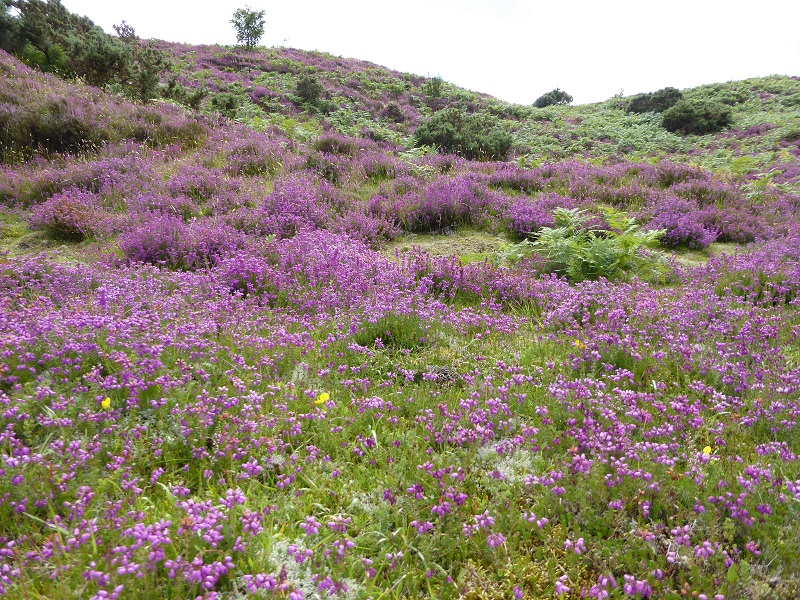 Murlough, County Down. Photo J.Harding.
Murlough, County Down. Photo J.Harding.
On 5th August BCI was at Murlough, County Down with members of Butterfly Conservation Northern Ireland (BCNI) and the Belfast Naturalists’ Field Club. The Murlough is a unique coastal heath just north of the Mourne Mountains which provide a stunning backdrop to the ancient dunes, adorned with deep purple Bell Heather. It is renowned for its butterflies too, and is perhaps the best site in Northern Ireland. We spent the full day there, lunching in the sun at the stable block. We saw the common butterflies especially on the buddleia at the stable block while on the dunes and grassland we found Small Coppers, Dark Green Fritillaries, Marsh Fritillaries (larvae), Graylings, Meadow Browns and Small Heaths. Sadly, there were no Walls, sadly now believed to be extinct in this part of Ireland. We express our thanks to BCNI for the invitation and warm welcome.
We will shortly have our events programme for 2018 on the BCI website. See you in 2018.
Crabtree Reserve Report 2017
| Species | 2011 | 2012 | 2013 | 2014 | 2015 | 2016 | 2017 |
| Dingy Skipper | 17[11] | 31[28] | 33[28] | 23[23] | 42[33] | 13[13] | 23[20] |
| Green-veined White | 49[45] | 41[26] | 106[86] | 58[40] | 46[38] | 11[03] | 14[10] |
| Orange-tip | 45[41] | 11[11] | 14[10] | 25[07] | 14[11] | 11[08] | 03[02] |
| Large White | 01[00] | 01[01] | 01[01] | 00[00] | 02[01] | 00[00] | 01[01] |
| Small White | 04[02] | 04[02] | 11[11] | 23[19] | 16[11] | 02[02] | 04[02] |
| Cryptic Wood White | 00[00] | 03[02] | 01[00] | 09[06] | 05[03] | 08[08] | 06[05] |
| Brimstone | 14[05] | 36[14] | 53[21] | 44[26] | 58[32] | 56[19] | 47[23] |
| Common Blue | 81[74] | 68[61] | 54[52] | 60[46] | 65[62] | 13[09] | 39[36] |
| Small Copper | 18[17] | 23[10] | 17[08] | 08[02] | 17[07] | 16[01] | 08[05] |
| Red Admiral | 26[05] | 08[01] | 07[01] | 67[14] | 26[11] | 43[11] | 120[88] |
| Painted Lady | 00[00] | 01[01] | 02[00] | 01[01] | 03[02] | 93[54] | 20[09] |
| Small Tortoiseshell | 58[26] | 315[140] | 335[296] | 50[30] | 88[60] | 248[142] | 66[47] |
| Peacock | 22[13] | 168[53] | 233[123] | 111[79] | 76[30] | 212[56] | 241[128] |
| Dark Green Fritillary | 00[00] | 00[00] | 00[00] | 01[01] | 01[01] | 05[04] | 04[04] |
| Silver-washed Frit. | 01[01] | 04[00] | 07[03] | 22[08] | 03[01] | 14[06] | 14[07] |
| Marsh Fritillary | 15[09] | 19[08] | 41[25] | 92[83] | 32[17] | 14[09] | 17[10] |
| Ringlet | 185[125] | 154[104] | 550[405] | 685[519] | 277[212] | 238[183] | 295[209] |
| Wall | 01[01] | 01[01] | 02[02] | 06[02] | 01[00] | 00[00] | 00[00] |
| Speckled Wood | 07[03] | 49[04] | 38[08] | 30[06] | 15[03] | 36[18] | 46[23] |
| Meadow Brown | 62[48] | 180[126] | 303[250] | 204[149] | 183[140] | 124[91] | 118[76] |
| Small Heath | 88[70] | 122[100] | 231[199] | 229[155] | 131[109] | 48[62] | 61[51] |
| Large Heath | 01[01] | 01[01] | 00[00] | 00[00] | 00[00] | 00[00] | 00[00] |
| Site Total | 695 | 1240 | 2039 | 1760 | 1101 | 1208 | 1147 |
| Counts | 25 | 25 | 26 | 24 | 26 | 21 | 19 |
| Ave Temp Celsius | 15.64 | 16.40 | 17.69 | 17.50 | 16.15 | 18.19 | 16.80 |
The butterflies on Crabtree Reserve Lullybeg are counted by walking the transect route on part of the reserve from April to the end of September. These results are sent to the National Biodiversity Data Centre. Butterflies seen outside the transect route are counted separately. Both counts are reflected in the table; the figure outside the brackets represent all butterflies counted while figures inside the brackets are transect counts.
There were fewer counts in 2017 which almost certainly accounts for the totals being lower than four of the previous six years. There were only two counts in April and three in May accounting in part for lower numbers of some spring flying butterflies such as Orange-tip and Green-veined White. However, the Green-veined White showed in low numbers in its second brood in July, suggesting a small first brood. A butterfly that seems to show a genuine increase on the reserve is the Common Blue; this butterfly likes a lower, more open sward; the reduction of the sward height and density caused by the cattle grazing and mechanical disturbance in 2016 led to a rebound in its fortunes in 2017. Another butterfly in low figures, the Marsh Fritillary, is showing recovery following the onslaught of the 2015 fire. Sadly, we found no Wall Brown on the reserve in 2017. The demise of this once common butterfly throughout Ireland is alarming and recent interventions have not enticed it back. The Small Heath was down in numbers too, reaching its lowest level in six years 2011-2016. Again, the breaking down of the dense, rank sward should help this species which feeds on fine-leaved grasses.
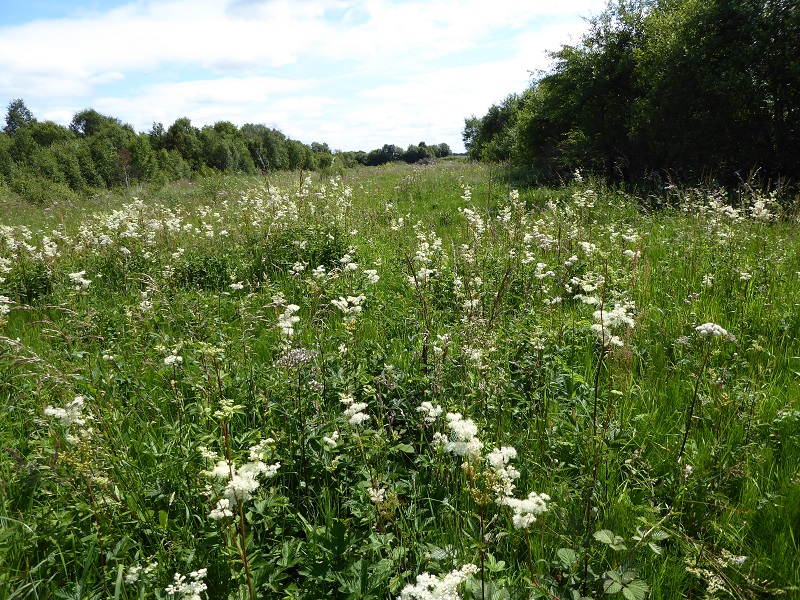 The south side of Lullybeg Crabtree Nature Reserve, cleared by machinery in 2016. Photo J.Harding.
The south side of Lullybeg Crabtree Nature Reserve, cleared by machinery in 2016. Photo J.Harding.
Two species that showed in record numbers in 2017 are the Peacock and Red Admiral. Small Tortoiseshell was down reflecting a bad September. Silver-washed Fritillary were in similar numbers to 2016 while Speckled Wood showed an increase. The Painted Lady showed its second highest numbers in the seven years but did not come near its bumper year in 2016. The Ringlet did well but again the Meadow Brown was not very successful, with only 2011 showing lower numbers. A positive sign is the return of the Dark Green Fritillary; both males and females were seen and it is hoped that the violets growing up through the taller grasses and at the edge of scrub will prove to be good breeding ground for this magnificent species. A female, believed to be laying eggs, was seen on violets on the southern side of the reserve.
Finally, we record our special thanks to our grazing donor and to Bord na Móna for assisting with sward reduction, and poaching and heavy scrub clearing and ground disturbance respectively in 2016, which helped to maintain the site’s habitats. We thank our members and friends for your work in scrub-cutting and uprooting. Ongoing management work is crucial to conserve this magnificent site, and the hard work is richly rewarded when we get to enjoy the butterflies there from March to October.
Conservation News
Conservation is a major part of our remit and 2017 saw important work. In February and November, a Butterfly Conservation Ireland (BCI) work party cleared scrub on grassland at Lullybeg to create the conditions needed for the Marsh Fritillary, Dingy Skipper and Brimstone. Scrub on the broad ride through woodland connecting Lullymore and Lullybeg was also cut back to ensure that the two excellent areas remain linked so that butterfly populations in the area do not become isolated. Our project site in the Burren at Fahee North, Co. Clare received attention with a scrub cutting day in late September near the centre of the site to make sure the area is not cut in two. Grazing took place on the site in summer. Grazing helps to maintain the high-quality habitats on this land.
Our recording scheme begun in 2013 continued in 2017. However, the website was hacked so badly it had to be reconstructed, which required considerable, currently ongoing effort. The closure of the butterfly recording scheme operated by the Dublin Naturalists’ Field Club meant that we received a great increase in the number of records, which is most welcome. Calls for conservation must be supported by good information which will help us to make the case for the conservation measures needed.
Our website was used to promote conservation throughout 2017. We reported through our Facebook page the inappropriate mowing at the height of the flight season of c.1km of flower-rich habitat at Ticknevin, County Kildare. Within 24 hours over 11,000 visits to this post were recorded, highlighting public anger at this senseless damage. Waterways Ireland contacted BCI to explain the context but this explanation was not accepted. BCI continues to liaise with Waterways Ireland regarding habitats associated with inland waterways. We met representatives of Waterways Ireland and Meath County Council to highlight the threat to areas of rich butterfly habitat between Enfield and Cloncurry and a design was agreed to avoid encroachment on the areas of high biodiversity value. BCI met the contractor and a representative of Meath County Council during the works to verify that the agreed design was being adhered to and resolve any issues arising. The result of this work is the creation of a hard surface that does not damage the breeding sites of the Dingy Skipper and Cryptic Wood White. However, the atmosphere associated with the waterway is, in our view, altered by the works and the bucolic gentleness associated with original grassy pathway is lost.
BCI also made submissions to three local authorities in Kildare, Laois and Carlow concerning Waterways Ireland’s plan to install hard surfaces along the Barrow and Grand Canal. BCI was involved in a vigorous campaign online and in the broadcast and print media, including The Irish Times in relation to this issue. The development will certainly remove valuable butterfly habitat, including an area use by a strong population of the Comma butterfly. The councils called for extra detail which Waterways Ireland has now submitted. We will examine this and make fresh submissions.
In 2015 The Department of Arts, Heritage and the Gaeltacht carried out a review of Section 40 of the Wildlife Act that deals with the closed season for hedge cutting and scrub removal and the season for burning vegetation in upland areas currently March 1 to August 31. We recommended retention of the closed season. Minister Humphreys ignored the advice of Butterfly Conservation Ireland and several conservation NGO’s and tried to change the law to allow hedge cutting in August and burning of vegetation in upland areas into March in the Heritage Bill 2016. Many moth larvae feed on hedges during August. During March many butterfly and moth larvae begin/resume feeding/basking on upland vegetation. BCI expressed its opposition directly to Minister Humphreys and wrote a submission concerning the impact of the proposed changes on butterflies and moths for BirdWatch Ireland to use in its campaign. The minister is having trouble in getting the legislation amended, a tribute to the opposition the proposals have generated. The controversial Section 8 of the Heritage Bill was discussed by an Oireachtas committee and an updated written submission restating our views was made in December 2017. We await the outcome of this committee’s deliberations.
BCI also made submissions to the Maynooth Biodiversity Action Plan, made a presentation in May at National University of Ireland Maynooth (NUIM) for Biodiversity Week on habitat creation for lepidoptera. BCI also met Dr James Carolyn from the Biology Department at NUIM and Stephen Seaman, the university groundman to advise on biodiversity improvements to the campus. Arising from these contacts, a wild flower grassland was sown. Acorns from the ancient oaks from Charleville, Tullamore were supplied to Stephen for sowing and eventual planting on college ground.
In December 2017 Jesmond Harding represented BCI at a meeting which discussed the ongoing work on the all-Ireland butterfly atlas in 2022. Butterfly Conservation Northern Ireland, the National Biodiversity Data Centre and members of the Dublin Naturalists’ Field Club acting in their own capacity were also present. We will meet again in early 2018 to discuss progress.
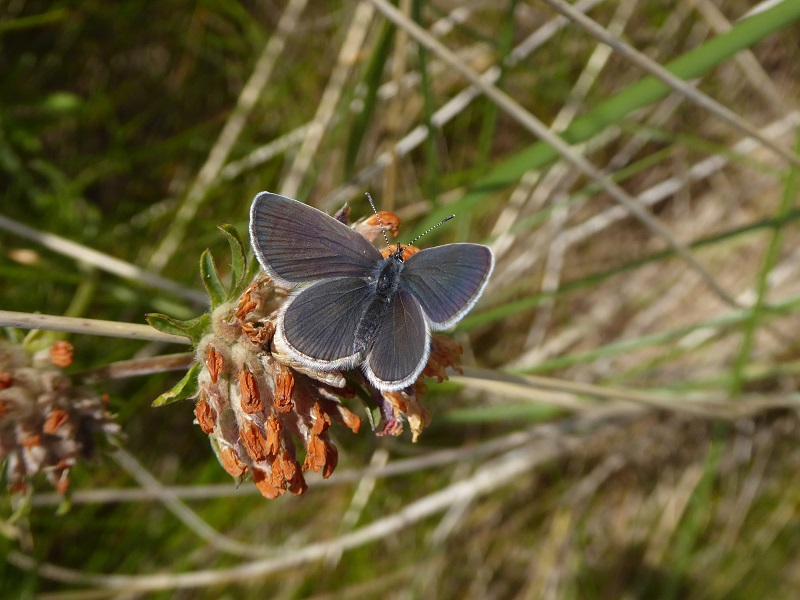 Small Blue, female basking on Kidney Vetch. Photo J.Harding
Small Blue, female basking on Kidney Vetch. Photo J.Harding
We conclude this review with a success story. In 2014 Small Blue butterflies were introduced to highly suitable habitat in County Meath. Most of the site that the butterflies were taken from has since been destroyed by coastal erosion. In June 2017 the receiver site was checked. The results have been excellent to date, with a thriving population now established there. It is heartening to see this endangered species benefiting from a helping hand.
Please continue your recording and conservation work in 2018; no matter how small your work may seem you can make a difference. Some man-made habitats, such as gardens, often contain a greater range of biodiversity than semi-natural habitats because of the diversity of habitats and micromanagement possible in a garden.
Finally, BCI thanks everyone who helped with our conservation work in 2017. Conservation is a battle for the preservation of everything that is good about our natural world and we greatly appreciate your commitment to the most elegant emblems of our natural heritage, our butterflies and moths.
Garden Survey Report 2017
Butterfly Conservation Ireland members and members of the public participated in our garden survey from March to November inclusive. The survey form, available as a download from our website www.butterflyconservation.ie and available by post on request asks the participant to record the first date each butterfly listed on the form was first recorded in their garden in each of the following three-month periods: March-May, June-August and September-November. In a final column, the highest number of each butterfly seen and the peak date is given. Finally, surveyors are asked to indicate which of the following attractants are provided in their gardens: Buddleia, butterfly nectar plants other than Buddleia and larval food plants. Twenty butterflies are listed for recording.
Comments received were not especially positive for 2017. No surveyor reported very high numbers; the highest number of butterflies counted in one day in 2017 was 28 (25 in 2016) down from 50 butterflies on one date in 2014. August and September did not see the numbers expected due to the rain during these months. Conditions improved late in September but the main flight season for most butterflies that visit gardens has passed at this stage. A notable feature was that reports of Red Admiral were up on previous years.
The total number of species recorded in the gardens surveyed was 15, up on 14 in 2015 and 2016, but down from 17 in 2014. The Green-veined White, Small Tortoiseshell and Peacock were recorded in all gardens while the Holly Blue, a species that likes to breed in gardens was reported by just four surveyors, with Michael Gray from Rathfarnham submitting 43 records of the butterfly. The species with the highest number of individuals recorded on a single day is the Red Admiral, with 25 recorded by Jonathan Shackleton. The lowest number of records were for the Wall Brown (not listed on the survey form) and an unidentified skipper, either the Small or Essex Skipper, at one each. These are very unusual garden species records for Ireland. Both were seen by Jesmond Harding.
The Large White and Small White were seen in all but one garden. The Large White had a good year overall in 2017. The Holly Blue numbers have not reached the numbers found in the early 2000’s up to 2007. The dates that the Holly Blue was recorded indicate that two broods were produced in the east midlands in 2016; Pat Bell recorded the butterfly on 08/04 (first generation), and on 13/07 (second generation). Elaine Mullin’s garden in Portmarnock on the Dublin coast recorded two broods and 66 individuals. Elaine recorded the butterfly from March to May (first generation) and July and August (second generation). No third brood Holly Blue was recorded in any garden in 2017, 2016 or 2013 but there was evidence of a third brood in 2014 and 2015. Jesmond Harding found the Holly Blue breeding on Alder Buckthorn plants on a south facing patio. No Cryptic Wood White, Brimstone, Common Blue or Silver-washed Fritillary butterflies were reported in gardens in 2017 or 2016. The Ringlet was found in a number of gardens in rural areas mainly, but in low numbers. The Ringlet’s companion, the Meadow Brown, was found in higher numbers in our gardens while the Speckled Wood occurred in more gardens but in lower numbers than the latter which is typical for a territorial species. The Painted Lady featured in a number of gardens both urban and rural. The Red Admiral continued to favour flower and fruit-rich gardens. The highest number of Red Admirals reported was 25 on 30 August, by Jonathan Shackleton.
The earliest garden record was of the Small Tortoiseshell on 15/03 (recorded by Paul Cutler, County Carlow and Jesmond Harding, County Meath). The latest was the Red Admiral on 17/10 by Pat Bell, County Kildare. The urban/suburban garden with the highest number of species recorded was that of Pat Bell in Maynooth with 12 butterfly species; the highest for the rural gardens was Jesmond Harding’s with 15 species. Other interesting records were of dragonflies and moths with Pat Bell recording Brown Hawker and Migrant Hawker dragonflies and Cinnabar, Hummingbird Hawkmoths and Silver Y moths in his garden. Ann Baskett had a beautiful Brimstone moth on a brick wall.
Gardens that provide both larval food plants as well as nectar sources had significantly higher numbers of species than those that provided nectar only. This finding is important because it suggests that butterflies can use gardens for their full life cycle, and that gardens have a role to play in conservation. Growing Stinging Nettles, cabbages, Common Bird’s-foot-trefoil, Lady’s Smock and wild grasses in sunny, sheltered conditions is a great draw to butterflies and moths. Growing Alder or Purging Buckthorn, Common Holly and native ivy will enrich the species count and numbers further. One may really be inspired to go still further by offering bruised over-ripe plums or dates which Red Admirals find irresistible.
Gardens with Buddleia had high numbers of butterflies, and the plant is especially attractive to the Large White, Small Tortoiseshell, Peacock and Red Admiral.
We appeal to gardeners not to grow invasive non-native flowers, no matter how attractive these are to insects. It is worrying to see the damage to natural habitats being done by non-native plants like Red Valerian, Montbretia and the various cotoneaster species. These are invasive plants that overwhelm natural vegetation and the problems that they cause can be seen in parts of the Burren, the sand dunes at North Bull Island, Donabate, Baltray and elsewhere. Finally, we make a plea to all gardeners to avoid the use of chemicals in the garden. Although this is not fully proven there is strong evidence that pesticides may be killing huge numbers of insects, even non-target species. Water soluble chemicals that are absorbed into plant tissues make their way into pollen and nectar, affecting bees, moths, butterflies and other insects that visit flowers. Let your garden be a genuine wildlife garden where give-and-take prevails, and where your wild creatures are safe from poisoning.
Get Involved
We hope to expand the garden recording scheme further in 2018. Our website www.butterflyconservation.ie contains information about butterfly gardening; click on the “Butterflies” tab and select “Gardening for Butterflies” for details. The survey form can be downloaded from here but if you need a hard copy please request one by emailing us at conservation.butterfly@gmail.com or by letter to Butterfly Conservation Ireland, Pagestown, Maynooth, County Kildare. If you have any doubts about the identity of any butterfly check our Gallery by clicking on the “Butterflies” tab. Thank you for taking part in the scheme and please continue your recording. Recording begins again in March and here’s hoping for a good season in 2018.
Red Admiral Mark and Release Project in Pat’s Garden 2017
By Pat Bell
Background
I always get Red Admirals in my garden at the end of summer but the last three years saw quite a jump in numbers. I grow a lot of fruit and they particularly like hanging around in the fig tree in my back garden and they love the windfall plums which I have been putting out for them in recent years. One question which recurs for people like myself who encourage and delight in butterflies in their gardens is, am I seeing the same individuals? Recent individuals to catch my attention were one late ‘hanger-on’ last autumn and one pristine specimen which appeared in my conservatory in May this year. The only way to answer this question as far as I could see was to catch and mark some and see what happens.
Another incentive was on learning of the Red Admiral migration project being undertaken by Marco Thoma of the University of Bern (www.insectmigration.wordpress.com/red-admiral-migration/). Our National Biodiversity Data Centre (NBDC) was one of the first partners to sign up to this project and will forward data to Marco. With this in mind I uploaded five years of my garden records (2012-2016) which was gratefully acknowledged by both parties.
Catching
Red Admirals started turning up in mid-June which was a good two months earlier than usual. They were mainly occurring on the summer buddleia in my front garden so I started catching them with my regular butterfly net and marking them with highlighter pens. I then acquired a butterfly trap and a set of marking paints from wildlife and ecology specialists NHBS. I set it up with a tray of bait in my back garden on 12th July.
There are numerous recipes out there for baiting traps many involving concoctions of bananas, molasses and maybe even a shot of rum. However, as I started having immediate success with overripe bananas I just stuck with soft fruit. I supplemented these with figs when they became available and these always prove irresistible to Red Admirals. Interestingly, they didn’t attract their Irish Vanessid cousins Peacocks or Small Tortoiseshells. I observed very few escapees as their tendency was to fly up to the top of the trap where they would roost in the evening if I hadn’t removed them.
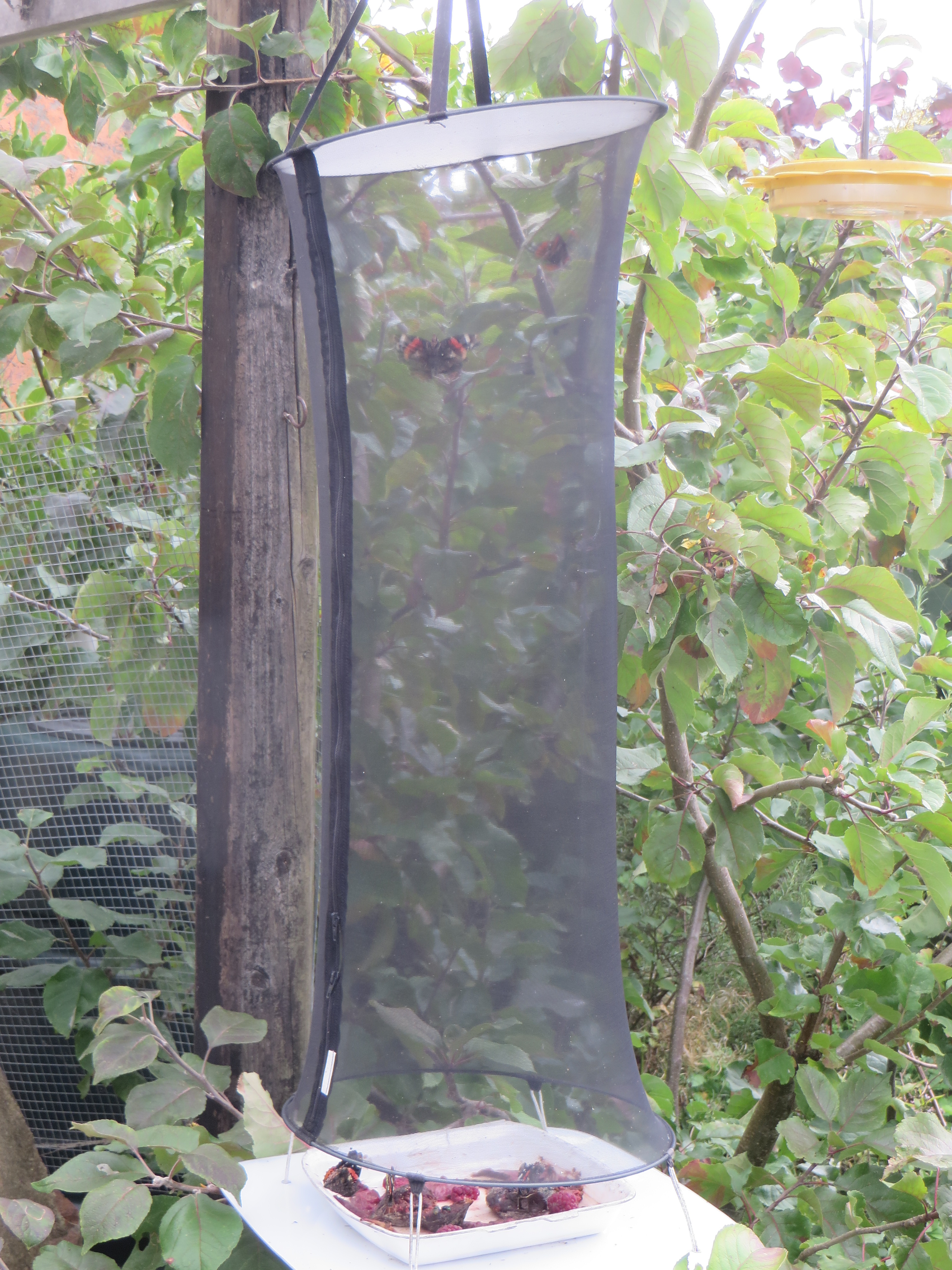
Marking
There are numerous marking systems possible. Marco Thoma simply stained the white tips of the forewings using different colour codes in September 2016 at two Alpine passes through which Red Admirals migrate southwards. He informed me that they’re not using country codes but are planning to use numbered tags for autumn 2017. Matthew Oates in his book ‘In Pursuit of Butterflies’ makes reference to the clock method whereby each butterfly is given its own unique number by placing two small dots on the wing undersides. I opted for applying unique numbers to the underside of both wings using marking paint. I also started using a different colour each week to facilitate identification from a distance and I recorded and photographed every individual before release.
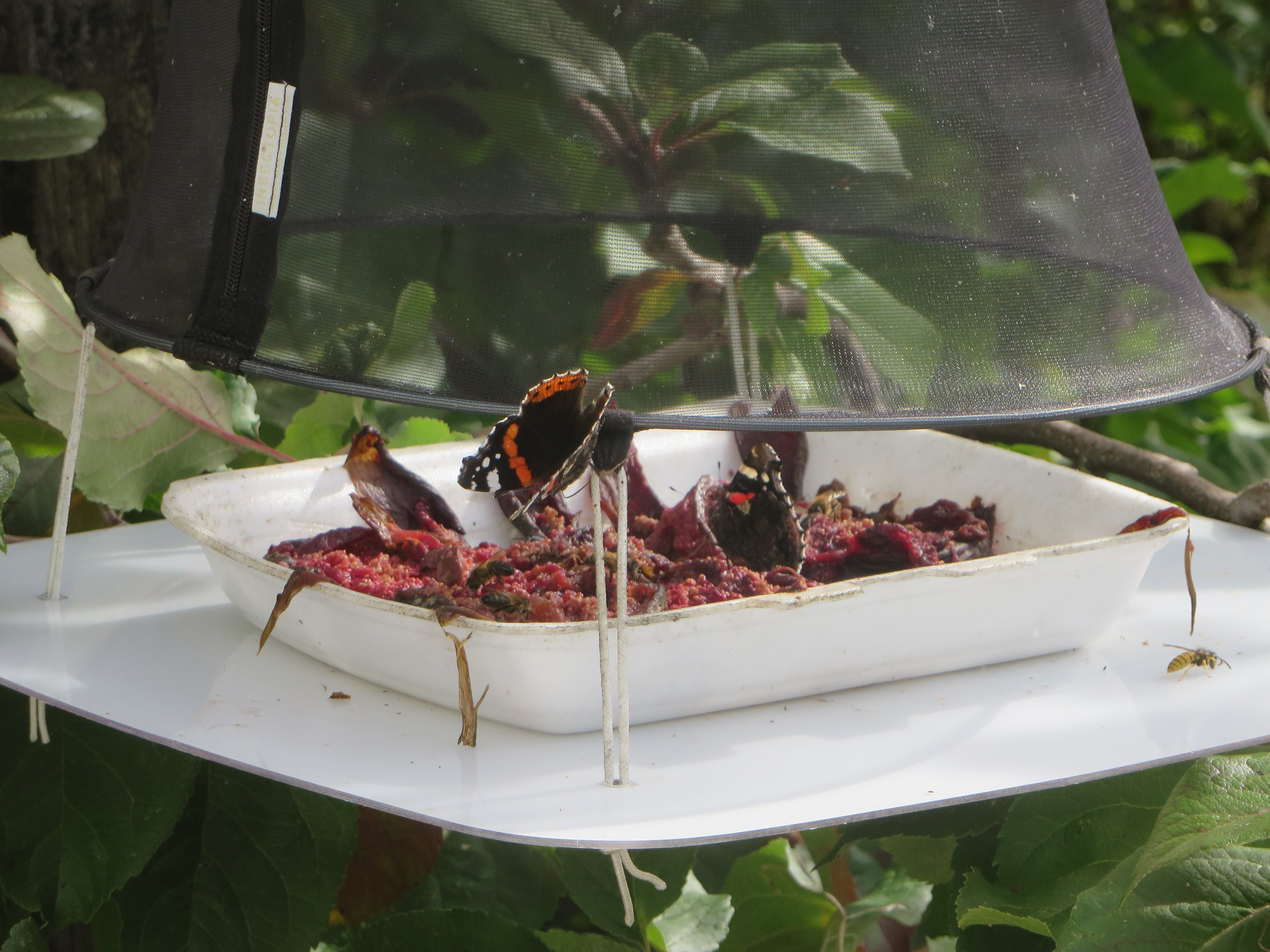
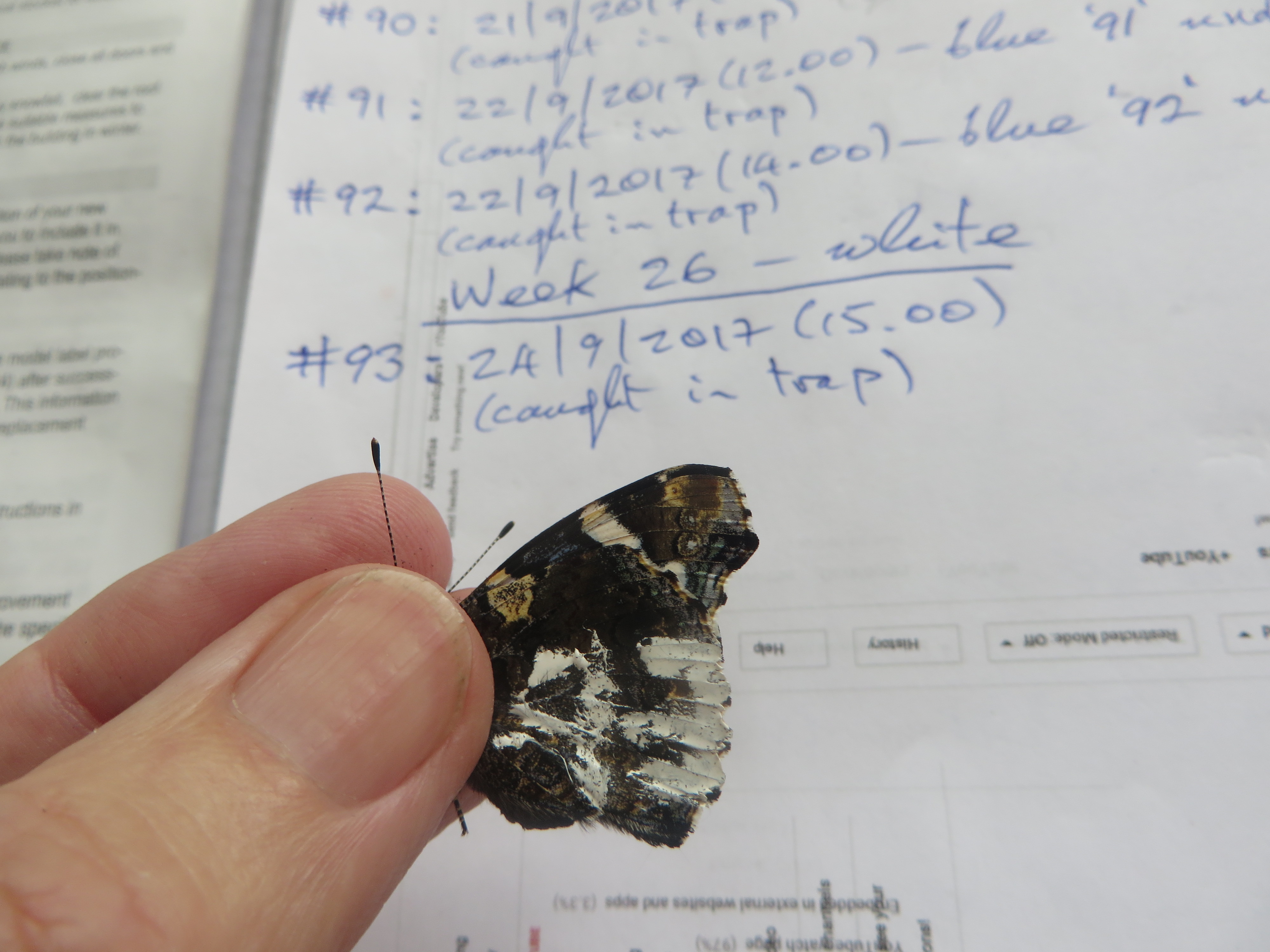
Releasing
I released them into my conservatory with a view to giving them an opportunity to recover from any trauma although in reality it didn’t seem to bother them too much. They were free to leave the conservatory through open windows and vents and the door was open a lot during the day. My observations were that if they were released earlier in the day then they would generally depart that day. However, if released later in the day or if the weather wasn’t great then they would typically stay one night in the conservatory before departing the next day if the weather was favourable. When overnighting they tended to roost on the underside of a vine leaf or on a bunch of grapes.
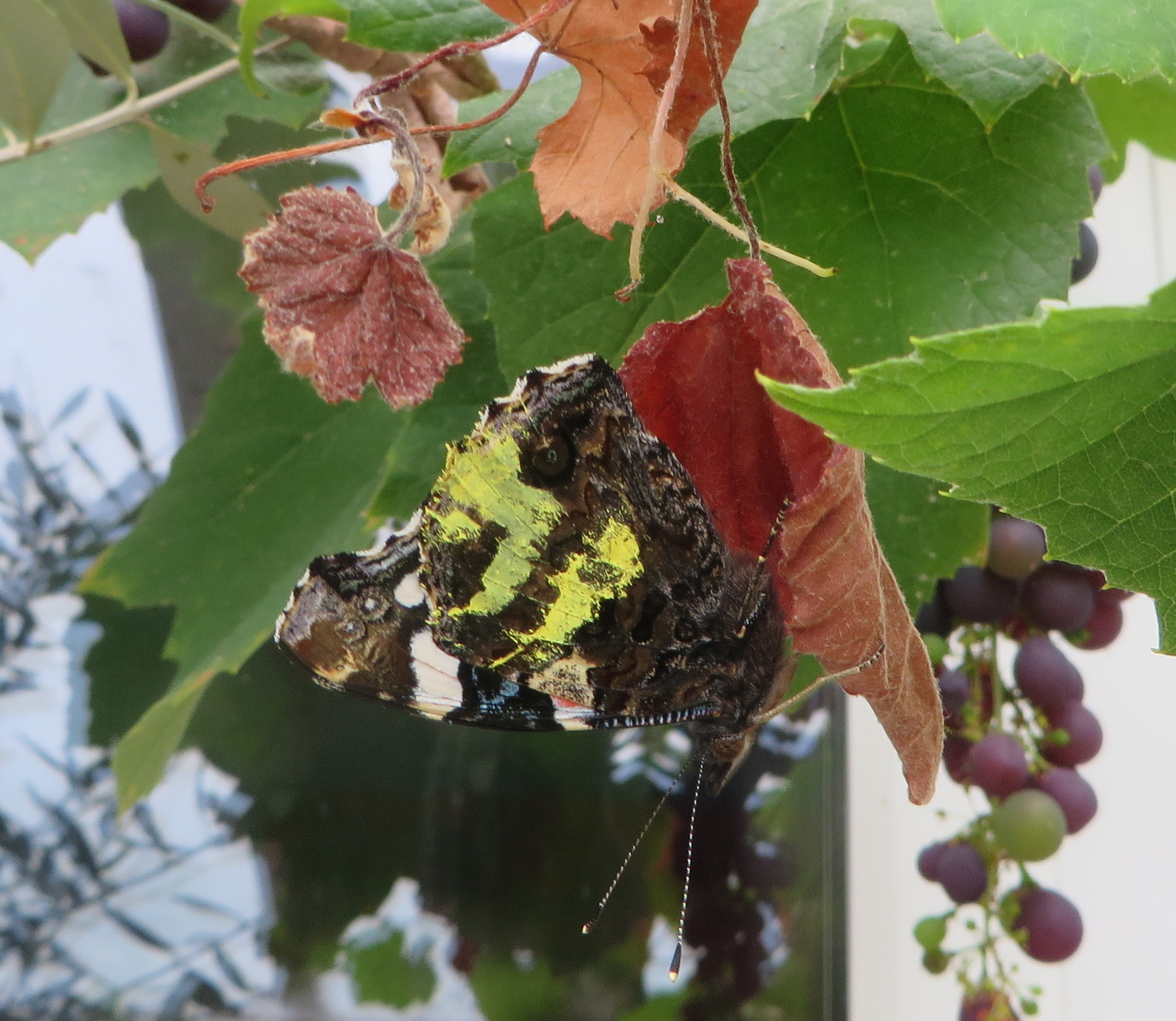
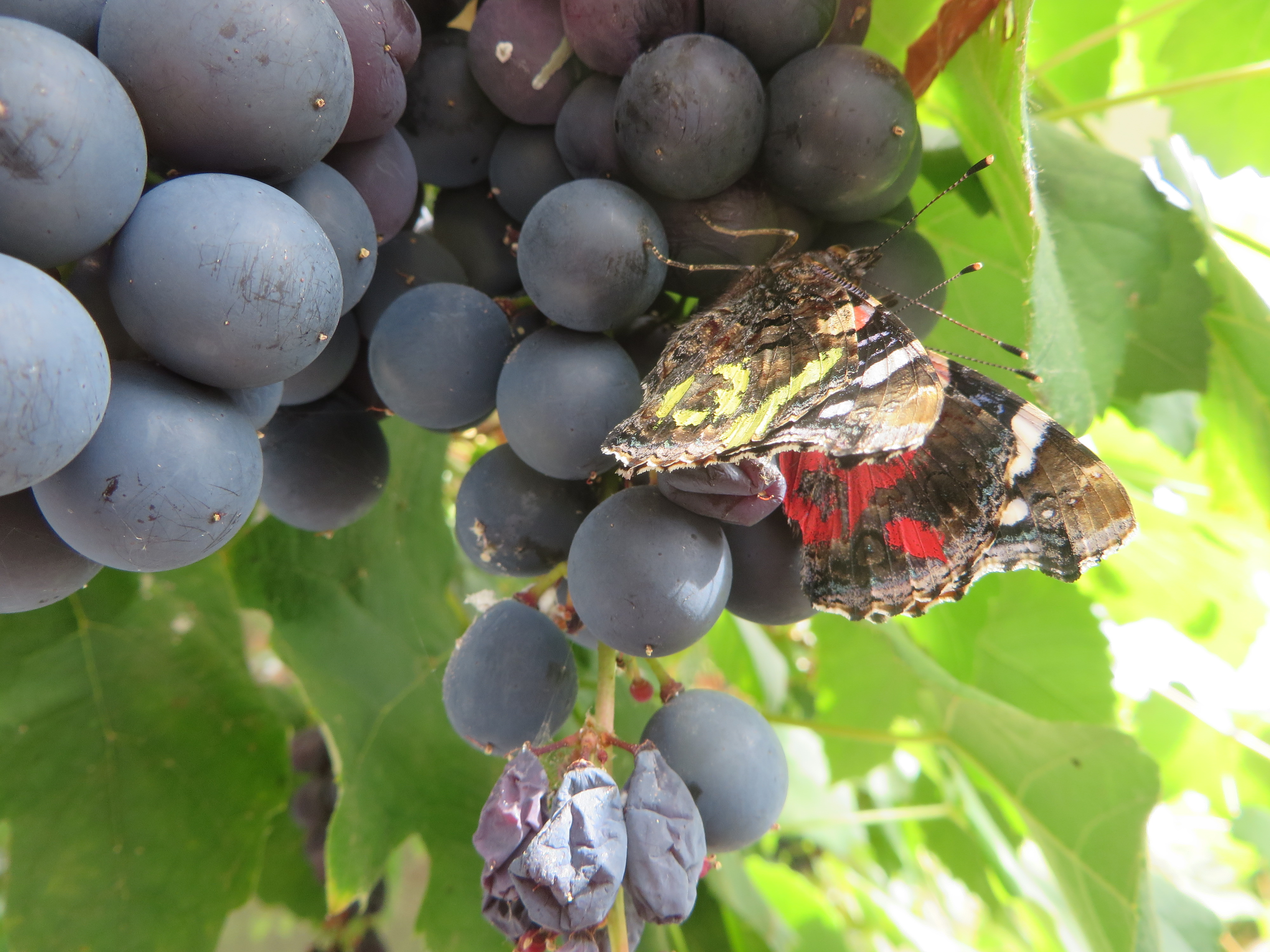 Released Butterflies. Photo Pat Bell.
Released Butterflies. Photo Pat Bell.
Results
In total I caught and marked 95 individuals; the most in one day was seven on 8th September; the most in one week was 16 in Week 23 (2-8 September). The AM:PM split was 56:44 but, as I was more likely to be around before midday (GMT), I don’t think this is significant. Of the 95 caught, I only recaught two not counting the occasional one that went straight back into the trap on release. This was the most outstanding and surprising aspect of the whole exercise from my point of view.
I count butterflies in my garden every year using Birdwatch Ireland’s methodology whereby each week I take note of the highest number of butterflies of each species that I see. Using this methodology, the highest total of Red Admirals recorded in my garden was 42 in 2016 with over 80% of this occurring in four weeks from mid-August. I estimated 62 for 2017 using the same methodology, with over 80% occurring in nine weeks from late-July. This is well short of the 95 actually caught. There are various methods for estimating population size using mark and recapture techniques but they don’t apply directly to my exercise as I wasn’t taking a rigorous scientific approach. Nevertheless, as smaller recapture rates indicate larger estimates of population size, I think my results point to a much larger population of Red Admirals in the vicinity of my garden than counts would indicate.
Conclusions
I didn’t expect to catch so many, although it was an exceptionally good Red Admiral year, and I didn’t anticipate the extremely low recapture rate. It was quite time consuming and most of the activity seemed to occur when the sun came out just as I was just about to go to one of my transects! If I do it again in 2018 it will be a reduced effort with minimal recording and photographing and I will just use a simple colour marking system as the numbers recaptured were extremely low.
Garden Moth Survey
By Don Hodgers.
Butterfly Conservation Ireland runs its own National Garden Butterfly Survey Scheme the findings of which are described in this report. Our mainly nocturnal moths need to be surveyed too and the garden at Butterfly Conservation Ireland’s registered office is used to survey moths. In this article Don Hodgers, the Irish co-ordinator of a survey that is run in Britain and Ireland describes the aims of this survey and calls for new entrants…
The Garden Moth Scheme is a Citizen-Science project that involves a systematic survey of common garden moths, carried out once a week. The main survey runs from March to October but some recorders also take part in a winter survey from November to February. The survey started in 2003 in the UK and there are now some 317 gardens surveyed throughout the UK and Ireland. Ireland became involved about ten years ago, and after a slow start, twenty-four sites are now involved. The aims of the survey are to increase interest in our common moths, to study trends in their density and distribution, to build up a database of records and to make this database available for study by researchers. The 2013 report on ‘The State of Britain’s Larger Moths’ showed worrying declines in the numbers of moths, with iconic species such as Garden Tiger, Arctia caja, declining by 92% over forty years and Double Dart, Graphiphora augur, by 98%. Other species, however, have benefitted from recent climatic and other changes – Blair’s Shoulder-knot, Lithophane leautieri, first recorded in Ireland in 2002, increased by 7,878% over the same period. Change is happening to our garden moths – the Garden Moth Scheme is helping to document that change.
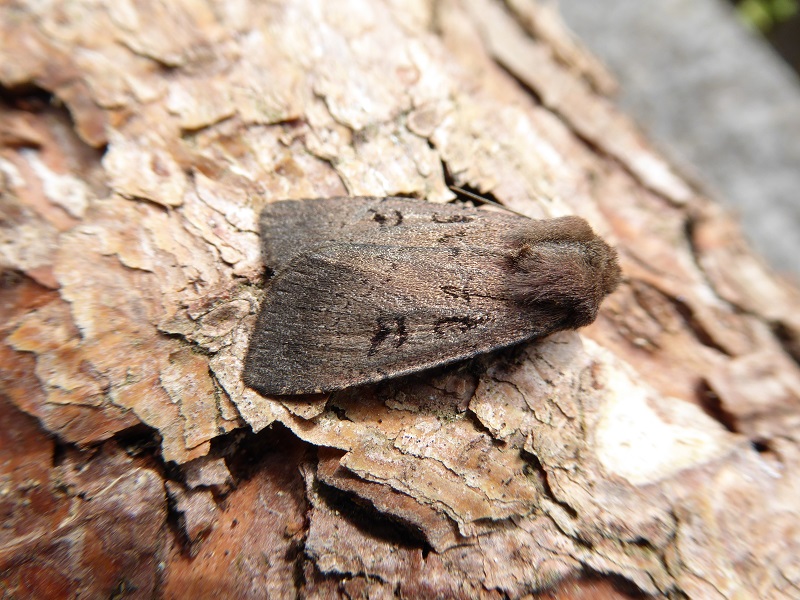 The Double-dart declined by of 98% over forty years according to a 2013 report. Photo J.Harding.
The Double-dart declined by of 98% over forty years according to a 2013 report. Photo J.Harding.
And more recorders are needed to help do that work! At present Co Dublin has five GMS sites, Antrim, Louth and Wicklow have three each, Leitrim and Westmeath have two each, and Cork, Derry, Donegal, Fermanagh, Mayo and Meath have one site each. So all but one of the present set of recorders are based north of a line from Mayo to Wicklow.
Not all of our garden moths are tracked in the survey – only about 230 of the most familiar and relatively easy-to-identify species. In this way, the survey is suitable for all recorders from beginner to experienced. And identification help is available. Most recorders in fact, do choose to record a supplementary list of the other species that they obtain.
2017 was not a vintage year for moths, but nevertheless Irish participants gathered some eight thousand records, involving over twenty-eight thousand moths in the summer GMS survey. In addition, 1,300 records of non-GMS species were reported, involving three thousand other moths. As well as the common species, some scarce moths turned up during the year, including two Lime Hawk-moths, Mimas tiliae, following on from an earlier GMS record, and Ireland’s only record so far of Ruddy Streak, Tachystola acroxantha. Thanks is due to all the GMS recorders for this great effort.
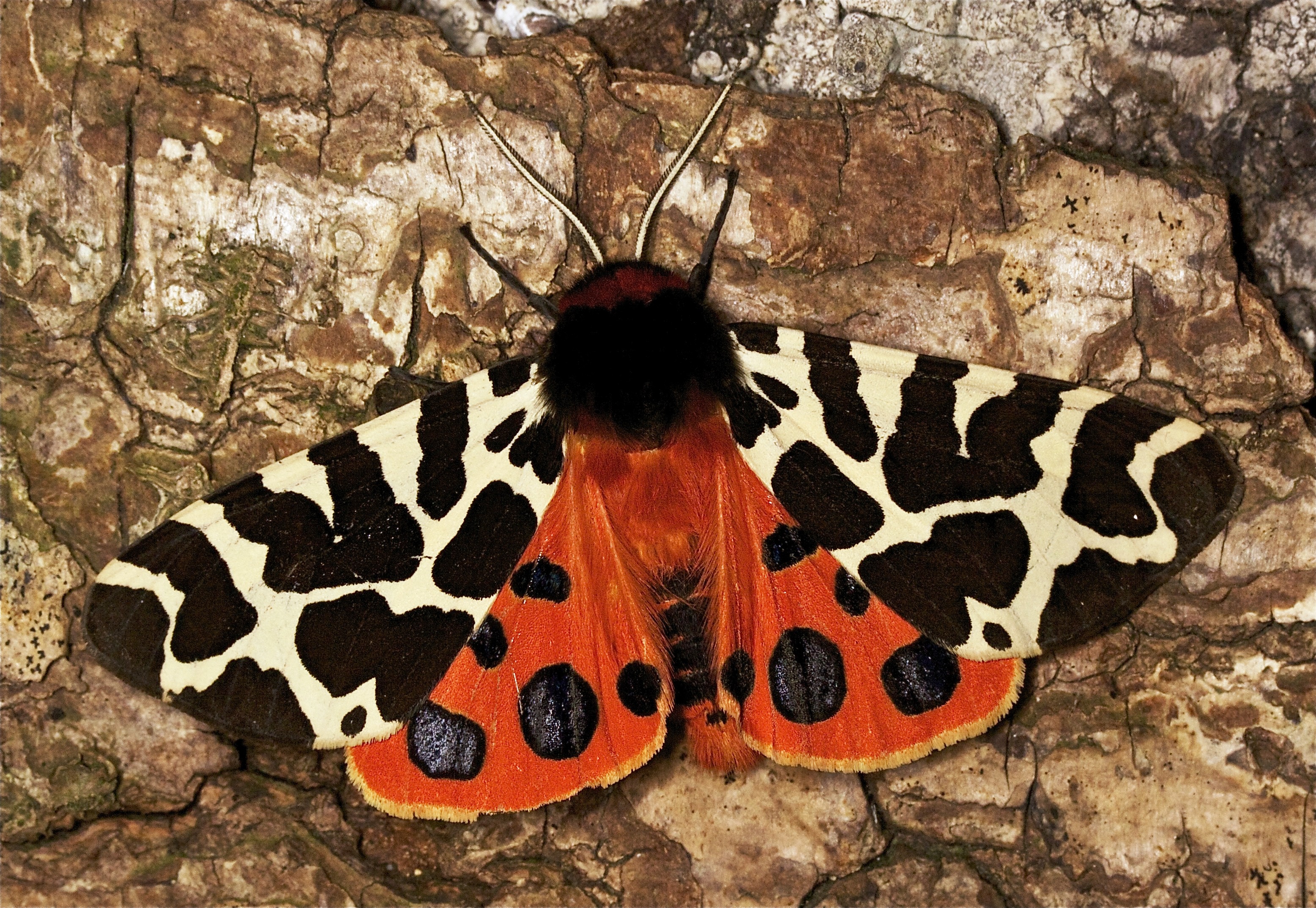 Garden Tiger. Photo Don Hodgers
Garden Tiger. Photo Don Hodgers
But it’s not a competition to find out who has the best garden or the most moths, or the scarcest species. All the information helps to paint the picture – from small urban patches to gardens in prime rural habitat. What is important is the regular, sustained effort, so that even empty traps, often the case in winter and early spring, provide important data. Records are then centralised, processed and made available for study, and an interim analysis is reported to recorders. Scientific papers, based on the data, have been published on habitat and climatic factors, and another on the role of artificial night-time lighting is in preparation.
There are many non-GMS recorders out there who regularly trap in their gardens anyway, and who would be most welcome to join the scheme. And help is always available for those just starting out. Researchers today in many fields of science are very grateful to those in the past who took the time and trouble to record and submit their findings. GMS recorders today are building up a valuable database for future researchers and we can be sure they will be very appreciative. It can be disappointing at times to find empty traps, but then again there are so many more wonderful mornings to keep us hooked! Further details, including contact details, are available on the GMS website at http://www.gardenmoths.org.uk/
Hedge Brown Pyronia tithonus
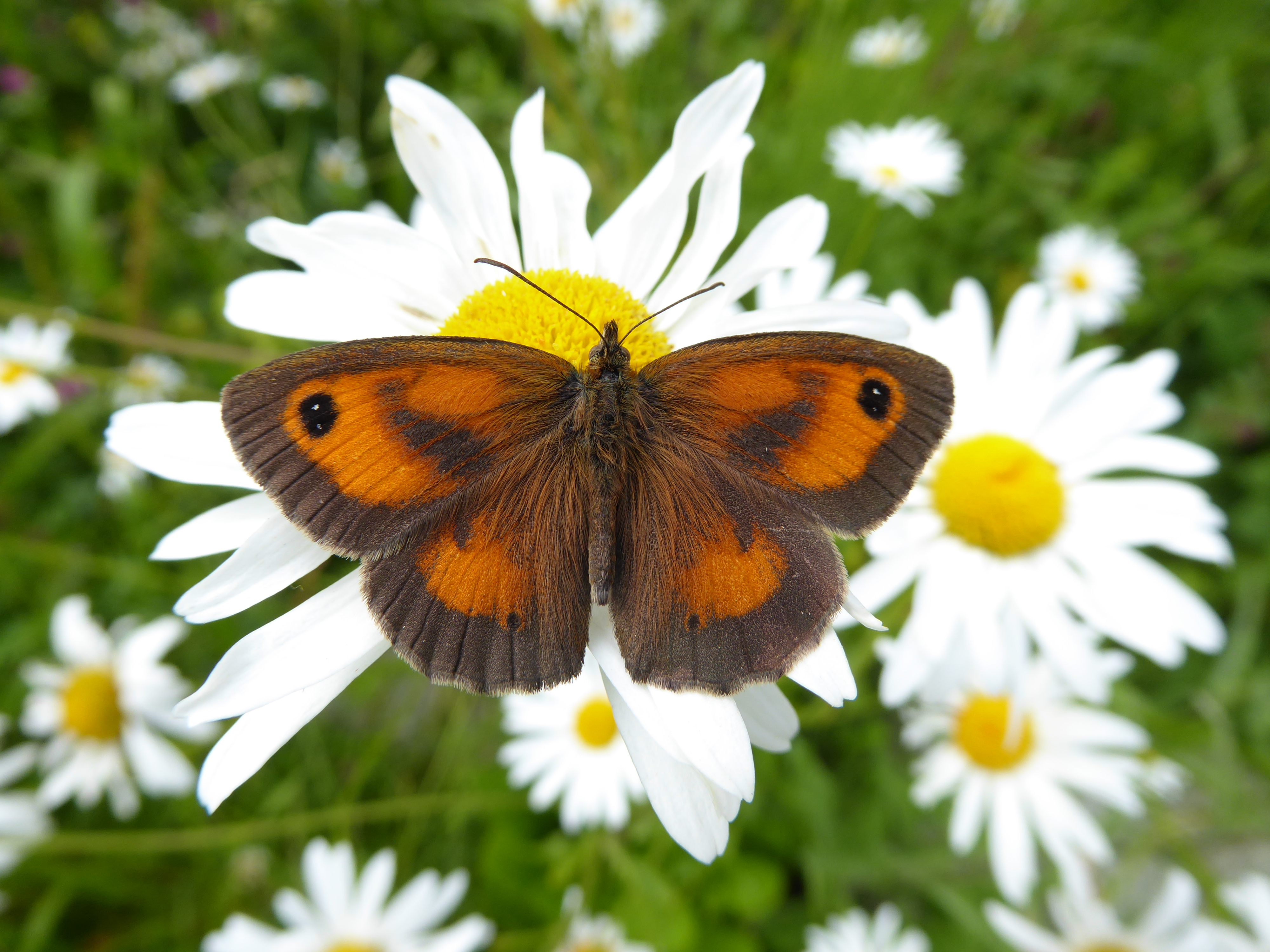 Male Hedge Brown (bred specimen) basking on Ox-eye Daisy.
Male Hedge Brown (bred specimen) basking on Ox-eye Daisy.
DESCRIPTION: The Hedge Brown butterfly is also called the Gatekeeper. Its upperwing surfaces are brown with rich orange patches. The female’s forewings have a clear, large orange patch, while the male’s forewings have a clear brown patch containing androconia (scent scales) extending into this orange patch from the base of its forewing. The male is noticeably smaller, measuring 44mm across the forewings, while the female can measure up to 48mm. In overall appearance it resembles a Meadow Brown but is noticeably smaller and brighter.
HABITAT: The species is nearly always associated with scattered scrub, bracken or native hedgerow with wild grasses growing at the edges. It also inhabits open woodland, like that found at The Raven, County Wexford. The sward used for breeding is typically well developed and lightly grazed, occasionally grazed or ungrazed but subject to some disturbance.
FLIGHT TIME AND BROOD STRUCTURE: It is on the wing from late July to early September.
BEHAVIOUR AND LIFE CYCLE: Males patrol along pathways near hedges or along hedges and turn at a certain point and retrace their flight path. It has a bobbing but somewhat erratic flight with the rich orange upper surfaces a prominent distinguishing feature. Despite being the more active sex, males appear to be highly sedentary; two males patrolled a five-metre length of hedge in my garden for four days before they dispersed or were predated. Females spend more time perching, basking and feeding on nectar. Despite flying less frequently, females probably move longer distances. On warm, sheltered sites they can reach enormous numbers, feeding during hot conditions on Creeping Thistle, Common Ragwort and bramble. They often congregate to feed on flowers growing at a break in a hedge or where a long hedgerow with flowering bramble ends and is adjoined by tall wild grassland. The butterflies vanish when the sun disappears and seek out the underside of bramble leaves. When heating up after a cloudy period, both lateral and dorsal basking is used.
Egg laying is inconspicuous, and one reason is that eggs are simply ejected in flight. They are dropped where grass clumps adjoin patches of scrub or hedgerows. However, sometimes eggs are placed very carefully but unobtrusively; on 28th July 2015 I observed egg-laying on sand at the base of a fescue grass, either Sheep’s Fescue or Red Fescue. The female crawled slowly to the foodplant, curved her abdomen near the base, laid an egg, moved a short distance, repeated this procedure and flew away. The ovum is very small; pale cream, barrel-shaped and non-adhesive. Three eggs were found on dry, dead blades at base of Sweet Vernal Grass Anthoxanthum odoratum, and one on a green stalk at base of this grass. No eggs were laid on or near False Brome Brachypodium sylvaticum.
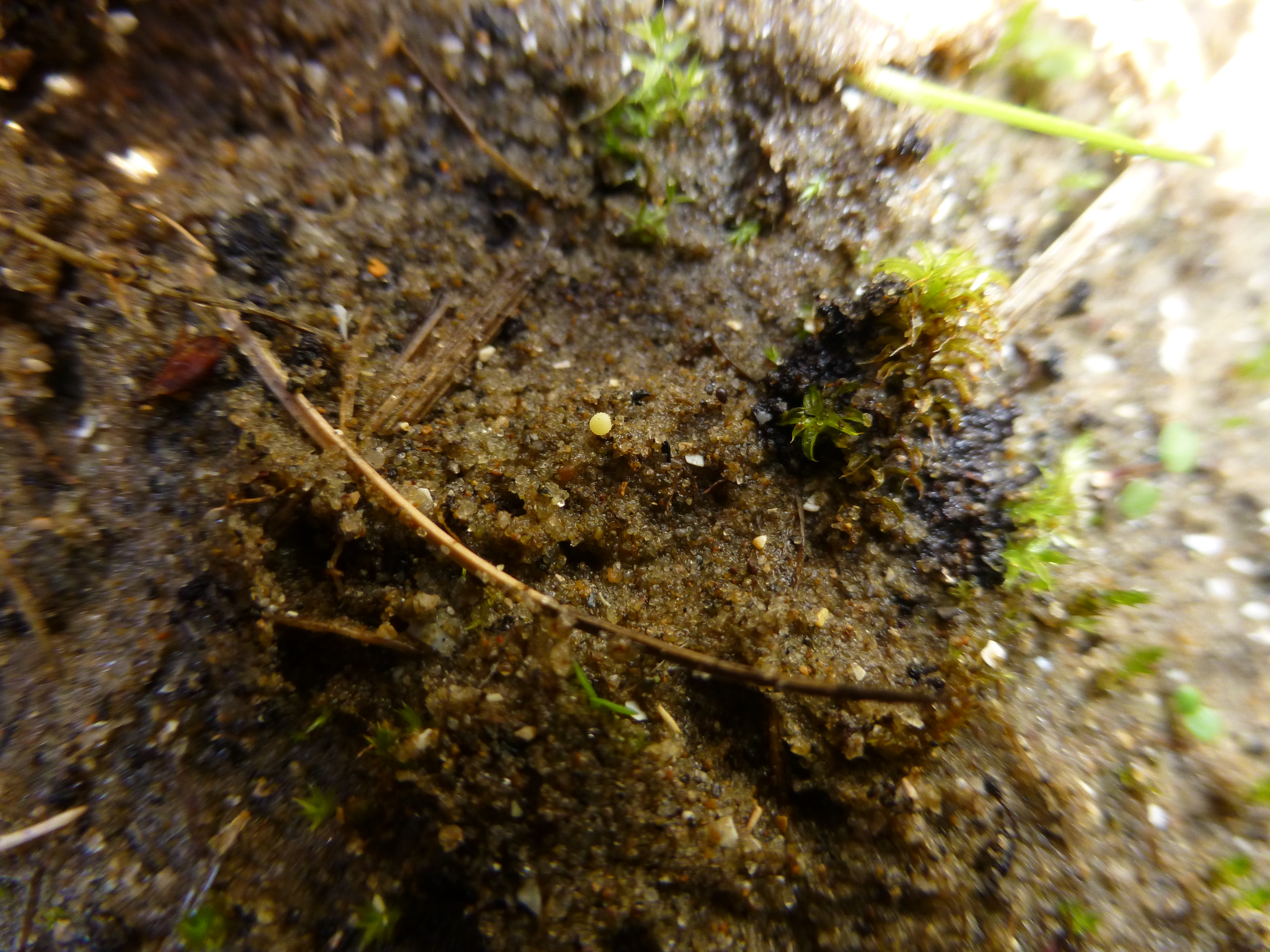 Hedge Brown egg.
Hedge Brown egg.
The egg stage observed lasted c.13 days. The larva eats the egg shell. Feeding during the day occurred during the autumn even during cold (4C) but sunny conditions. The second instar larvae fed on the tender tips of the grass blades. On 20th December a larva that was observed feeding outdoors during sunny, breezy conditions (10C) measured 8mm. At this stage it was green with bristles prominent on head and body. The head was pale brown with a darker brown blotch near the biting mouth parts.
No activity was observed between 20th December and 6th March 2016 when feeding resumed. On 11th March 2016 a larva observed measured 6mm, suggesting some shrinkage arising from its long fast. From mid-April feeding was strictly nocturnal, no doubt to reduce the chances of predation from birds. During the day larvae rest at the base of grass tussocks.
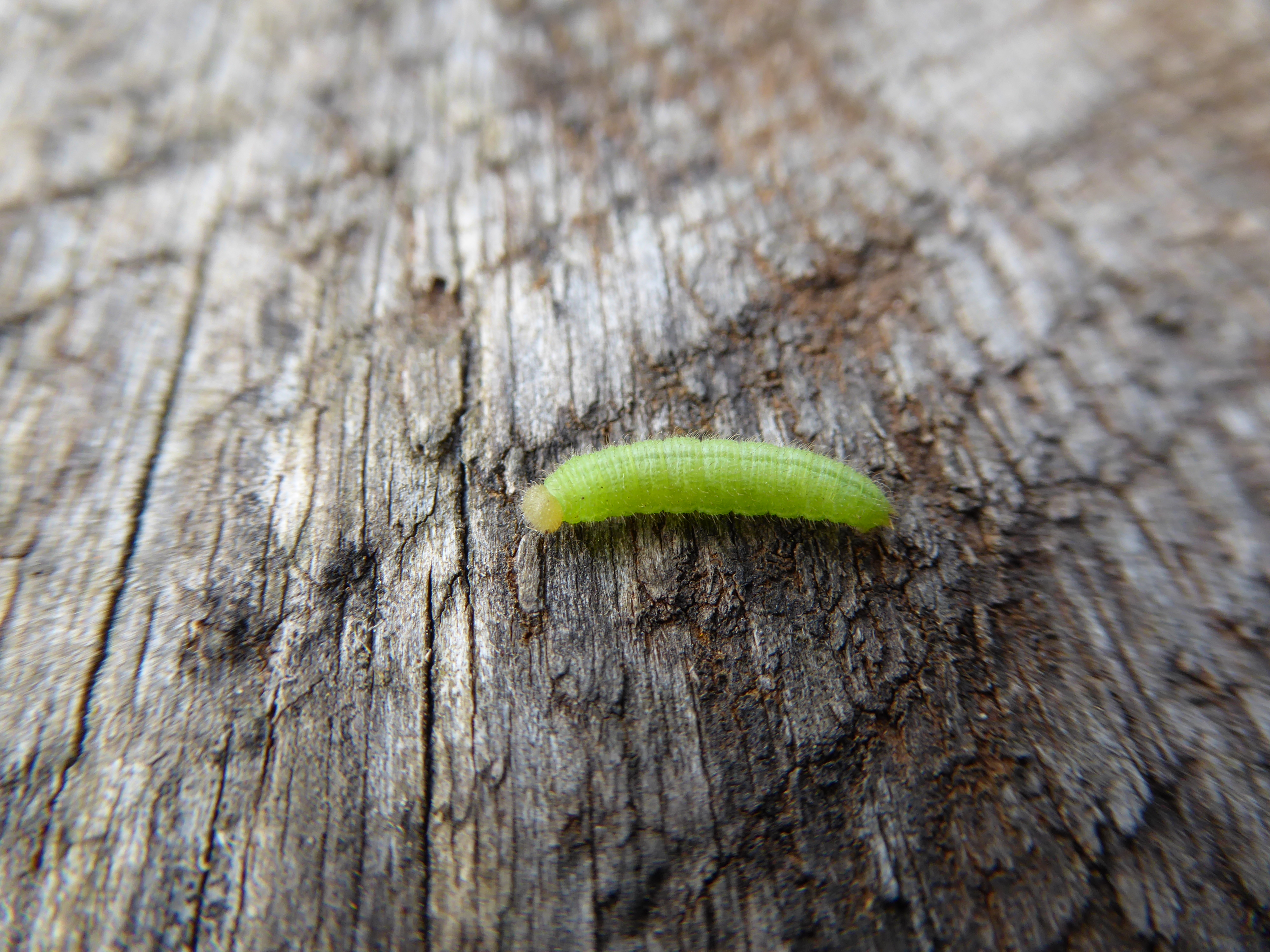 Fourth instar Hedge Brown larva.
Fourth instar Hedge Brown larva.
On 15th April larvae measured 10mm; the body was mid-green, covered in white bristles with a darker green dorsal stripe and a white lateral stripe extending to and almost continuous with white anal points. The head was pale olive-brown. On 16th April night feeding was observed in calm conditions with near freezing temperatures. Larvae blend superbly with the foodplant even when feeding at night.
At this stage larvae show a keen sensitivity to light levels, and begin to feed only when it is nearly fully dark. On 18th April one larva was seen at 9pm and three at 9:20 pm when it was nearly fully dark; the temperature was 9C. At 5am, when still dark, larvae were feeding but just before dawn the larvae descended to the dense base of the host-plants. As daylight levels increase larvae delay feeding until later in the night; on 26th April larvae began to feed later, at 10:30pm; while on 28th April larvae (one measured 12mm) delayed feeding until 11pm, feeding during a light, cold breeze with the temperature at 2C.
On 19th April eight larvae were observed; at this stage most were on Sweet Vernal Grass, a broad-bladed grass which provides more bulk than the finer-bladed fescues.
After an inter-moult stage lasting about six days (this is a long time for moulting larvae) the larvae were seen again on 9th May; these measured 12mm, these were now in the fifth and final instar. All had moulted from green to brown. According to Heath et al. 1990 both brown and green colour forms exist in the final instar.
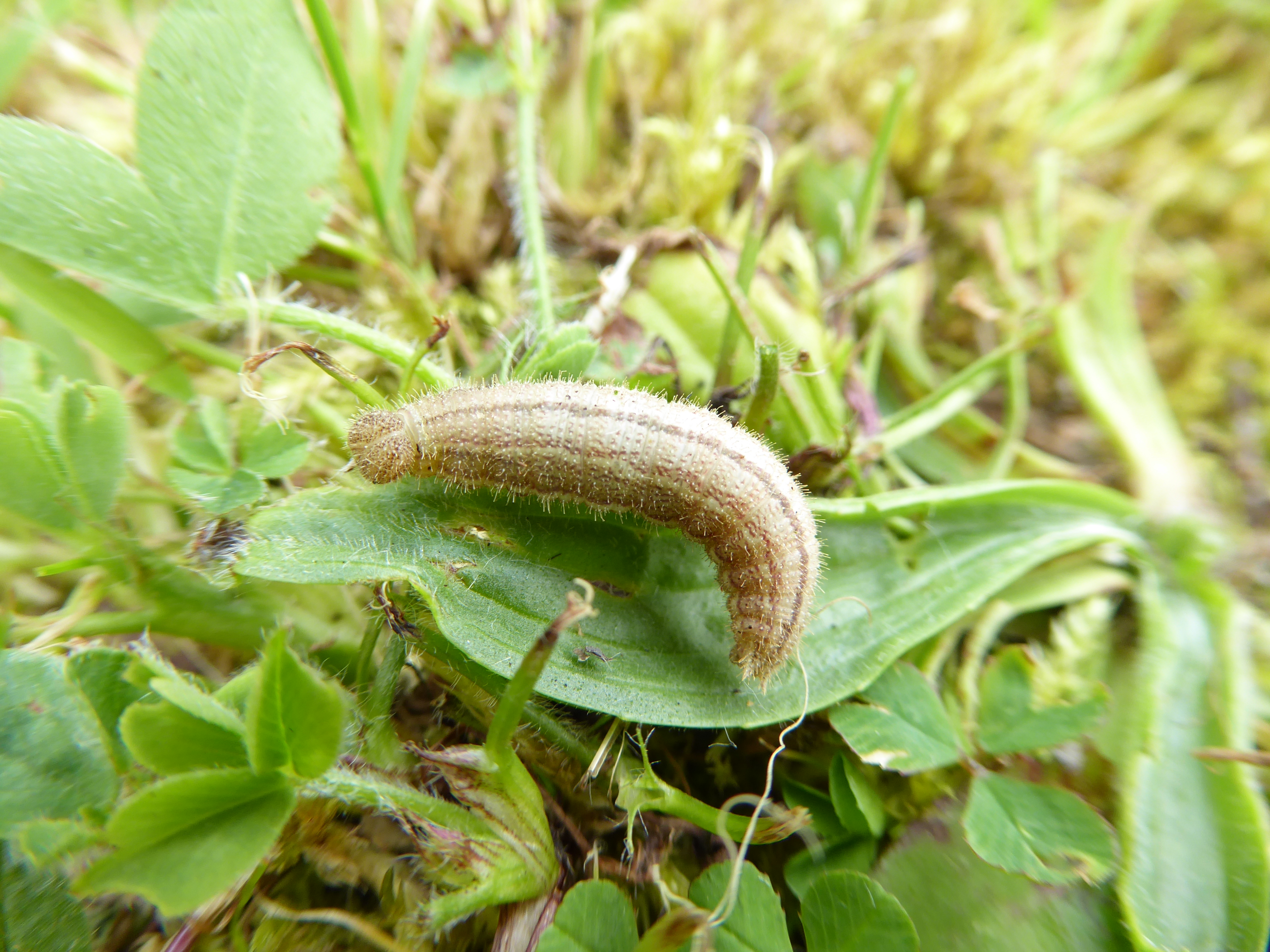 Fifth instar Hedge Brown larva.
Fifth instar Hedge Brown larva.
Fully-fed larvae reached 20mm when hunched up and 25mm when extended. When feeding, larvae are sedentary. Larvae still fed high up on foodplants; blades were eaten from the edge and tip. The pupation of the larvae occurred between 10th June and 20th June. The larval stage lasted c.310 days.
The pupae were found in two situations; attached head down to a dead grass stalk low down on the foodplant or loose on the soil. Overall the pupa is off-white with strong black streaks on the wing cases and thorax while the abdomen contains two parallel rows of black blotches. On the ventral surface the antennae are picked out in black and white while two parallel black lines are located on either side of the thorax. The pupa has a dumpy appearance. Its colouring allows it to blend in with the bleached senescent grass tussocks. The pupae were 10-12mm in length and showed no mobility.
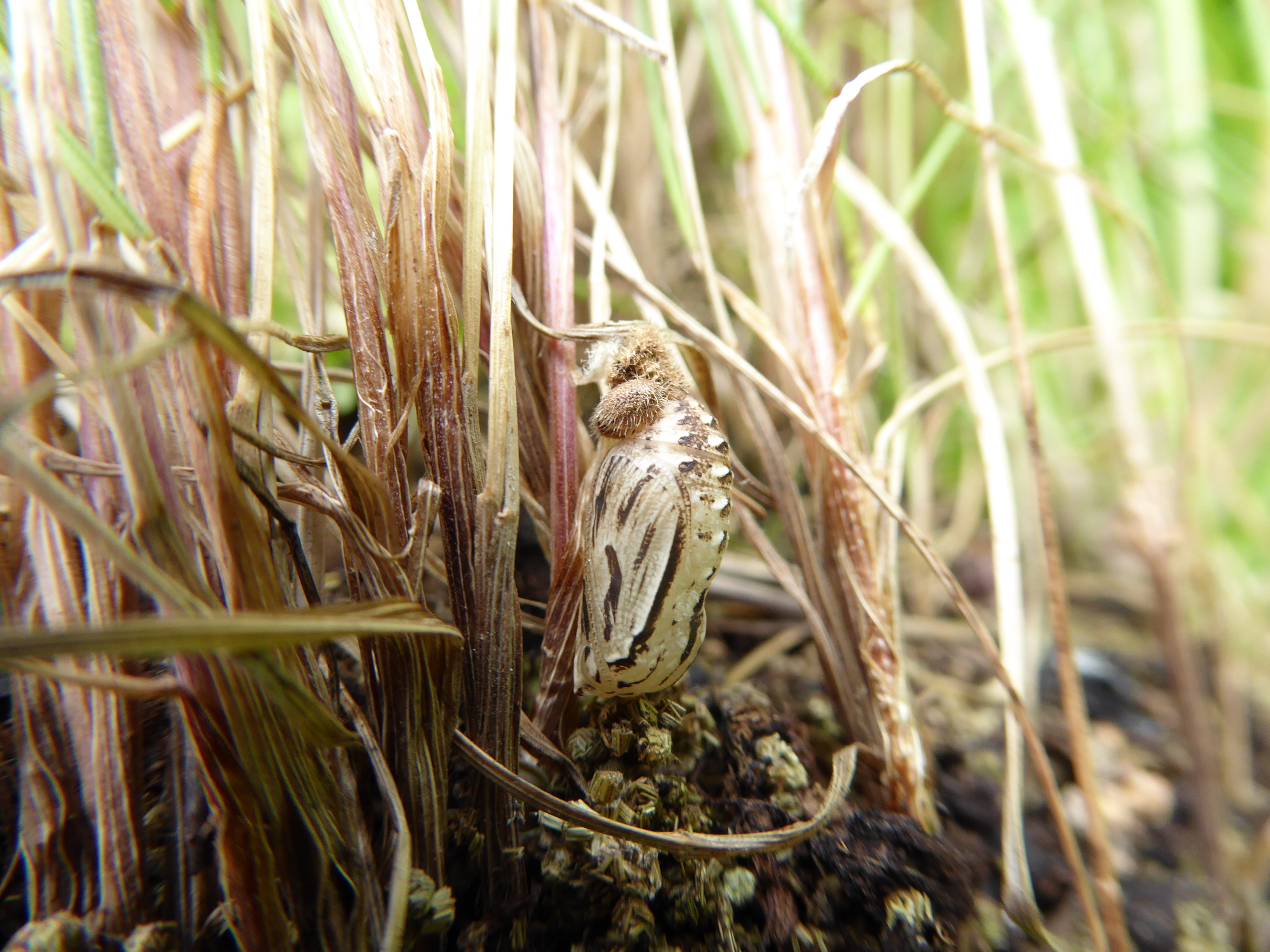 Hedge Brown Pupa.
Hedge Brown Pupa.
The adults emerged between 3rd and 18th July; the pupal stage lasting 23-25 days. Males emerged first, with the first females not emerging until 13th July. The emerging adult crawls up a grass blade and dries its wings, hanging suspended. Males patrol soon afterwards, in their search for females.
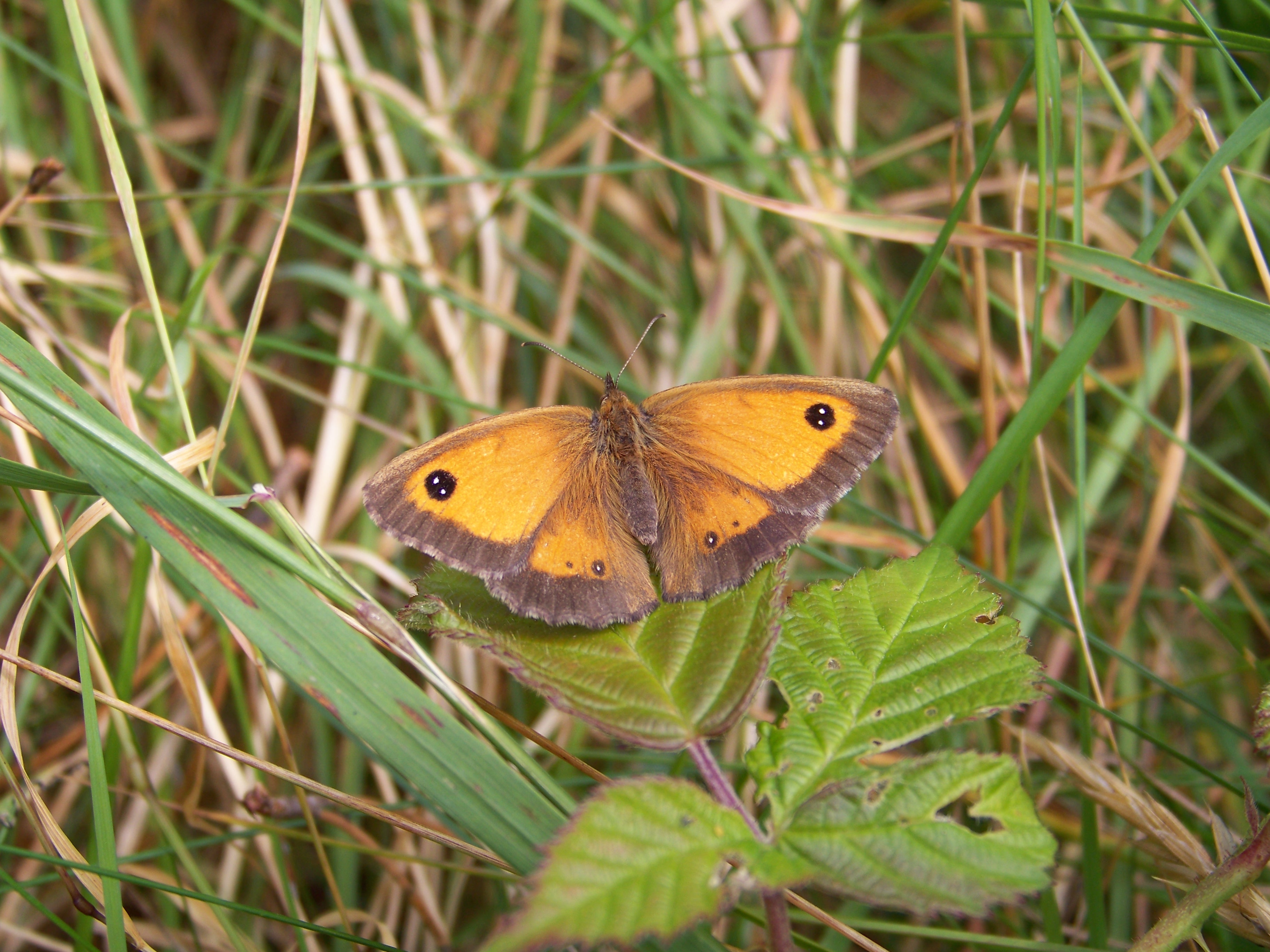 Female Hedge Brown basking on bramble at The Raven, County Wexford. The Raven is one of the best sites in Ireland for butterflies.
Female Hedge Brown basking on bramble at The Raven, County Wexford. The Raven is one of the best sites in Ireland for butterflies.
DISTRIBUTION AND STATUS: The Hedge Brown is found in the south of Counties Kerry, Cork, Waterford, and Wexford. It is believed that this distribution reflects the larva’s need for the warmer springs that are experienced along Ireland’s south coast. Its continued restricted distribution in Ireland is unusual as it has expanded its range inland and much further north in Britain. This expansion is probably in response to climate change. Lack of suitable habitat may be preventing its spread inland in Ireland. This butterfly is not very mobile and intensively farmed inland areas in parts of Counties Cork, Waterford, Wexford may be the blocking problem. The factors inhibiting its spread northwards along the coast are open to debate. The butterfly may require continuous habitat along the coast to move; this is not present in many coastal areas. The butterfly is not a strong flyer and it may be reluctant to leave the shelter afforded by its breeding habitat. However, the fact that it clings closely to the south coast in much of its Irish range suggests that the key factor is the need for mild spring weather.
Elsewhere, its range is from Morocco to Britain excluding Scotland, eastwards to the Balkans, Greece and West Turkey. It does not occur in Northern Europe.
Its Red List status is near threatened due to population decline and a decline in the area occupied. This is certainly a species we need to keep a careful eye on and records of this butterfly will be gratefully accepted, whether obtained in 2018 or in previous years. Please check your note books!
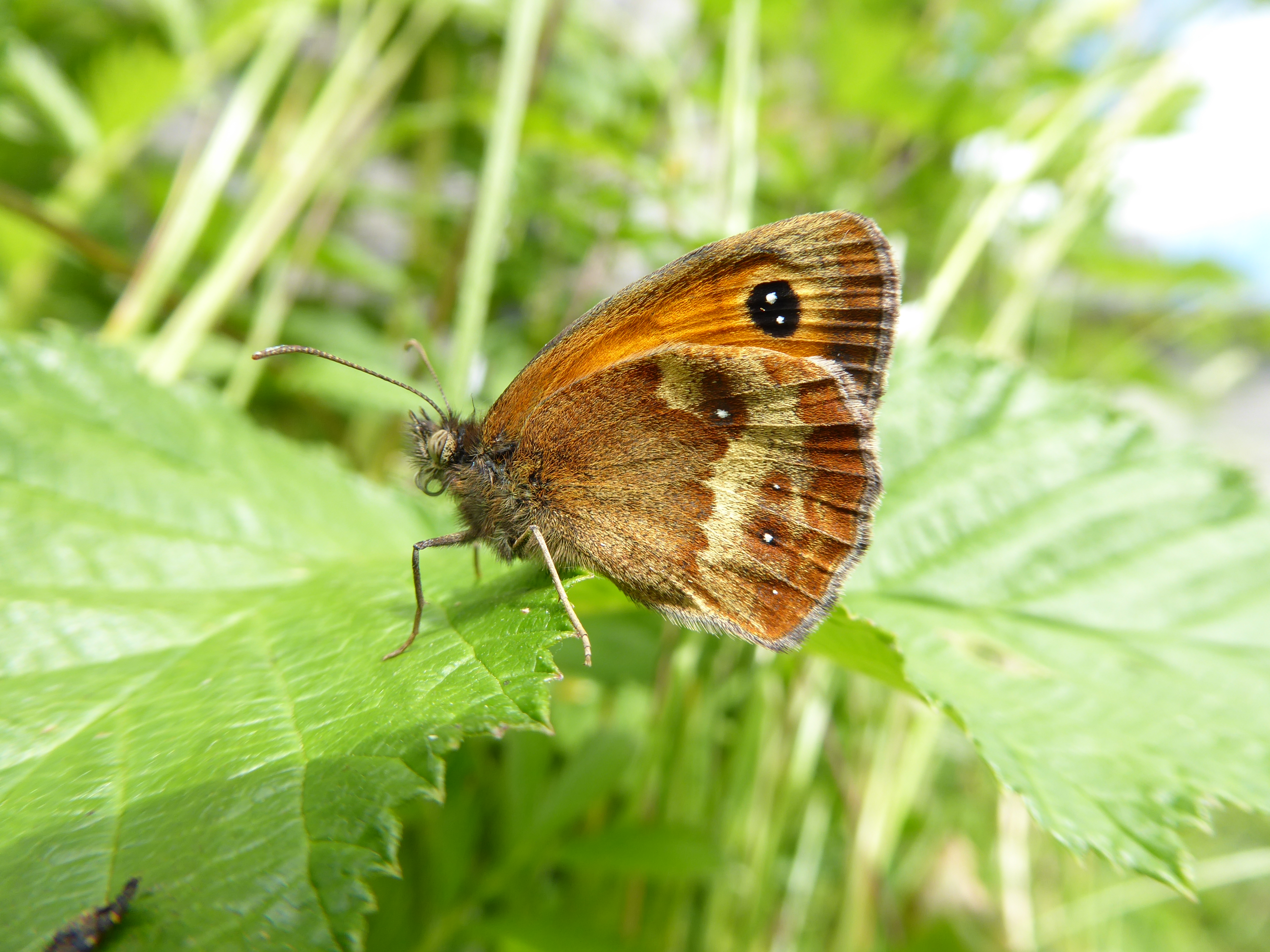 Hedge Brown (bred specimen) underside.
Hedge Brown (bred specimen) underside.
REFERENCES:
Fox, R., et al (2015). The State of the UK’s Butterflies 2015. Butterfly Conservation and the Centre for Ecology and Hydrology, Wareham, Dorset.
Harding, J (2008). Discovering Irish Butterflies & their Habitats. Privately published. Maynooth.
Nash, D., Boyd, T. and Hardiman, D. (2012) Ireland’s Butterflies A Review. The Dublin Naturalists’ Field Club, Dublin.
Regan, E.C., et al (2010) Ireland Red List No. 4 – Butterflies. National Parks and Wildlife Service, Department of the Environment, Heritage and Local Government, Ireland.
Thomas, J. and Lewington, R. (2010) The Butterflies of Britain and Ireland (Revised edition) British Wildlife Publishing, Dorset.
Tolman, T., and Lewington, L. (2009) Collins Butterfly Guide. Collins, London.
Photographs ©J. Harding.
A Visit to Two National Parks in Hungary
By Michael Friel.
My wife and I visited two National Parks in north-east Hungary from 7th till 11th June. We spent two days each in Aggtelek National Park and Bükk National Park. Both of these share a common substratum, namely limestone karst, and lie a short distance apart. Aggtelek is contiguous with Slovenský kras NP in Slovakia, and together they cover 545 sq. km, with 200 sq. km on the Hungarian side. Both parks are well known for having access points to one of the world’s most extensive cave systems, which runs for 16 km under the border.
Aggtelek NP has great wildlife diversity, including the European Grey Wolf and Brown bear; and, as Van Swaay and Warren noted (and it still seems to be true):” The area is very suitable for observing butterflies…here is a generally very harmonic landscape with a complex of semi-natural and partly traditionally used habitats.” In other words, there is not much damaging encroachment by man or beast.
We stayed in Aggtelek village and concentrated on 3 small areas within the park: the northern vicinity of this village, the Jósvafő village area and a country track between Szinpetri and Szin.
There are excellent meadows to the north-east of Aggtelek village. Between the main cave entrance and the village, near a disused hotel, the flowering grasslands had Chalk-hill Blues (Polyommatus coridon), an Idas Blue (Plebejus idas), Nickerl’s (Melitaea aurelia) and Weaver’s Fritillaries (Boloria dia) and Brown Argus (Aricia agestis) on the first afternoon. Then, after a short drive around the northern side of the village to the Jósvafő road, I took a marked trail leading off to the left, past privet bushes and across a hilly landscape reminiscent of the Burren, with many limestone outcrops. This area had Chestnut Heaths (Coenonympha glycerion), several Silver-studded Blues (Plebejus argus) and an Eastern Short-tailed Blue (Cupido decoloratus).
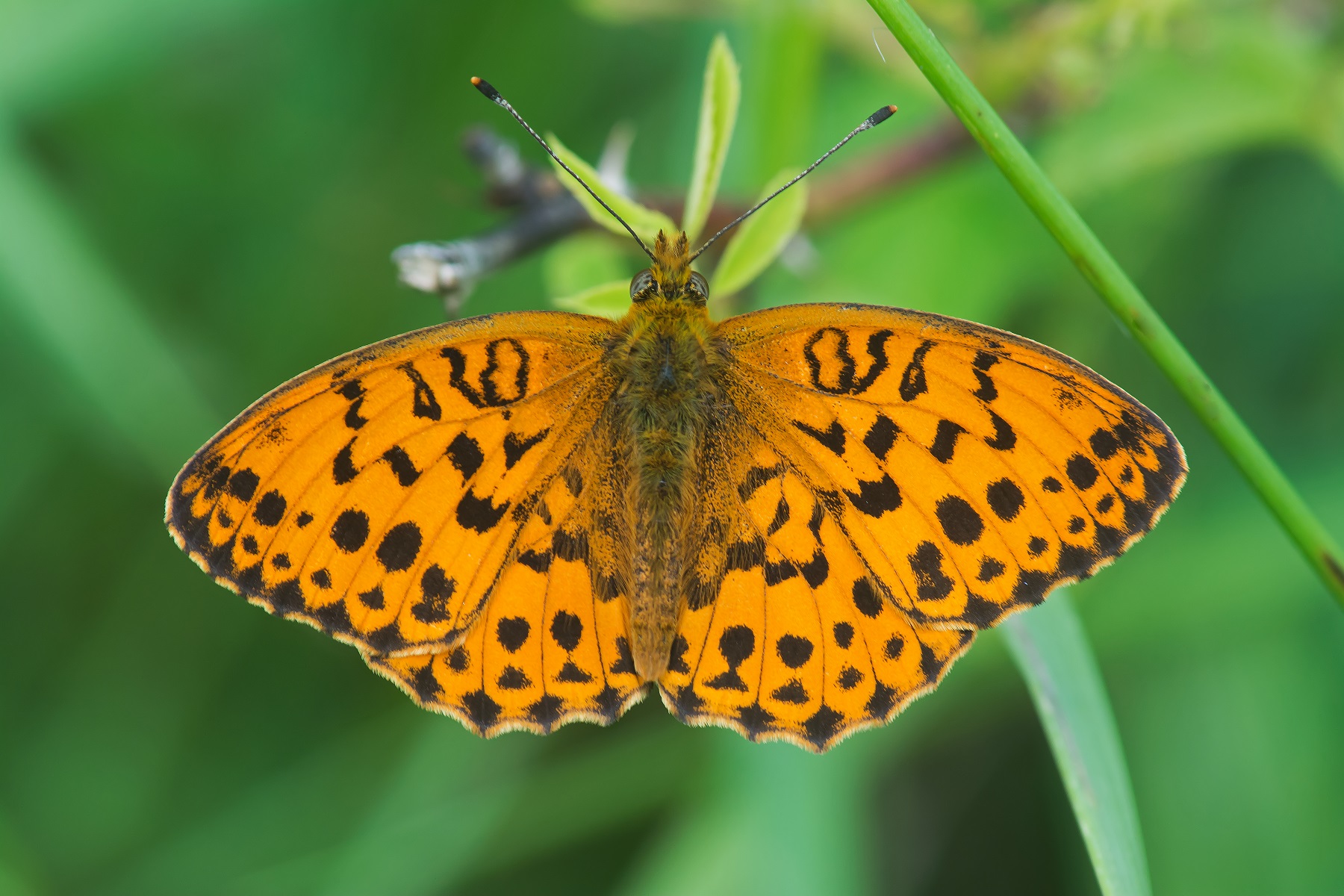 Marbled Fritillary. Photo M.Friel.
Marbled Fritillary. Photo M.Friel.
The following morning, I returned to these two places, finding near the hotel several Pearly Heaths (Coenonympha arcania) roosting in the small trees, a Black-veined White (Aporia crataegi), a Large Grizzled Skipper (Pyrgus alveus) and Heath Fritillaries (Melitaea althalia). At the second Aggtelek site, there were many Sloe Hairstreaks (Satyrium acaciae) fand a single Green Hairstreak – in the bushes, and I was pleased to see a Lesser Marbled Fritillary (Brenthis ino), as well as a Large Wall Brown (Lasiommata maera) in the open ground).
We then drove to Jósvafő village, where we saw High Brown Fritillaries (Argynnis adippe) and another Lesser Marbled Fritillary by the stream. After an excellent lunch in this charming village’s hotel, we drove on to the third area, near the village of Szin. Following a trail to the left, which started with a sandy area containing dozens of puddling Essex Skippers and Common Blues by the road, I climbed up a gentle slope, finding, among others, Marbled Fritillary (Brenthis daphne), Twin-spot Fritillary (Brenthis hecate) and Spotted Fritillary (Melitaea didyma), all enjoying the flowers in the scrubland. I was delighted to come across a Woodland Brown (Lopinga achine) in a trackside copse, as these have been evaluated as Vulnerable in Europe (van Swaay, et al). Walking back towards the road, I came across two very attractive Large Coppers (Lycaena dispar) in some long grass.
Back in Jósvafő, I took a track leading uphill out of the village, and immediately saw the languid flight of three gliders in bushes to the right. They were the aptly-named Hungarian Glider (Neptis rivularis), which, although widespread across Eurasia, owes its name to pioneering Hungarian entomologists. Further up the track I came across a very active White Admiral (Leminitis camilla), which proved to be the last new sighting of the day.
The next morning, I returned to the hotel meadows, where a Niobe Fritillary (Argynnis niobe) showed up. Then, soaring high over my head, an Eastern Imperial Eagle went past, surveying all below it. Just over 100 breeding pairs remain in Northern Hungary, one of its last major sites in Europe. We left Aggtelek and drove slowly southwards towards the second National Park. We took a detour to visit the historical town of Eger, and then wove our way up the Bükk Hills, beautifully shrouded in mainly beech trees (“bükk” meaning beech). The Bükk National Park covers 432 sq km, and is 94% hill-forested.
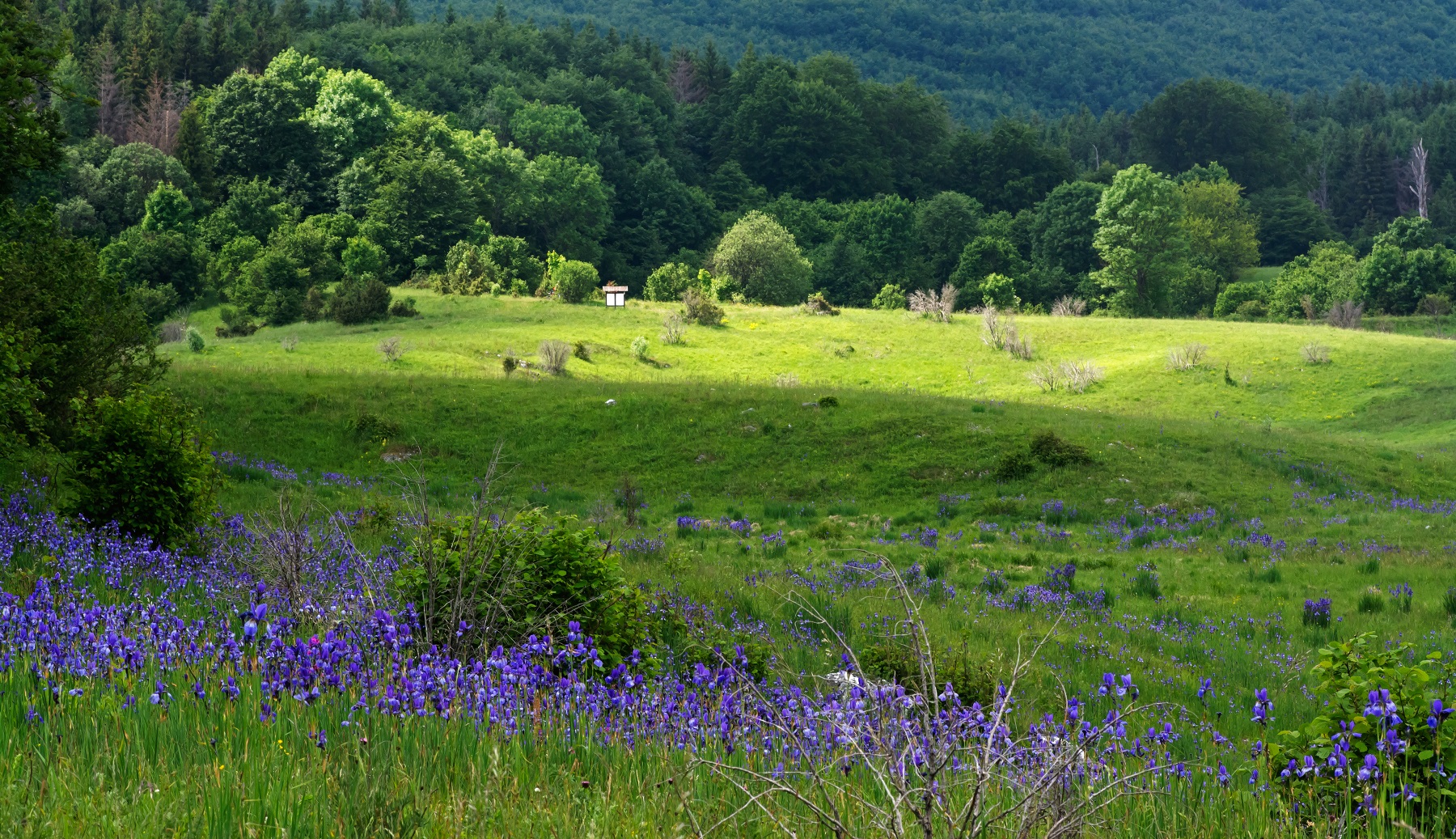 The Great Meadow, Bükk National Park. Photo M.Friel.
The Great Meadow, Bükk National Park. Photo M.Friel.
After we had settled in to our lodgings in the atmospheric village of Répáshuta, our kind hostess led us deep into the woods for about an hour, till we emerged in an elongated meadow stretching far downhill. This, and other meadows in the Park, came about after Slovak immigrants in the mid-19th century cut out areas of the forest for pasturing their cattle. Cattle-rearing is no longer a major activity, and the meadows are now well protected. They contain many wild flowers and herbs and naturally attract butterflies. The highlights for me in this long meadow were Assman’s (Melitaea britomartis) and Small Pearl-bordered Fritillaries (Boloria selene), and I also saw three other “Small” species, Skipper, Copper and Blue.
On the following day, I drove back for about 3 miles along the road taken to enter the town, then parked and walked uphill through the forest for about an hour along a road which led to Nagymező (great meadow), one of a group of adjacent meadows on the Bükk Plateau. My first impression was of blue water, which turned out to be swathes of irises in full bloom over a wide area (see photo on page 26). I spent some 3 hours there and, although the sun would come and go according to the whim of the heavy clouds, I managed to see the following: Glanville (Melitaea cinzia), Cranberry (Boloria aquilonaris) and False Heath Fritillaries (Melitaea diamin), a fine Purple-edged Copper (Lycaena hippothoe) and two Chequered Skippers (Carterocephalus palaemon). Orange Tips and Silver-washed Fritillaries were plentiful, as were day-flying moths, including a pair of mating Transparent Burnets.
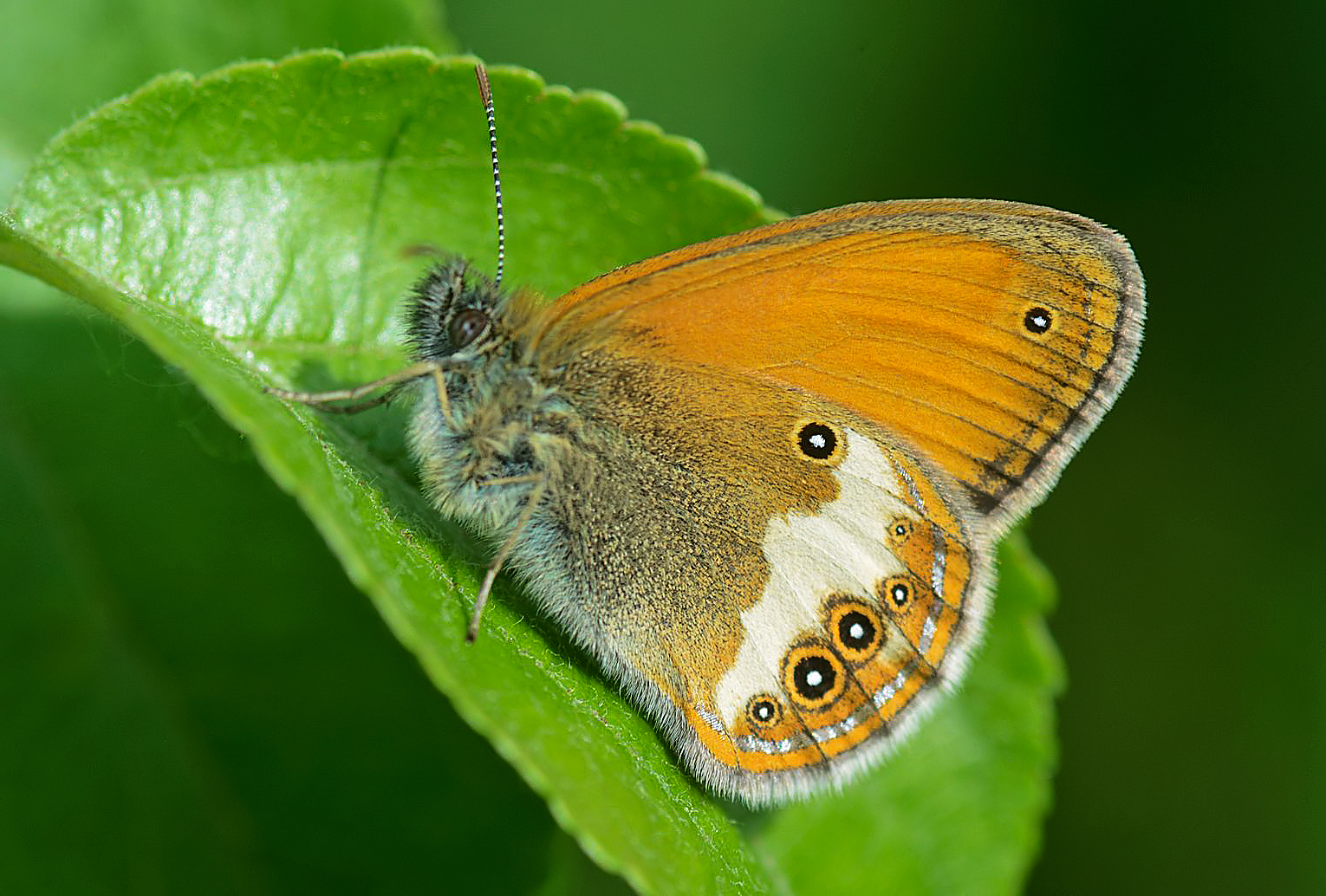 Pearly Heath. Photo M.Friel.
Pearly Heath. Photo M.Friel.
We moved on the next day, stopping for an hour at Noszvaj, in the south of Bükk NP, and more or less on the route to Budapest. In a pleasant wooded valley there were some 20 Silver-washed Fritillaries, together with a couple of Queen of Spain Fritillaries (Issoria lathonia) and one White Admiral, all drinking minerals from a sunny, damp spot in the middle of the path. I also saw my only Holly Blue, Speckled Wood and Nettle-tree Butterfly (Libythea celtis) of the trip here, the latter notable as the only snout butterfly species in Europe.
After travelling west to visit Budapest for 3 days, we drove back east, passing Aggtelek again, but not stopping, as there was one final interesting destination ahead of us. Across the border and into Slovakia, we made a stop at Turniansky hrad, an excellent National Nature Reserve at the eastern edge of Slovenský kras NP.
Climbing up in the afternoon to the 13th-century castle ruins, I soon came across several Graylings, as well as four species new for the trip, Marbled White (Melanargia galathea), Common Swallowtail (Papilio machaon), Chequered Blue (Scolitandes orion) and Blue-spot Hairstreak (Satyrium spini), all on the surrounding scrubby limestone slopes. There were also some beautiful and elusive Eastern Green Lizards scurrying through the long grass. Time on this occasion did not allow me to follow the ridge trail from the castle west to the Zadiel Gorge (which I had walked in 1991); this route surely would have added more butterflies to the list.
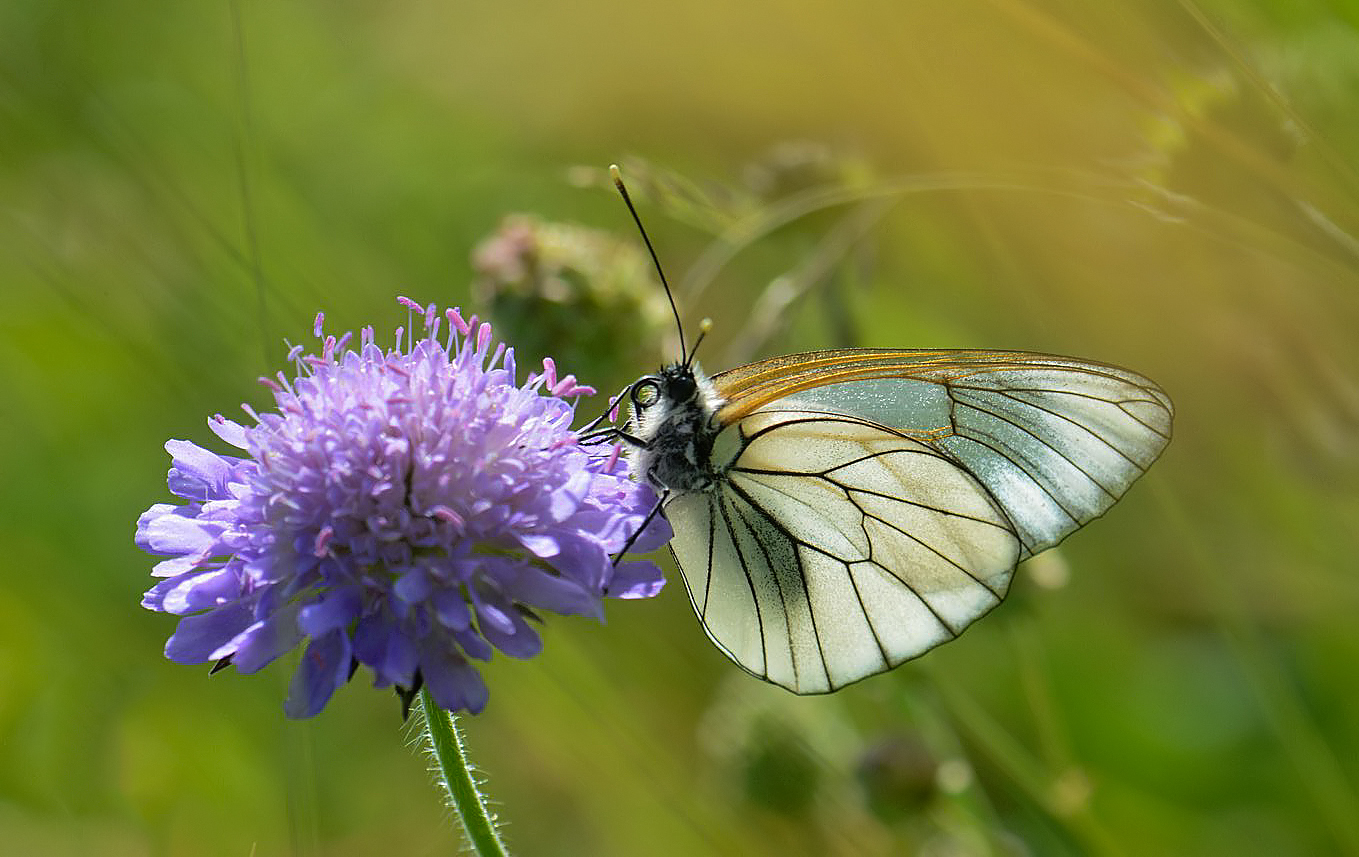 Black-veined White. Photo M. Friel.
Black-veined White. Photo M. Friel.
In the end, I calculated that we had seen 65 species, 26 of which can also be found in Ireland. The 16 fritillary species seen, most of them in excellent condition, indicate that this is a very good time and area to search for them. Of the butterflies recorded, in addition to the Vulnerable Woodland Brown, four of the fritillaries are Near Threatened (Assman’s, Nickerl’s, Niobe and False Heath), as are the Eastern Short-tailed Blue, Chequered Blue and Purple-edged Copper (Van Swaay et al).
Practicalities:
We flew from Knock to Luton by Ryanair, connecting with a WizzAir flight from Luton to Košice, Slovakia. We hired a car using www.edencars.sk (excellent English and they let us keep the car an extra night). You pay an additional 24 euros for driving into Hungary. However, it might be preferable for many to fly direct from Dublin to Budapest. The drive west from Košice to Aggtelek can be done in 90 minutes, while going eastwards from Budapest to Aggtelek would require at least 4 hours. Our Airbnb accommodation in Répáshuta was excellent, while for Aggtelek NP, if we return, we will surely stay in Jósvafő’s only hotel.
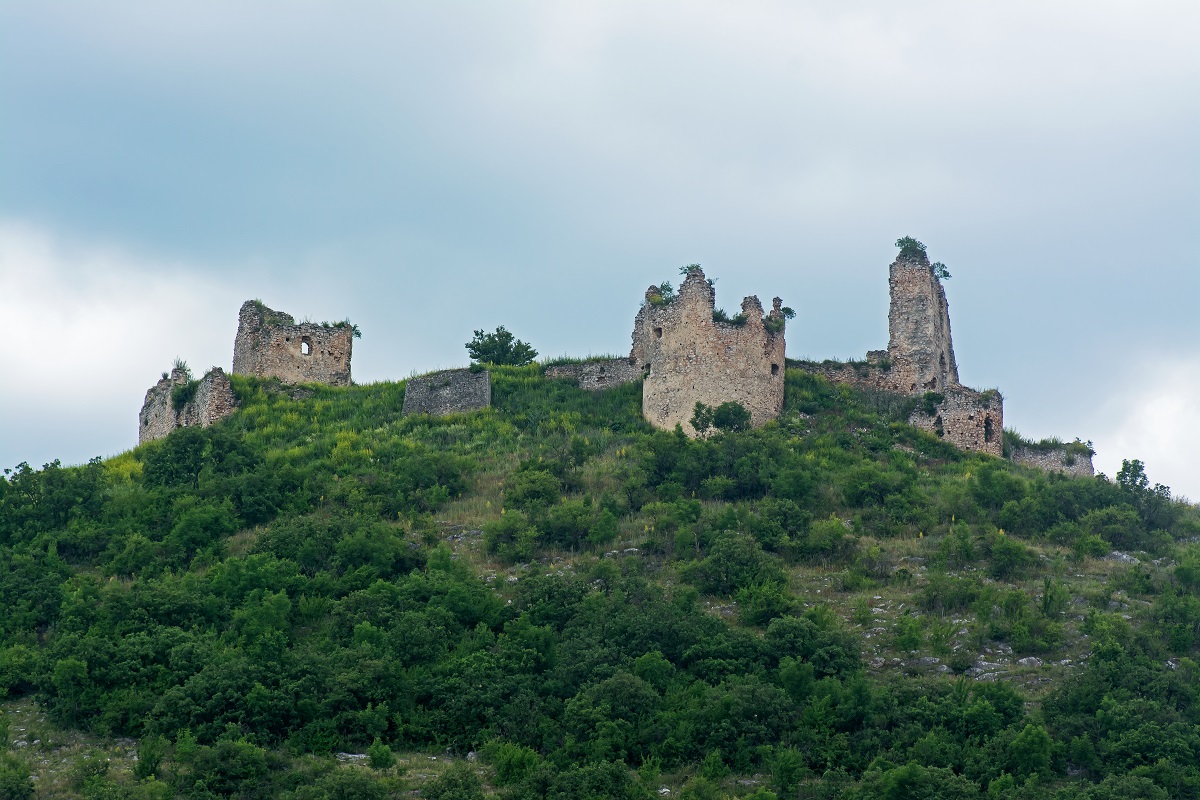 Turniansky hrad, Slovakia. Photo M. Friel.
Turniansky hrad, Slovakia. Photo M. Friel.
References:
Van Swaay, C. and Warren, M. (2003). Prime Butterfly Areas in Europe. De Vlinderstichtung (Dutch Butterfly Conservation) and British Butterfly Conservation.
Van Swaay C., et al (2010). European Red List of Butterflies. IUCN (International Union for Conservation of Nature) and Butterfly Conservation Europe, in collaboration with the European Union.
Websites:
http://www.anp.hu/en (Aggtelek NP)
http://en.bnpi.en/ (Bükk NP)
BUTTERFLY CONSERVATION IRELAND ANNUAL REPORT 2017
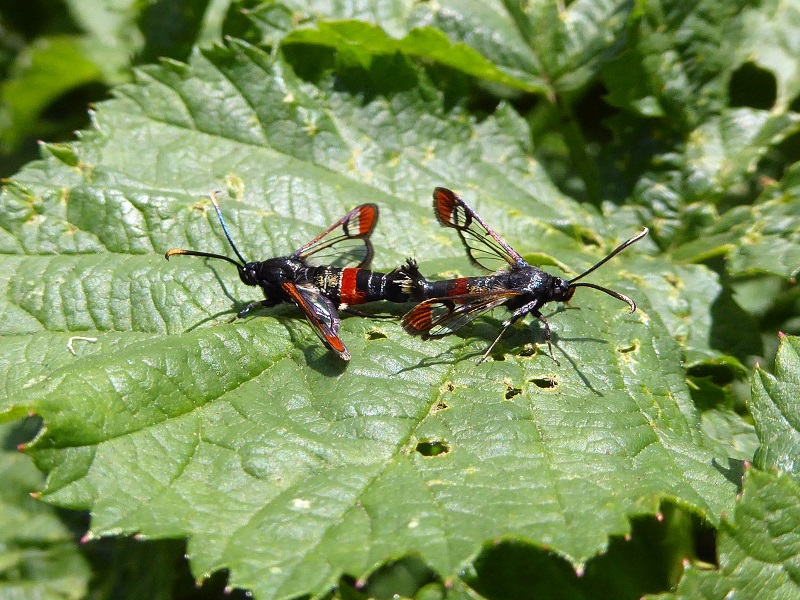 Mating pair of Red-tipped Clearwing moths, Lullybeg, County Kildare. Photo J.Harding.
Mating pair of Red-tipped Clearwing moths, Lullybeg, County Kildare. Photo J.Harding.
BUTTERFLY CONSERVATION IRELAND is a company limited by guarantee.
Registered in Ireland No. 451571.
BUTTERFLY CONSERVATION IRELAND is a charity.
Registered Charity no.: 20069131.
CONTACT DETAILS:
By email:
conservation.butterfly@gmail.com.
By post:
Butterfly Conservation Ireland,
Pagestown,
Maynooth,
County Kildare.
By phone: 01-6289901.
Website: https://butterflyconservation.ie/wp/
Facebook: https://www.facebook.com/ButterflyConservationIreland/
Our Annual Report for 2018 is here. We hope you enjoy reading it.
BUTTERFLY CONSERVATION IRELAND REPORT 2018
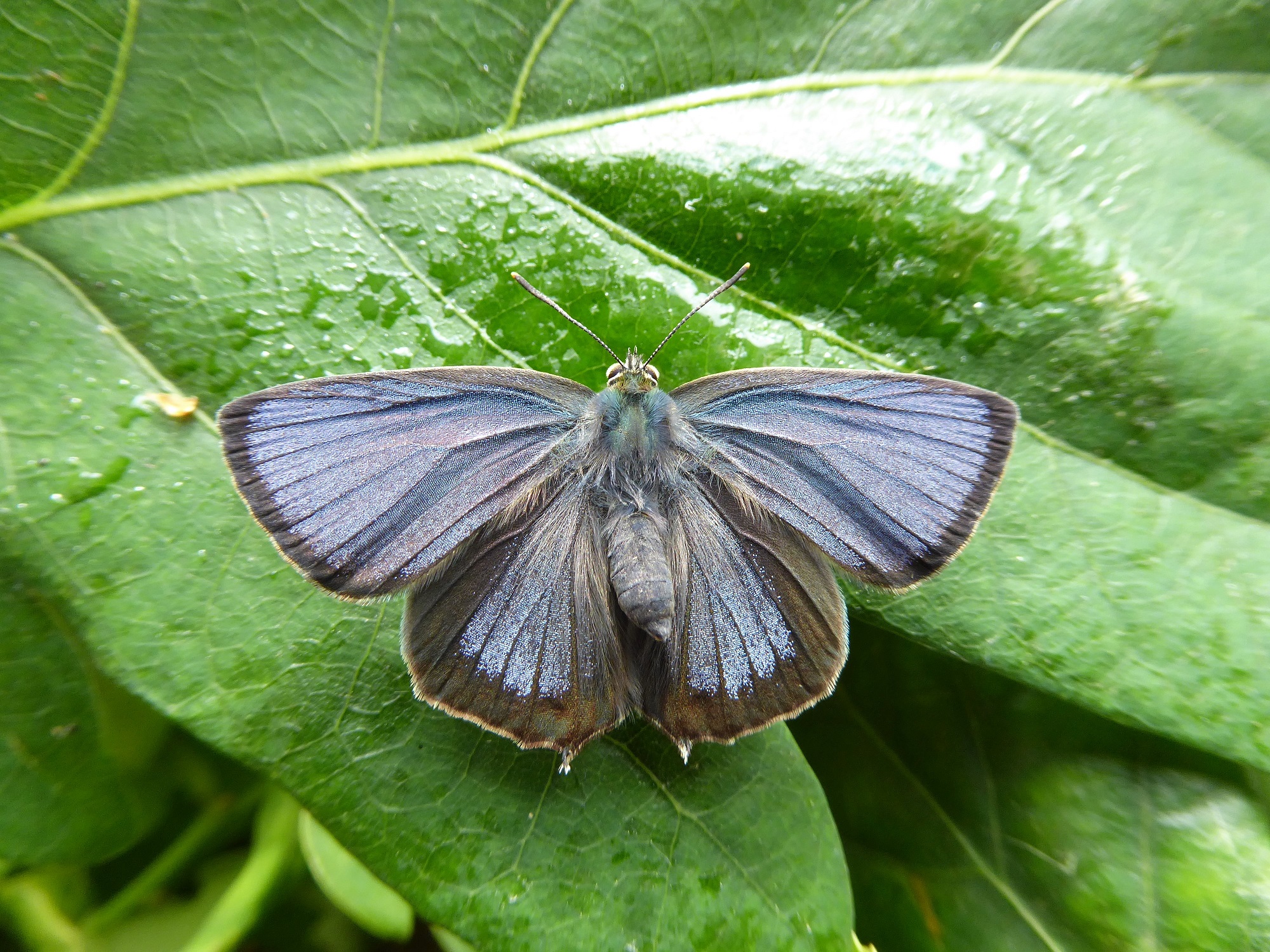
CONTENTS
- Introduction
- Butterfly Season Report
- Events Report
- Crabtree Nature Reserve Report
- Conservation News
- Garden Survey Report
- Frequently Encountered Moths
- Exhibiting Butterfly Photographs
- British Butterfly Safari
INTRODUCTION
Dear Butterfly Conservation Ireland Member,
Welcome to Butterfly Conservation Ireland’s Annual Report 2018. The year 2018 saw varied weather conditions but with glorious sunshine in May, June, July and to a lesser extent August we had more than we could ever dream of after a bitter late winter and early spring. The assault on our public green spaces by state-funded made for a very demanding year defending our natural heritage from unnecessary interference and destruction. Our small staff are fortunate in having excellent support from our active membership whenever help is needed in these endeavours. Your continued practical and financial support is greatly appreciated as we strive to ensure that our butterflies and moths continue to have an important voice for their conservation. Be assured that the conservation agenda is pursued at every opportunity. Our financial accounts were approved so thanks are due to our joint treasurers Michael Jacob and Joseph Harding. Thanks are due to Richella Duggan and Pat Bell for help in editing this report and to all who contributed to its contents and to all of our members and supporters. We hope that you enjoy reading our Annual Report 2018 and we look forward to hearing from you in 2019.
Yours in nature,
Jesmond Harding (Secretary)
Butterfly Conservation Ireland,
Pagestown,
Maynooth,
County Kildare.
Butterfly Season Report 2018
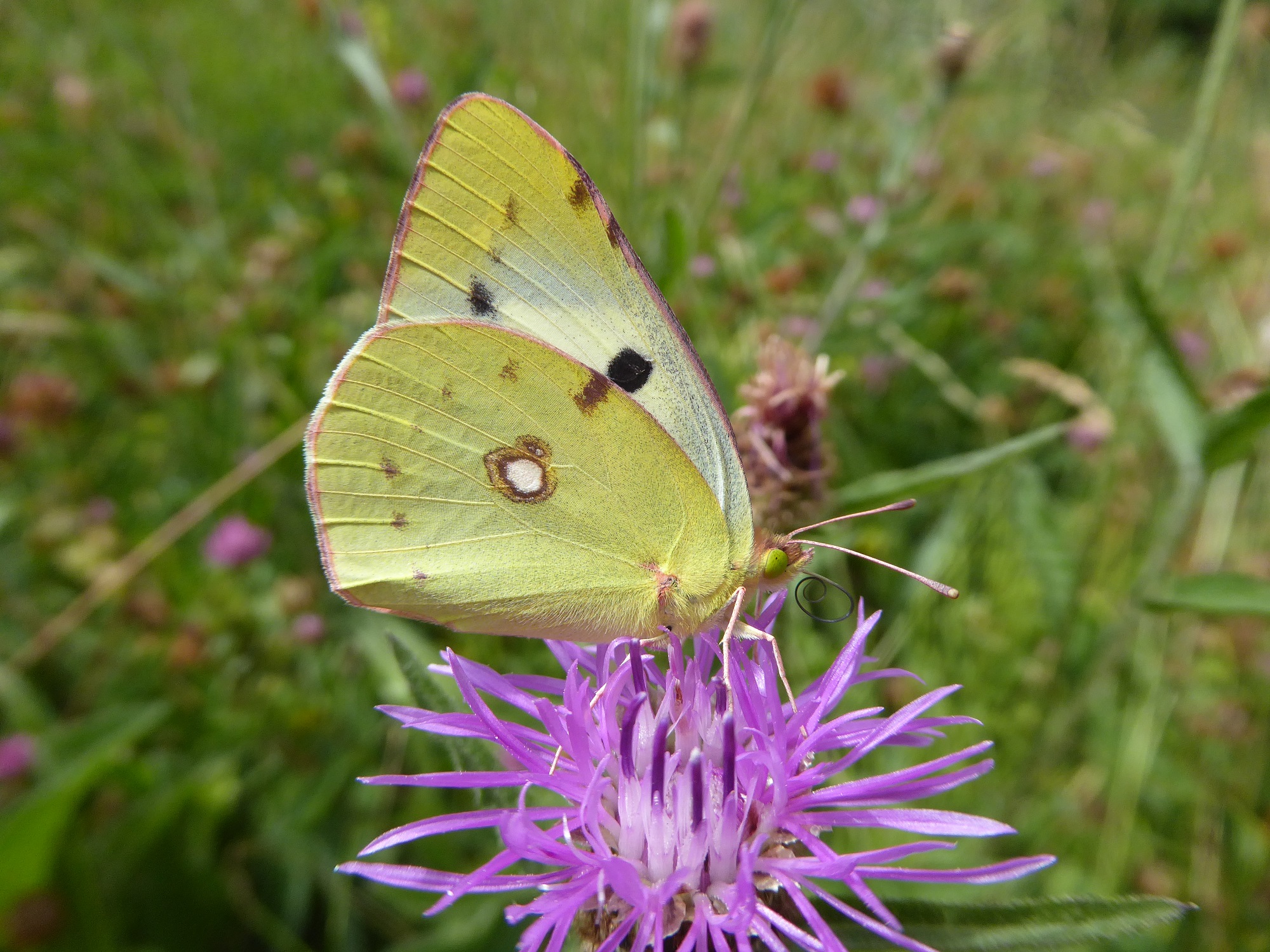
It is impossible for a single adjective to encapsulate the weather conditions in 2018. It had the joint hottest summer on record in Ireland but a cold spring and a cool, mainly dry autumn. The striking influences on butterfly numbers were the cold spring months of March and some of April and the heat of the following four months.
March saw heavy snow and blizzard conditions that brought life to a standstill to many areas. Snow lay in heavy accumulations for over a week and there was little warmth until late in the month. Apart from very early butterflies that woke briefly only to return to sleep, the first record of free-flying butterflies was not received until March 24th when Peacocks and Brimstones were sighted in Kildare. The first record of a butterfly that does not pass the winter as an adult was received on April 9th, a Red Admiral in Donegal. The first resident species that does not pass the colder months as an adult reported to Butterfly Conservation Ireland was a Holly Blue seen on April 17th in Dublin. The season was late beginning and had much catching up to do. April 19th was a great day yielding 27 records. April 19th gave us the first Green-veined White and Orange-tip too (Craig Ayers, on the foothills of the Blue Stacks, County Donegal). April 20th gave us our first Speckled Wood (Lettermore, County Donegal) followed on April 27th by the first record of Green Hairstreak (Eamonn McGlinchey, in Ramelton, County Donegal). Winter was now over! April 21st was a stunning day, with brilliant sunshine and a top temperature of 20 Celsius, a perfect spring day. Butterflies were out, albeit in small numbers. The pattern of consistent sightings of small numbers of spring butterflies continued for the rest of April.
May continued this sightings pattern until May 5th the first date when over 20 butterflies were seen by one recorder. Pat Wyse recorded 30 butterflies at Timahoe, County Kildare while Jesmond Harding counted 29 butterflies at Lullybeg, County Kildare; 15 were Brimstones. The season was late for some species; the first Dingy Skipper record had to wait until a male was seen on May 16th near Russborough, County Wicklow. In some years this butterfly is first seen in late April. The first Small Copper was seen on May 16th on the same site. The first Cryptic Wood White was reported from Rossknowlagh, Donegal on May 3rd but the second was not seen until May 10th. However, these dates are earlier than the first dates from 2013-2016, showing that the cold weather in early spring had no delaying impact on this butterfly’s emergence. May 13th saw the first Comma reports from Ballytiglea, County Carlow, seen by Ian Whitehouse. It is highly likely that the butterfly was on the wing earlier, as it over-winters in the adult state and wakes quite early. May 17th saw the first reports of Wall Browns with 12 seen at Howth, County Dublin by Frank Smyth. Frank also returned the first records of Small Blue and Common Blue from Howth on May 22nd. On the same day, James Noonan reported the first Wood Whites from Termon, County Clare. May 23rd saw the first Marsh Fritillaries (Frank Smyth, Bull Island, County Dublin) and first Pearl-bordered Fritillaries (H. Shepherd, Fahee North, County Clare). Numbers of butterflies being seen built steadily as the warm, sunny weather in May continued. On May 26th John Lovatt saw over 150 Green-veined Whites at Oweninny, County Mayo. On May 31st, James Noonan reported a minimum of 96 butterflies on Bull Island.
The next day, June 1st saw a report of 548 butterflies from Bull Island from Niamh Lennon and Robert Aldwell. June was off to a great start! May and more especially June were peak months for Small Heaths. Only six Small Heaths were recorded after mid-July, strongly supporting the idea that the species was single-brooded in 2018 despite the warmth. The first Meadow Brown and Large Heath was seen on June 6th, both by Jesmond Harding in Meath and Kildare respectively. The Dark Green Fritillary was first recorded on June 11th in Donegal by Maurice Simms. This is an early date for this handsome butterfly. On June 25th Robert Aldwell saw the first Graylings at Fanad, Donegal. Robert said that this is the earliest record for the county. The Small Blue was recorded from May 22nd to June 24th. On its flagship Dublin site, Portrane numbers reached stupendous heights. John Lovatt reported 439 there on June 7th along with 204 Common Blues and 33 Small Heaths. Masses of Six-spot Burnet larvae were also present. High numbers were being returned for other species too. Over 313 butterflies were counted at Clooncoose, County Clare by Jesmond Harding on June 29th; 221 were Dark Green Fritillaries. A great surprise was to see two second generation Wood Whites on this date. This is remarkably early. Typically, these do not appear until nearly a month later. This rare butterfly had an extraordinary year, with good numbers in both broods. On June 30th I was surprised to see a newly emerged female Brimstone at Gortlecka, County Clare, easily the earliest I have seen the new generation of this butterfly. Silver-washed Fritillary appeared early too, with nine seen in the Phoenix Park, Dublin on June 27th. Heat continued and anything seemed possible. Day after day of clear blue skies and brilliant sunshine seemed to be changing the world. Then on July 9th news arrived from Sean and Luke Geraty of a minimum of 170 Purple Hairstreaks seen on the Phoenix Park oaks. Essex Skippers were in the field, first recorded on July 1st in Killinick, County Wexford. I saw 15 Essex Skippers in Kildare on July 15th but two weeks later they were gone, burnt out by the blazing heat. Its lookalike the Small Skipper was first seen on June 26th by Enda and Ciaran Flynn at Timahoe, County Kildare. On July 9th I saw 77 darting among the flowers at Timahoe before heat and horseflies brought a halt to my count. On July 17th I counted 366 butterflies (12 species) at Lullymore/Lullybeg, County Kildare. Dense clouds of butterflies were met in some flower-rich spots that made for a dizzy experience. The shock of so many in small nooks is something I have rarely seen, so it makes for an experience that is special but that needs to be recorded so that our memories of stellar summers can be validated.
The July heat was bringing Peacocks out early too. Jesmond Harding saw the first new Peacock on July 9th in the Phoenix Park, Dublin. It is quite possible that this butterfly overlapped with some of the previous generation. July continued to return high figures. Ian Rippey saw at least 25 Commas at Ballytiglea while Helen Cloney saw 9 Commas on buddleias near Enniscorthy graveyard. Helen saw over 50 Small Whites there in late July.
August opened on a cooler note but there were some outstanding days. On August 3rd Jesmond Harding counted 304 butterflies, including 194 Peacocks at Lullymore/Lullybeg. On the same date over 500 Green-veined Whites were counted by Robert Aldwell, Ian McCambridge and Con O’ Donnell at Greencastle, County Donegal. These figures show what is possible in unspoilt habitats in beautiful summers. Ian Rippey recorded 14 species that day in the Burren, County Clare and Galway. These included 11 Brown Hairstreaks, the first date these were seen but it is clear from the condition some were in that they emerged some days earlier. The numbers reported continued at a high level throughout the month and while this account deals with adult butterflies only, I mention in passing the very large numbers of Marsh Fritillary nests and new sites found, no doubt due to highly favourable weather. Some very good numbers of Painted Lady were being reported but bucking the trend the Red Admiral was well down on 2017.
September opened well. The first two days were beautiful. A total of 424 butterflies were counted at Lullymore/Lullybeg by Jesmond Harding. However, most of the month had poor weather for butterflies. While many species were reported, no such high figures were seen again. The long slow fade out was upon us, but at least our recorders could draw breath! However, the season still had life in it!
October proved a quite fruitful month. Clouded Yellow, Brimstone, Large White, Small Copper, Red Admiral, Painted Lady, Small Tortoiseshell, Peacock, Comma and Speckled Wood (10 species) were reported. The highest number of butterflies seen was 28 by Robert Aldwell and Niamh Lennon at The Raven, County Wexford on October 20th. Some butterflies were seen in November, especially Red Admirals by Frank Smyth at Howth, but the last free-flying butterfly of 2018 was a Small Tortoiseshell seen in Newbridge Park by John Lovatt and James McNally on December 2nd. This was a fitting conclusion as this species was also the first seen in 2018, on January 5th, by Michael Gray in Dublin. And so, 2018 joins the historic list of great summers; 1895, 1947, 1976, 1989, 2006. However, unlike almost all previous years with hot summers, we now have many records to show how our butterflies responded. Sometimes a great year is followed by a tremendous crash, especially when drought kills off larval food plants. We thank all our recorders who sent records for 2018. How will 2019 follow this climax year? Will some species plummet? Will gains made in distribution and abundance by the Marsh Fritillary be sustained? We need to know the answers to these questions. Please continue to send your records to us at conservation.butterfly@gmail.com.
For details of our recording see https://butterflyconservation.ie/wp/records/
Events Report 2018
The following are reports of the outings we had in 2028. For photographs arising from the event, see the posts on the website https://butterflyconservation.ie/wp/
Reserve Management Day Report February 17th 2018
For this event we had a sunny, dry and mild day at last, giving perfect conditions for tackling scrub at Lullybeg. We further broadened the track connected the excellent habitats at Lullymore and Lullybeg by cutting back scrub on both sides of the track.
This intervention has a number of benefits. The track itself contains excellent habitat. It contains a high density of the nectar-rich perennial, Devil’s-bit Scabious, which is fed on by adult butterflies in July, August, September and October. This plant is the only larval food plant of two important species of lepidoptera, the Narrow-bordered Bee Hawkmoth and the Marsh Fritillary butterfly. Increasing the levels of sunlight entering the track has allowed the Marsh Fritillary to move in to breed. We found two larval nests last autumn, and re-found these today. The nests are large, and the larvae were basking in today’s sharp late winter sunshine. Direct sunlight is vital to the larval development, and conditions created here by clearing work carried out in 2017 and continued today has yielded positive results.
The habitat here approximates to the Annex I habitat under the 1992 Habitats’ Directive, Molinia grassland (grassland rich in Purple Moor-grass). This grass dies back to a straw colour and this is vital for the Marsh Fritillary larvae, and other species’ larvae which use it as a basking site. Another larva to do this is the Ruby Tiger moth larva, which over-winters as a fully-fed caterpillar but which needs to bask for several weeks before pupating in April. This leaf litter is also used by Brimstone butterflies as basking sites in spring. Furthermore, the track contains two species of small tree, Purging Buckthorn and Alder Buckthorn, used by the Brimstone butterfly for breeding. This butterfly lays on unshaded plants and prefers plants that are both unshaded and sheltered, making the plants growing here ideal for this beautiful and local butterfly.
The shelter and the removal of shading scrub creates a warm micro-climate which draws in many insects, making the area a very attractive site for dragonflies to feed and to heat up. The scrub bordering the track creates a warm, especially sheltered woodland edge habitat, a natural patrolling edge for male butterflies engaged in mate-seeking. This is especially evident in the case of Orange-tips and Brimstones in spring, and Silver-washed Fritillaries in mid-summer.
Finally, the track connects the rich grassland habitats in the wider area, allowing for connectivity and dispersal within the landscape. Evidence for the use of the track for dispersal has been observed in the Marsh Fritillary, a mainly sedentary butterfly which occasionally moves to colonise new habitat patches and maintain genetic variety by mating with individuals from other existing populations. Marsh Fritillary butterflies have been seen entering the track, from both Lullymore and Lullybeg, suggesting a connection and interaction between the two populations. Research strongly supports the need for populations of this species to remain connected by dispersal, and barriers such as a block of woodland may be sufficient to isolate colonies, which has often proved to be very damaging to the long-term survival of this vulnerable butterfly.
Later in the year, we will get to observe the benefits of our work, for butterflies are quick to exploit new opportunities, making for a satisfyingly quick return on our investment!
Thanks are due to all who support our work in any way, and particularly to our members who put in such great work today.
Reserve Visit Report May 19th 2018
A breezy, mild day with occasional sunny spells gave the weather context for our annual outing to the wonderfully rich habitats in the wilds of Lullymore and Lullybeg.
One of the great pluses of the area is the that there is no long trek to locate the area’s treasures, no difficult terrain to tackle, no dull areas to traverse to reach the good spots. The entire area from the parking point to the western limits of Butterfly Conservation Ireland’s reserve offers abundance to the wildlife lover.
Right beside our parking point a rarity was pointed out by Philip Strickland, our moth specialist. A lovely White-pinion Spotted moth, perched serenely on a birch leaf, its snowy white standing out sharply on dark green. There are no other midland records for this moth! You can see photographs of it on our Facebook page.
Cryptic Wood Whites fluttered gently along the track ahead, looking delicate and ethereal. This dainty sylph floats about the solid world of tangled grasses and scrub, searching almost abstractedly for a mate, nectar or a place to perch or lay an egg.
A sharp contrast to the dreamlike sensation evoked by the ghostly wood whites is the hyperactivity of the Dingy Skippers and Burnet Companions. These don’t stop when the sun is out, buzzing excitedly around inky milkwort and cheery yellow bird’s-foot trefoil, chasing and supping nectar. Mating was observed; a quiescent female folded her wings and allowed joining. Earlier, another disdainful female raised her abdomen towards an amorous male in the classic rejection posture. The ever-interesting Narrow-bordered Bee Hawkmoth was surging across the grassland, while a more ponderous female was observed inspecting the vegetation for egg-sites. This bumble-bee mimic not only imitates a bee’s appearance, but it also makes a loud buzzing sound too.
Brimstones are still about too, but these showy butterflies are currently being gobbled by Hairy Hawker dragonflies which assassinated five on the track alone! Beautiful dragonflies they are, but also ferocious killers. Peacocks are still extant, and apparently not as vulnerable. The star of the show was the Marsh Fritillary, just beginning to fly at Lullymore and Lullybeg. Only males were seen, all pristine. There will, given sunshine, be many more in the weeks again, but no two looks alike, adding endless intrigue to the study of this iconic butterfly.
Thanks to everyone who joined us. It was great to have your company, and share the beautiful butterflies of Kildare’s best butterfly site.
Moth Morning and Butterfly Walk Event Report June 26th 2018
The events were attended by Butterfly Conservation Ireland and Belfast Naturalists’ Field Club. The moth morning led by Philip Strickland was held at Lullymore Heritage Park followed by the butterfly walk led by Jesmond Harding which took place in Lullymore West and Lullybeg.
The previous night was dry, calm and warm, a perfect combination for moths. The five traps held good catches, especially the larger Robinson traps. The full species list is awaited, but highlights include Gold Swift, Goat Moth, Northern Eggar, Pebble Hook-tip, Grass Emerald, Large Emerald, Birch Mocha, Lilac Beauty, Barred Red, Waved Carpet (a scarce species), Northern Spinach, Eyed Hawk-moth, Poplar Hawk-moth, Elephant Hawk-moth, Beautiful Snout, Scarce Silver Y and Burnished Brass.
A great many photographs were taken by field club members who were very interested by the enormous range of the moths’ colours, patterns and shapes. Moth study is fascinating, even if one never gets beyond enjoying their physical appearance, especially the painstaking intricacies of their patterns.
The moths were released after the photos and their day-flying relatives were examined. A lovely female Meadow Brown showing delightfully intense orange fore-wing markings posed very nicely for the photographers. Often seen as a less glamorous species, this was certainly an arresting beauty. Ringlets bobbed along the wayside grasses following us as we made a stroll to the rich grasslands at Lullymore. Marsh Fritillary eggs were seen on the underside of a large leaf of the food plant, Devil’s-bit Scabious. These have turned purple-brown, having been laid about a week ago. Their parents are no longer alive but have left us with the next generation in egg form.
Common Blues fluttered their shining, tinfoil blue wings above still yellow Common Bird’s-foot-trefoil flowers, while a myriad of marauding dragonflies made their direct linear flights and hairpin-bend turns. One snatched a Birch Mocha which it dispatched immediately. The species seen included Four-spotted Chaser, Black-tailed Skimmer, Brown Hawker and a single male Emperor.
Later, Dark Green Fritillaries dashed across our path and vanished as swiftly. These restless, shining orange jewels leave one breathless at their glowing colour and exhilarating movement. It is a pity, though, that they rarely allow a close view.
Near the end of the track connecting Lullymore and Lullybeg, where the two buckthorn trees grow together, a faded Brimstone arrived, still laying her eggs. We netted her for a close view to find her wings perfectly in order, after an adult life-span of over ten months. She was released and resumed her egg laying almost immediately.
There was one mystery. A large, dark butterfly was observed, fluttering around the tops of birch trees. If seen in Europe, it might be expected to reveal a Camberwell Beauty or Purple Emperor. But it did not descend, and the mystery of its identity remains.
A special thanks to the large number who attended and showed great enthusiasm for nature’s wonders. It was a lovely experience for all.
Burren walk at Fahee North, County Clare on Sunday July 1st 2018t
This very well-attended event began against the backdrop of doubtful weather. After searing heat on Friday and Saturday, Sunday was cool, overcast and windy, not a good sign for a butterfly outing. A consoling thought was my retention of three lovely specimens caught the previous day to show at the event.
But shortly after the meeting time of 2pm, the cloud thinned and the sun shone kindly, providing a comfortable heat. A Silver-washed Fritillary, Dark Green Fritillary and a micro moth Pyrausta purpuralis were shown to great interest and appreciation from everyone there, and the fritillaries, being recent emergents, looked especially lovely.
Posing nicely for photographs, all three took to the air and off we went. The plan for the walk involved walking two adjoining but distinct habitats. The first area is mainly shattered limestone pavement with scattered scrub. This area was very disappointing. The thin soils here hold little moisture regardless of the weather conditions but the persistent heat and lack of precipitation has resulted in a starkly parched limestone grassland. The ground vegetation is largely a withered grey and straw colour, and butterflies and moths appear to have deserted the limestone. Even violet plants in semi-shade, used by the Pearl-bordered Fritillary were seen to be in the early stages of desiccation. At this stage of the summer, we could expect Common Blue, Dark Green Fritillary, Grayling, Small Heath among others here but only about five individual butterflies were seen on the limestone.
A change of scene was needed. We walked to the adjoining site which consists of deeper soil with tall grassland and scattered limestone pavement. Our luck changed with Common Blue, Small Tortoiseshell, Dark Green Fritillary, Grayling, Meadow Brown, Ringlet and Small Heath netted and shown. Marsh Fritillary eggs laid on the underside of a Devil’s-bit Scabious leaf were shown. This butterfly has finished flying and is succeeded by its larger cousin, the Dark Green Fritillary which has two large communal roosts on the site. However, a sobering reminder of life’s ephemeral beauty was afforded by the discovery of a killing ground containing the dismembered remains of dozens of the Dark Green Fritillary, as well as a Four-spotted Chaser dragonfly. A keen-eyed predator may have found the roost and if so, is exploiting this larder. It is the first time I have witnessed this concentration of dead specimens. The sight of the colourful wings arbitrarily adorning grey limestone reminds one of the final line of the poem Butterflies (by Rosita Boland): “Gaudy and ephemeral”.
One creature that appears safe from the unknown but probable avian predator is a fully-fed Narrow-bordered Bee Hawk-moth larva, which was found barrelling over limestone on its way to pupate.
On a cheery note, the female Common Blues present were the blue mariscolore form, one of our loveliest butterfly sights. This occurs usually in the north and west and its occurrence in these areas may be an ecological response to a generally cooler, wetter climate. Further east where rainfall is lower the females are more inclined to have brown upper wings but in Clare blue is more prevalent.
We watched a Grayling heat up on limestone, a Small Heath patrol a patch he was compelled to share with Ringlets. We wondered would there be as many specimens of the grass-feeding butterflies here next year if the current drought continued. We will not say this too loudly, but it needs to rain!
Thanks to all who made the event so pleasurable, especially Burrenbeo Trust and to the local farmers in the area for allowing us to walk these beautiful areas.
Crabtree Reserve Management Report November 10th 2018
Lullybeg management day went ahead on Saturday 10th November. It was a wet start, with light rain for a time which eventually petered out. Later the sun broke through and we had quite pleasant conditions for our work.
We weeded a track on part of the butterfly transect where numerous birch seedling had moved in. These were pulled up by hand. A mattock was used to uproot three invasive willows, leaving the area open and ready to continue to receive full sun, flowers and butterflies in 2019. Later we cut and piled scrub on the Lullymore to Lullybeg corridor. We created some scalloped edges to create additional warmth and shelter, providing the perfect warm-up zones for butterflies, moths and dragonflies.
The cattle continue to feed on the reserve and these have settled well. They are certainly disturbing the denser areas dominated by Purple Moor-grass, great for maintaining the flora on the site.We took a break for lunch and watched the cattle which appeared very much in tune with their new surroundings. It gave a restful feeling to see them at ease, and a great feeling of optimism for the coming season’s butterfly populations.
Thanks to all who helped out, and we look forward to seeing you again in February 2019.
Crabtree Reserve Report 2018
| Species Recorded | Average Site Totals 2011-2017
(LTA)* |
Site Totals 2018 | Site Totals 2018 – Average Site Totals 2011-17 | Average
Transect Totals** 2011-2017 (LTA)* |
Transect Totals** 2018 | Transect Totals 2018 – Average Transect Totals** 2011-17 |
| Dingy Skipper | 24.7 | 14 | -10.7 | 23.6 | 2 | -21.6 |
| Brimstone | 44 | 63 | 19 | 20 | 35 | 15 |
| Cryptic Wood White | 4.6 | 3 | -1.6 | 3.4 | 1 | -2.4 |
| Green-veined White | 46.4 | 40 | -6.4 | 35.4 | 32 | -3.4 |
| Orange-tip | 17.6 | 9 | -8.6 | 12.8 | 7 | -5.8 |
| Large White | 0.86 | 1 | 0.14 | 0.6 | 1 | 0.4 |
| Small White | 9.1 | 26 | 16.9 | 7.4 | 16 | 8.6 |
| Common Blue | 54 | 71 | 17 | 48.6 | 61 | 12.4 |
| Small Copper | 15 | 30 | 15 | 5.7 | 10 | 4.3 |
| Red Admiral | 42 | 13 | -29 | 18.7 | 6 | -12.7 |
| Painted Lady | 17 | 77 | 60 | 9.5 | 22 | 12.5 |
| Small Tortoiseshell | 165.7 | 500 | 334.3 | 105.8 | 326 | 220.2 |
| Peacock | 151.8 | 243 | 91.2 | 68.8 | 187 | 118.2 |
| Dark Green Fritillary | 1.5 | 35 | 33.5 | 1.5 | 31 | 29.5 |
| Silver-washed Fritillary | 9.3 | 36 | 26.7 | 3.7 | 30 | 26.3 |
| Marsh Fritillary | 56 | 31 | -25 | 23 | 20 | -3 |
| Wall | 1.5 | 1 | -0.5 | 0.9 | 0 | -0.9 |
| Speckled Wood | 31.6 | 51 | 19.4 | 9.3 | 31 | 21.7 |
| Meadow Brown | 167 | 239 | 72 | 125.7 | 171 | 45.3 |
| Ringlet | 340 | 752 | 412 | 251 | 548 | 297 |
| Small Heath | 130 | 63 | -67 | 106 | 55 | -51 |
| Large Heath | 0.3 | 0 | -0.3 | 0.3 | 0 | -0.3 |
| Site Total | 1329.96 | 2298 | 968.04 | 881.7 | 1592 | 710.3 |
*LTA=Long- term Average
**Transect totals based on an average of 24 counts for LTA and on 24 counts in 2018
The butterflies on Butterfly Conservation Ireland’s Crabtree Reserve at Lullybeg are counted by walking the transect route on part of the reserve from April to the end of September and in October if conditions favour butterfly activity. Results are sent to the National Biodiversity Data Centre. Butterflies seen outside the transect route are counted separately. Both counts are reflected in the table. The unusual weather in 2018 with a very cold, wet March, a wet April followed by a mainly sunny May and a sunny and hot June and July, giving the joint hottest summer on record in Ireland prompts comparisons with counts over the previous seven years. This comparison provides an indication of the impact of weather conditions on population levels. This does not provide the full story behind the statistics. I attempt to interpret the figures in this article.
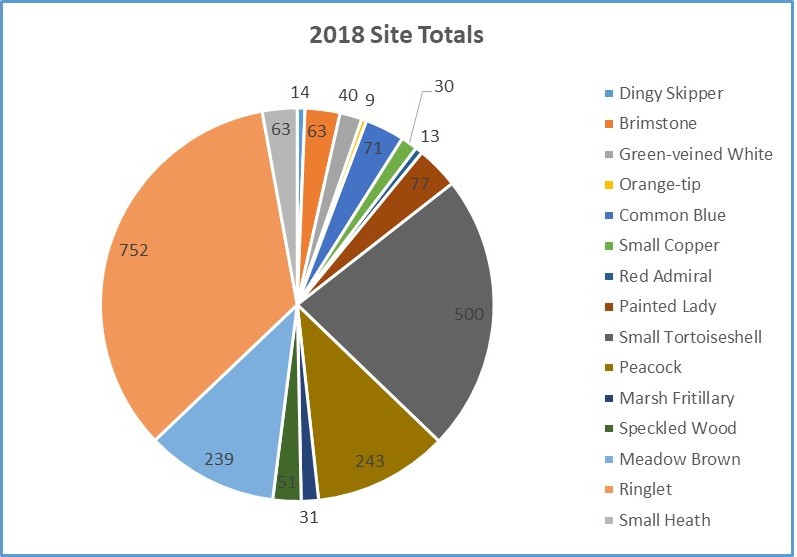 Pie Chart showing 2018 site totals. Chart by Pat Bell
Pie Chart showing 2018 site totals. Chart by Pat Bell
All the butterflies that fly in April and May (except for the Brimstone which also flies in summer and autumn) were below the long-term average (LTA). This can be explained by poor weather in April and the first two weeks in May. The transect was walked in five weeks out of a possible nine during these months, mainly because the weather was unfavourable. The Marsh Fritillary was recorded at below the LTA too, but this is not weather-related and does not represent a real decline. The species is re-building its abundance after the disastrous fire in 2015. In fact, more larval nests were found in July-September (over 40) than adult butterflies (31) suggesting that fine weather during the flight period gave females time to lay second and perhaps even third egg batches, holding out the prospect of large numbers of adult Marsh Fritillary butterflies in 2019.
The Large and Small Whites showed a very small and a significant rise respectively in 2018. Small Copper and Common Blue numbers are up on the LTA but Red Admiral, which had a poor year in Ireland in 2018, was below the LTA. The Red Admiral drop comes after years of abundance and is most likely a short-term fall. By contrast, the Painted Lady, a close relative, had a great year. The Wall Brown was down, a situation reflected across much of Ireland in the past three decades, especially inland and in northern parts of Ireland, except for Donegal. Large Heath did not show in 2018, but this butterfly’s status on the site is that of a vagrant. The serious worry is the drop in the Small Heath. The butterfly has been falling in number on the site over the previous four years and while there was a small rise of two individual butterflies in 2018, the overall trend is one of steady decline. For example, the overall site totals from 2013 to 2017 are: 231, 229, 131, 62 and 61. This butterfly will be watched very carefully in 2019.
The Ringlet showed in great numbers, surpassing the LTA figure by 412 individuals. The Meadow Brown also showed a high increase on previous years. The Speckled Wood showed a more modest rise.
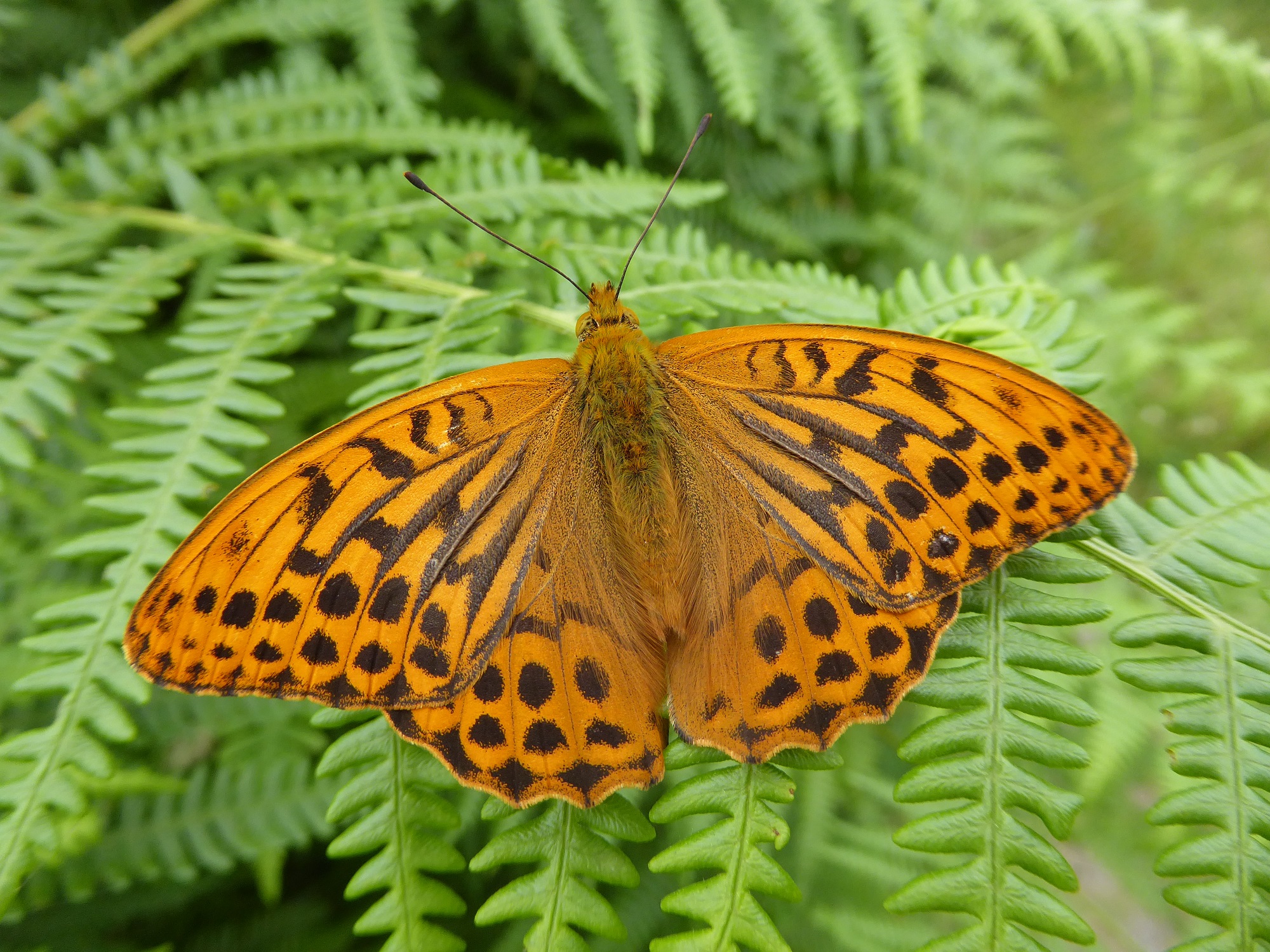
The big upward movers are the mid-summer flyers. The Silver-washed Fritillary showed almost a three-fold rise in numbers while the Dark Green Fritillary has shown a spectacular performance, from none during 2011-2013 to 35 individuals in 2018. There is a clear understanding of this increase. The butterfly died out on the site around 2010. A concerted attempt to provide for it was made. Several Common Dog-violet, the larval host-plant were planted in 2011 and dense scrub was partly cleared to bring light to existing violet plants. In 2015 a small number of adult butterflies were released on the site. It has continued to build its numbers since. The Peacock and Small Tortoiseshell performed better in 2018 than the LTA. Indeed, the performance of both was spectacular. Five hundred Small Tortoiseshells were seen despite the poor September, the month when they usually reach their peak abundance.
We rarely have warm, sunny, dry summers like 2018. Even in October, we enjoyed fine weather, and some butterflies lingered on, shortening winter. The reserve had a further boost in November when cattle arrived to disturb the matted grasses and soil and pare back tall vegetation. This conditioning has left the reserve in the position to prosper in 2019. Thanks again to all who helped in any way to monitor and manage this important reserve.
Conservation News
Butterfly Conservation Ireland is foremost a conservation body. In February and November, a Butterfly Conservation Ireland (BCI) work party cleared scrub on grassland at Lullybeg to create the conditions needed for the Marsh Fritillary, Dingy Skipper and Brimstone. Scrub on the broad ride through woodland connecting Lullymore and Lullybeg was also cut back to ensure that the two excellent areas remain linked so that butterfly populations in the area do not become isolated. On the reserve, we managed to have cattle brought in for two weeks’ grazing. This helped to reduce the sward height and to create some soil disturbance. We are delighted with the effect the livestock had and very grateful to Lullymore Farm. Our project site in the Burren at Fahee North, Co. Clare received attention with a scrub cutting day on November 25th especially at the southern side of the site to make sure the area is not heavily encroached by scrub.
Our recording scheme begun in 2013 continued in 2018. We received another increase in records in 2018, no doubt the result of the great summer weather and the increased awareness of the recording scheme. Calls for conservation must be supported by good information which will help us to make the case for the conservation measures needed.
Our online platforms were used to promote conservation throughout 2018. Various blogs were written to draw attention to butterfly and moth species that may be seen at the various times of the year, to conservation measures one can take to enhance gardens and public spaces for butterflies, to promote recording, to comment on findings of various reports on butterfly and moth populations and to report on Butterfly Conservation Ireland outings. Our Facebook page presents very attractive images sent in by members and by the general public, as well as publicising our work/events.
In 2017 BCI made submissions to three local authorities in Kildare, Laois and Carlow concerning Waterways Ireland’s plan to install hard surfaces along the Barrow and Grand Canal. BCI was involved in a vigorous campaign online and in the broadcast and print media, including The Irish Times in relation to this issue. The development will certainly remove valuable butterfly habitat, including an area used by a strong population of the Comma butterfly. The councils called for extra detail which Waterways Ireland submitted. We examined this and made fresh submissions. The application for hard surfaces was rejected in total in Carlow, in part in Kildare and Laois. Waterways Ireland’s application was rejected for the areas that carry SAC designations and areas near the designated areas. The reasons given include the arguments and evidence provided by Butterfly Conservation Ireland and other organisations and experts and the failure of the applicant to convince the councils that no damage would arise from their proposed development. Waterways Ireland appealed the refusals to An Bord Pleanala. Butterfly Conservation Ireland lacks the finance to pursue this further but we forwarded relevant details to the Save the Barrow campaign. An Bord Pleanala has not yet made its decision known (as of January 12th 2019).
BCI provided advice to Waterways Ireland regarding mitigation measures we would like to see applied when they are installing a hard surface along the Royal Canal between Ferran’s Lock, west of Kilcock to Cloncurry Bridge, east of Enfield.
BCI members have continued to work hard, organising and carrying out recording, participating in practical conservation work and very importantly, enjoying our butterfly and moth heritage.
In 2018 Butterfly Conservation Ireland introduced the Small Blue on to a coastal site in County Louth. The Small Blue is a threatened species in Ireland, rated ‘Endangered’ due to the severe fragmentation of its habitats or the small number of locations it occurs in, as well as a continuing decline in the area of occupancy, in the area, extent and/or quality of its habitat and in the number of locations in which it occurs. The introduction site contains extensive suitable habitat with a high density of the host-plant, Kidney Vetch, growing in excellent conditions. The selected site was searched over three years and no Small Blues were found. Eleven butterflies, at least eight of which were females were taken from Portrane in County Dublin (which had a Small Blue population explosion; see Butterfly Report). The butterflies were released on June 7th. Egg-laying on the new site by two of the released females was observed. The introduction will be monitored in 2019. A progress update will be published.
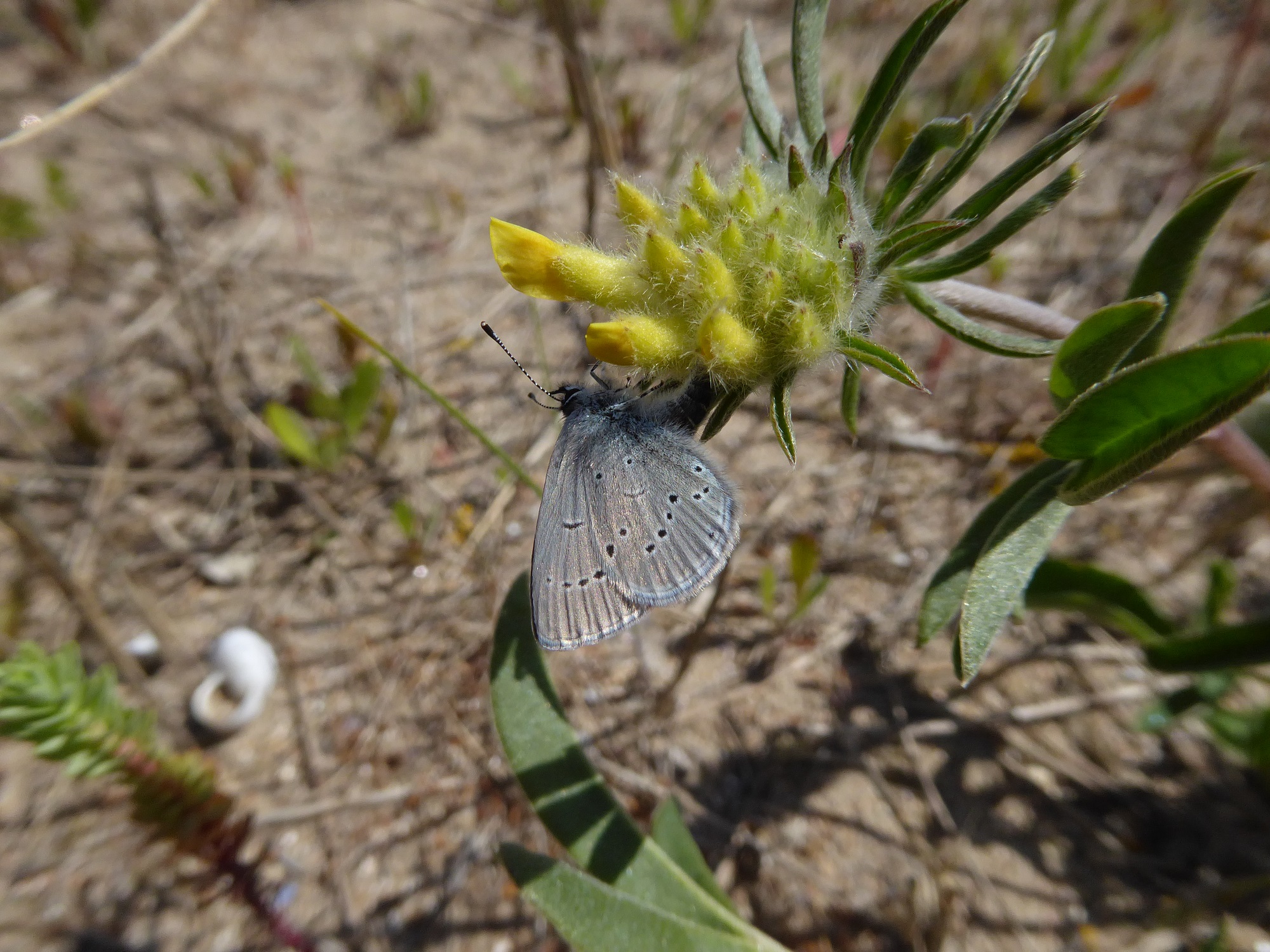
Please continue your recording and conservation work in 2019; no matter how small your work may seem you can make a difference. Some man-made habitats, such as gardens, often contain a greater range of biodiversity than semi-natural habitats because of the diversity of habitats and micromanagement possible in a garden.
Finally, Butterfly Conservation Ireland thanks everyone who helped with our conservation work in 2019. Conservation is a battle for the preservation of everything that is good about our natural world and we greatly appreciate your commitment to the most elegant emblems of our natural heritage, our butterflies and moths.
Garden Survey Report 2018
Butterfly Conservation Ireland members and members of the public participated in our garden survey from March to November inclusive. The survey form, available as a download from our website www.butterflyconservation.ie and available by post on request asks the participant to record the first date each butterfly listed on the form was first recorded in their garden in each of the following three month periods: March-May, June-August and September-November. In a final column, the highest number of each butterfly seen and the peak date is given. Finally, surveyors are asked to indicate which of the following attractants are provided in their gardens: Buddleia, butterfly nectar plants other than Buddleia and larval food plants. Twenty butterflies are listed for recording.
Comments received were generally positive for 2018. Some very high numbers were reported; the highest number of butterflies counted in one day in 2018 was 124, albeit in a garden not previously involved in the survey (July 22nd in the garden of Robert Donnelly, County Kilkenny). In 2017 the highest was 28, 25 in 2016 and 50 butterflies on one date in 2014. Jesmond Harding recorded over 500 individuals during the period of the survey. August saw the highest numbers. September was generally poor after a lovely start. Conditions improved late in September but the main flight season for most butterflies that visit gardens has passed at this stage.
The total number of species recorded in the gardens surveyed was 18. This is up from 15 in 2017, up on 14 in 2015 and 2016, and up one from 17 in 2014. The Small White, Small Tortoiseshell and Peacock recorded in all gardens while the Holly Blue, a species that likes to breed in gardens was reported by just three surveyors, but Elaine Mullins from Portmarnock submitted 106 records of the butterfly. The species with the highest number of individuals recorded on a single day is the Peacock, with 58 recorded by Robert Donnelly. The lowest number of records were for the Grayling (not listed on the survey form). One gardener (who did not do the survey) reported Green Hairstreaks in her County Donegal garden. Another very odd ‘garden’ record was of a Marsh Fritillary reported by Lucy Bell in the garden of the Irish Wheelchair Association in Clane County Kildare. The last three are very unusual garden records for Ireland, but the long hot summer of 2018 increased the possibility of the unexpected.
The Large White was seen in all but one garden. The Large White had a good year overall in 2018. Robert Donnelly reported 15 on July 22nd. Elaine Mullins recorded 98 Large Whites during the survey period. The dates that the Holly Blue was recorded indicate that at least two broods were again produced in the east midlands in 2018; Pat Bell recorded the butterfly on 21/04 (first generation), 04/07-12/08 (second generation). Elaine Mullin’s garden in Portmarnock on the Dublin coast recorded two full broods and a small third brood. Elaine recorded the butterfly from April to May (first generation) and July and August (second generation) and in late September and early October. No third brood Holly Blue was recorded in any garden in 2017, 2016 or 2013 but there was evidence of a third brood in 2014 and 2015. Jesmond Harding again found the Holly Blue breeding on Alder Buckthorn plants on a south facing patio. No Cryptic Wood White, Brimstone, Common Blue or Silver-washed Fritillary butterflies were reported in gardens in 2017 or 2016 but in 2018 Cryptic Wood White, Common Blue and Silver-washed Fritillary were recorded. The Ringlet was found in a number of gardens in rural areas mainly, but in low numbers except for Robert Donnelly, who had 20 on June 15th. The Ringlet’s companion, the Meadow Brown, was found in similar numbers in our gardens while the Speckled Wood occurred in all but one garden but is rarely found in high numbers as it is a territorial species. The Painted Lady featured in all but one garden. The Red Admiral continued to favour flower and fruit-rich gardens. The highest number of Red Admirals reported was 15 on July 14th (Robert Donnelly) down from 25 on August 30th in 2017 (by Jonathan Shackleton). A notable feature was that the abundance of the Red Admiral was well down on previous years.
Of particular interest are the Comma records. Both Paul Cutler from Carlow and Robert Donnelly had this fascinating species in their garden. The Carlow/Kilkenny areas are the Comma heartlands but those of us living further north may one day have the pleasure of this butterfly’s presence. Robert had two generations of Comma in the garden while Paul saw it in late September; the autumn brood is the generation that passes the winter as an adult. Another butterfly that did well is the Common Blue. I found seven at one time, breeding on Black Medic plants. It was also seen by Elaine Mullins, Robert Donnelly, Paul Cutler, Richella Duggan and Pat Bell. It is not particularly common in gardens and can be confused with the Holly Blue which loves garden habitats. However, the Common Blue usually flies low down, settling frequently on grassland while the Holly Blue prefers shrubbery and trees. The orange chevrons on the margins on the underside of the Common Blue are missing from the Holly Blue’s undersides which are pale blue-grey with scattered black spots. The Small Copper was found in some, mainly rural gardens. It was present in Jesmond Harding’s garden from July 10th to September 16th. The highest number seen by any recorder on one day was seven.
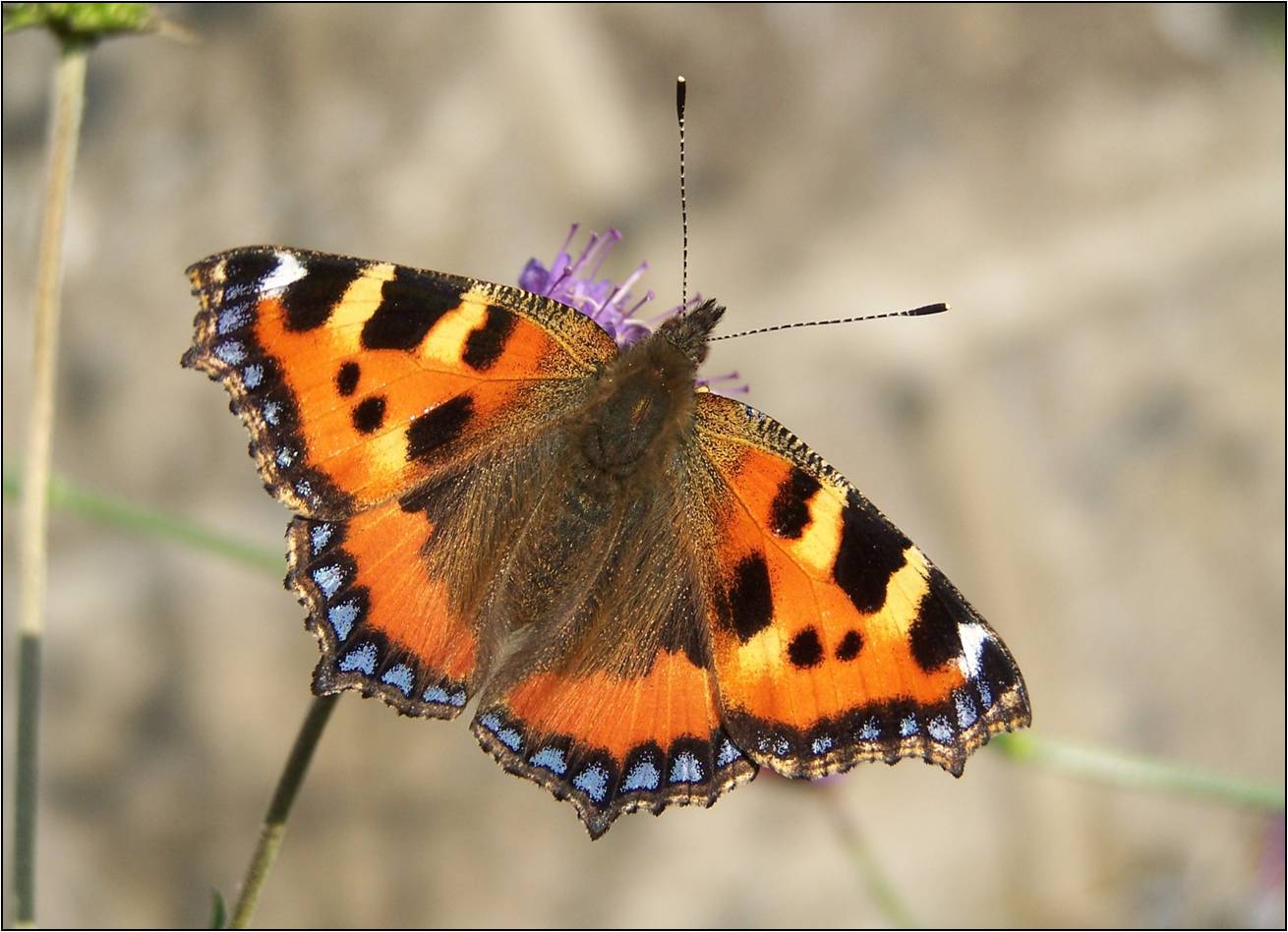
The earliest garden record was of the Small Tortoiseshell on 19/03 (recorded by Robert Donnelly County Kilkenny). The latest was the Small Tortoiseshell on 10/10 by Pat Bell, County Kildare. The urban/suburban garden with the highest number of species recorded was that of Pat Bell in Maynooth and Elaine Mullins with 13 butterfly species; the highest for the rural gardens was Jesmond Harding’s and Robert Donnelly’s with 15 species. Other interesting records were of dragonflies and moths with Pat Bell recording Brown Hawker and Migrant Hawker dragonflies and Cinnabar and Hummingbird Hawkmoths in his garden.
Gardens that provide both larval food plants, as well as nectar sources, had significantly higher numbers of species than those that provided nectar only. This finding is important because it suggests that butterflies can use gardens for their full life cycle and that gardens have a role to play in conservation. Growing Stinging Nettles, cabbages, Common Bird’s-foot-trefoil, Lady’s Smock and wild grasses in sunny, sheltered conditions is a great draw to butterflies and moths. Growing Alder or Purging Buckthorn, Common Holly and native ivy will enrich the species count and numbers further. One may really be inspired to go still further by offering bruised over-ripe plums or dates which Red Admirals find irresistible.
Gardens with Buddleia had high numbers of butterflies, and the plant is especially attractive to the Large White, Small Tortoiseshell, Peacock and Red Admiral.
In the past few years of the survey, 19 species have been recorded in Irish gardens. This is impressive and underscores the importance of managing our gardens for butterflies and moths not only to encourage visits by adults but to encourage breeding too. Over the years, I have seen at least 11 species breed in my garden, and I suspect breeding by others, such as the Small Copper and Clouded Yellow. While we need to try to influence the type of land management beyond our garden walls, in our estates, along the rural hedges and in our landscapes in general, our gardens can and should play a role in conservation.
Get Involved
We hope to expand the garden recording scheme further in 2019. Our website www.butterflyconservation.ie contains information about butterfly gardening; click on the “Butterflies” tab and select “Gardening for Butterflies” for details. The survey form can be downloaded from here but if you need a hard copy please request one by emailing us at conservation.butterfly@gmail.com or by letter to Butterfly Conservation Ireland, Pagestown, Maynooth, County Kildare. If you have any doubts about the identity of any butterfly check our Gallery by clicking on the “Butterflies” tab. Thank you for taking part in the scheme and please continue your recording. Recording begins again in March and here’s hoping for a good season in 2019.
Ten Frequently Encountered Moths
By Philip Strickland
In this article Philip Strickland, Butterfly Conservation Ireland’s moth specialist runs the rule over the ten most frequently encountered moths, some of which are day-flyers. The following are the ten species most often encountered by observers, and Philip receives many inquiries concerning the identity of these moths.
Nowadays more people appear to be aware of their surroundings and want to know the names of the creatures that they encounter during their day to day activities. This may just be while out walking the dog or even driving along a country road. The advent of mobile phones with decent built-in cameras allows a quick snap to be taken and this then can be shared via email or on social media. Almost instantly an identification can be garnered and this can then be ‘Googled’ resulting in a plethora of information on the species and everything associated with it.
There follows some basic information on the ten most frequently encountered moths, whether they are seen by day while out walking, seen flitting around the garden in the evening before dark or are attracted to a window or outside light on a balmy summer’s evening. The list is broadly based on the number of enquiries received, with a photograph attached, from inquisitive members of the public who have little or no knowledge of moths. These are all common species, found in virtually all habitats and can be seen in every county in Ireland. While moths may be more evident flying about in adult form, they can often be easily seen as caterpillars especially when they are wandering about looking for a place to pupate.
Top of the list by a long shot and probably accounts for well over half of all enquiries is the Poplar Hawk-moth . It flies at night from May to July and is strongly attracted to light. With a wingspan of up to 90mm, it is very noticeable especially when found in the morning settled adjacent to an outside light that has been left on overnight. When disturbed it flashes its hindwings revealing dark red patches.
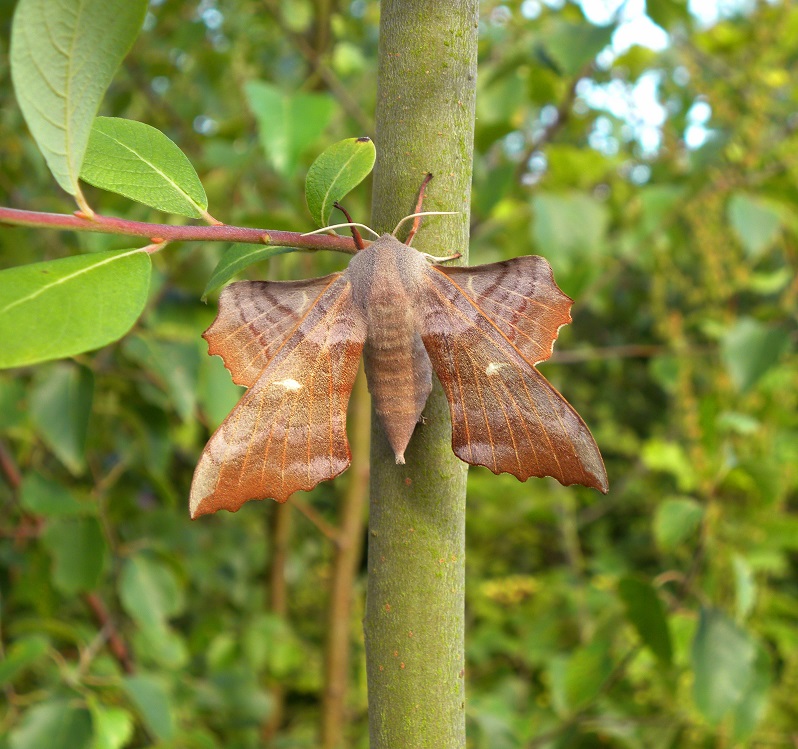
Next on the list is Angle Shades. This species can be seen virtually any month of the year though it is most likely to be encountered between late August and early October. The wing outline is very distinctive and resembles a withered leaf thereby affording it excellent camouflage. It is another night-flyer that is attracted to light.
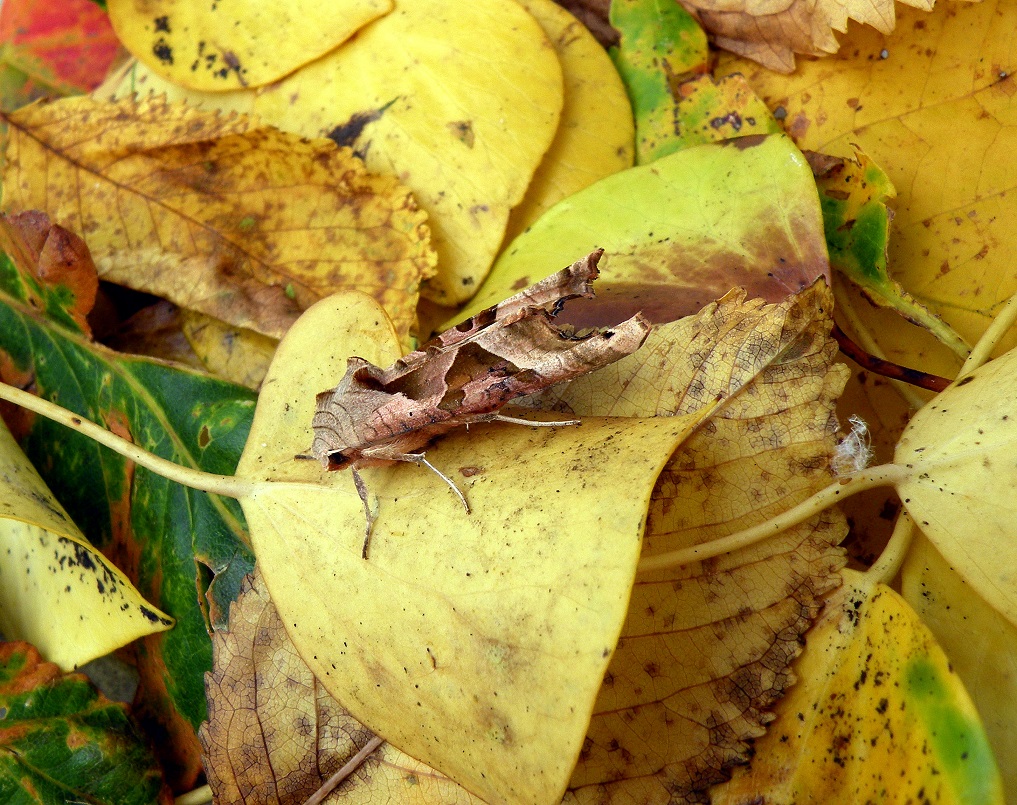
The Elephant Hawk-moth is up third and is another very distinctive, large moth. Its name is derived from the caterpillar as it resembles an elephant’s trunk. The adult can be seen from May to August and it is often found in gardens throughout the country. The caterpillar feeds on Rosebay Willowherb (this plant is often found in woodland clearings or near ditches, typically in damp situations) and often feeds conspicuously by day.
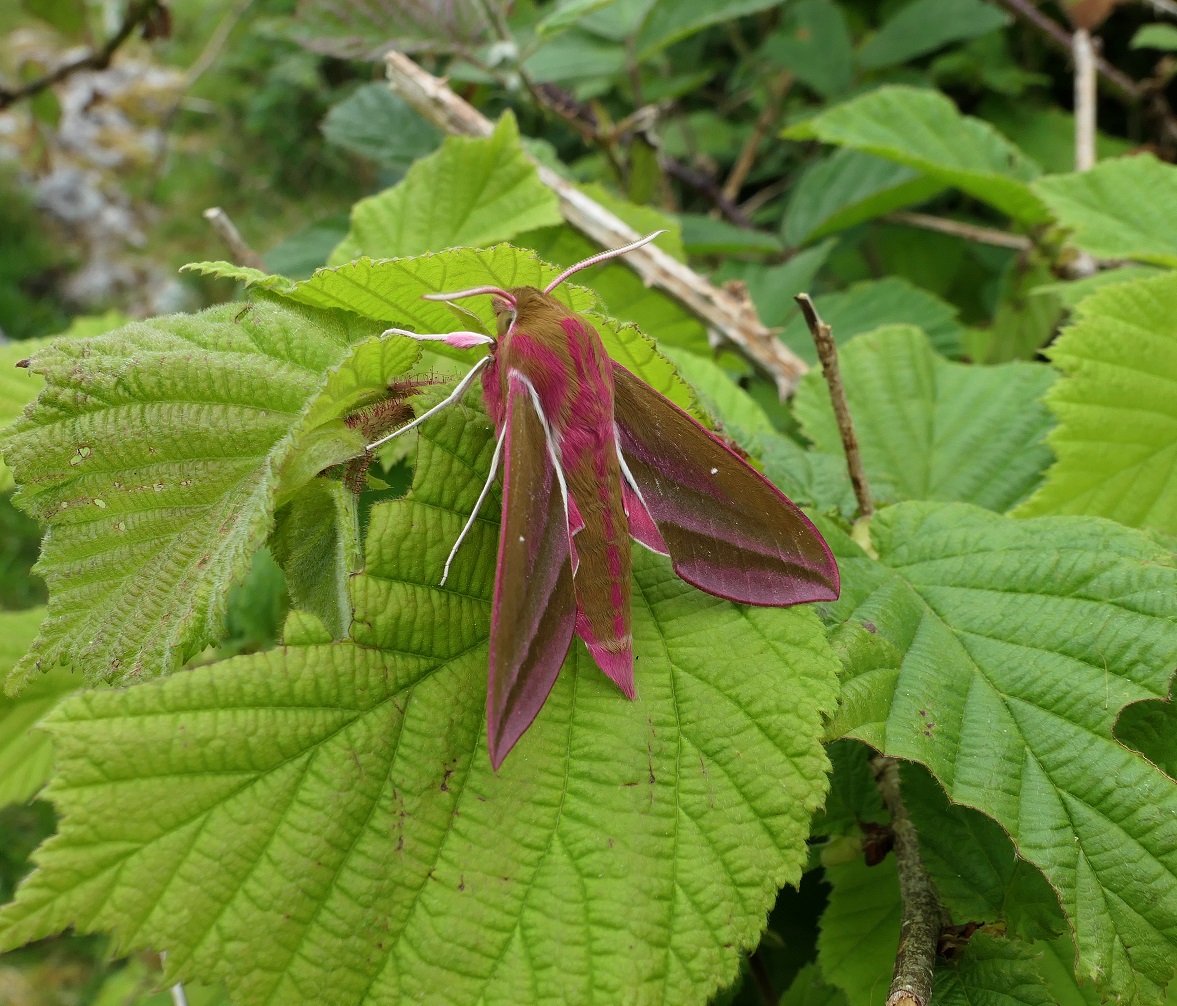
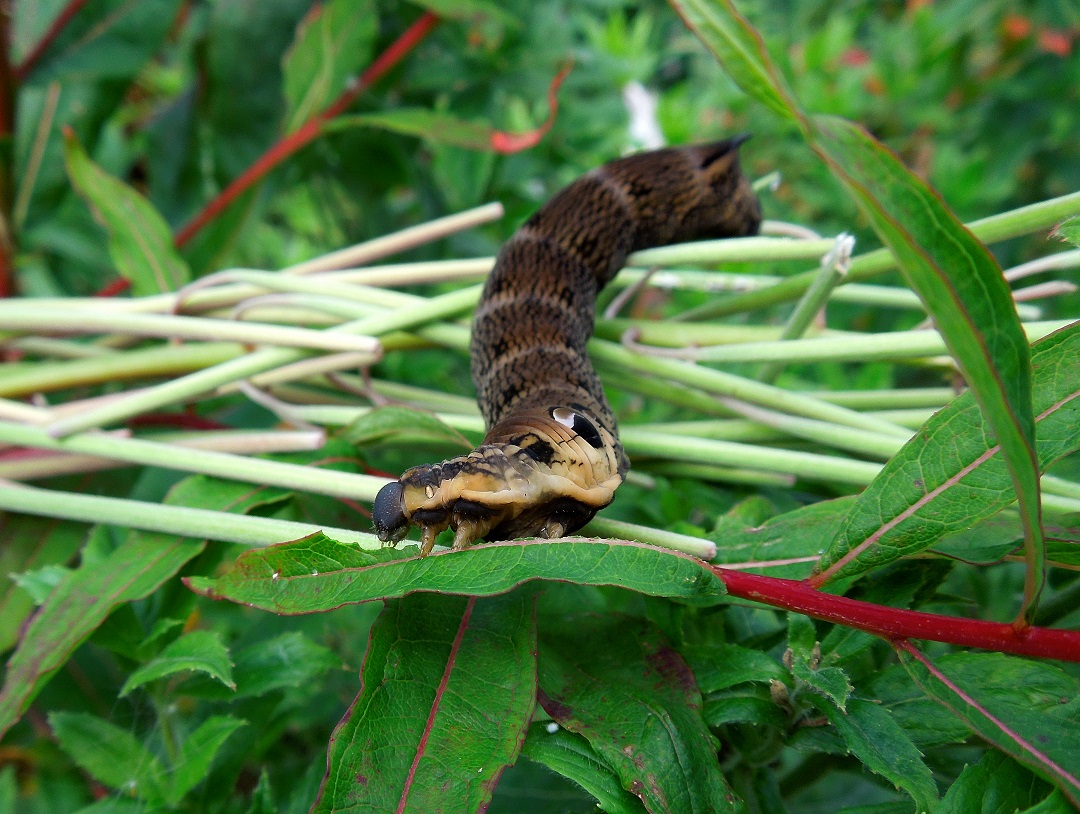
The Silver Y can be seen by busily feeding by day or in the evening around dusk but also flies by night and is attracted to light. The resident population is often augmented by large numbers of immigrants throughout the summer and are noticeable and they speed between flowers gathering nectar.
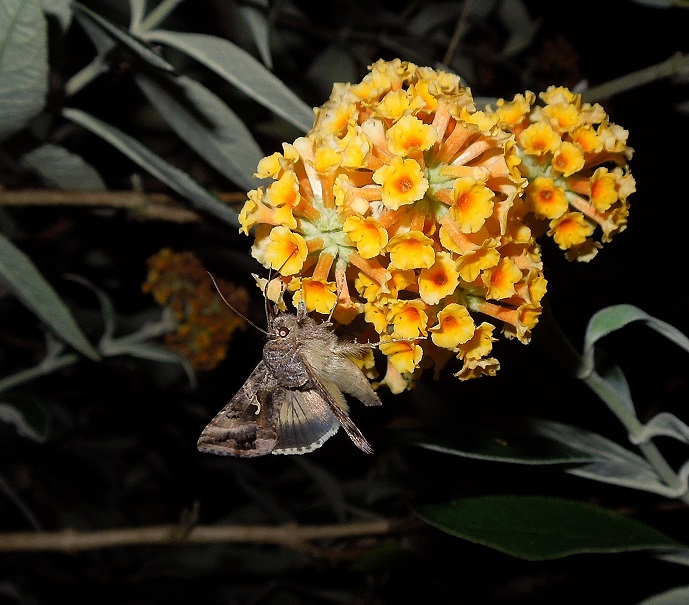
The Hummingbird Hawk-moth is an immigrant and day-flyer and is found in Ireland from May right up until November. The numbers that reach our shores every year vary greatly with hundreds recorded in a good year. The moth hovers in front of flowers and extends its long proboscis to suck up nectar. It will often return to a good nectar source for several days in a row.
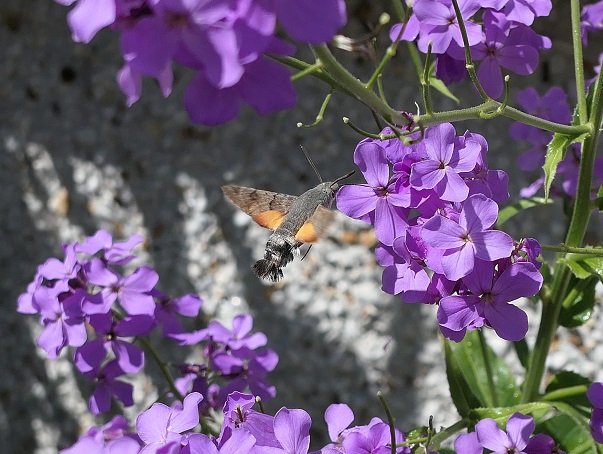
The caterpillars of the Cinnabar Moth are often very conspicuous as the openly feed and bask by day on their foodplant, ragwort. They absorb alkaloids from the plant and become distasteful to predators, a fact advertised by the black and yellow warning colours. Cinnabar moths have been introduced to New Zealand, Australia and North America to control ragwort. The adult, a night-flyer, also sports bright warning red and black colours. This moth is frequently disturbed during daylight by walkers who quickly notice the striking colours.
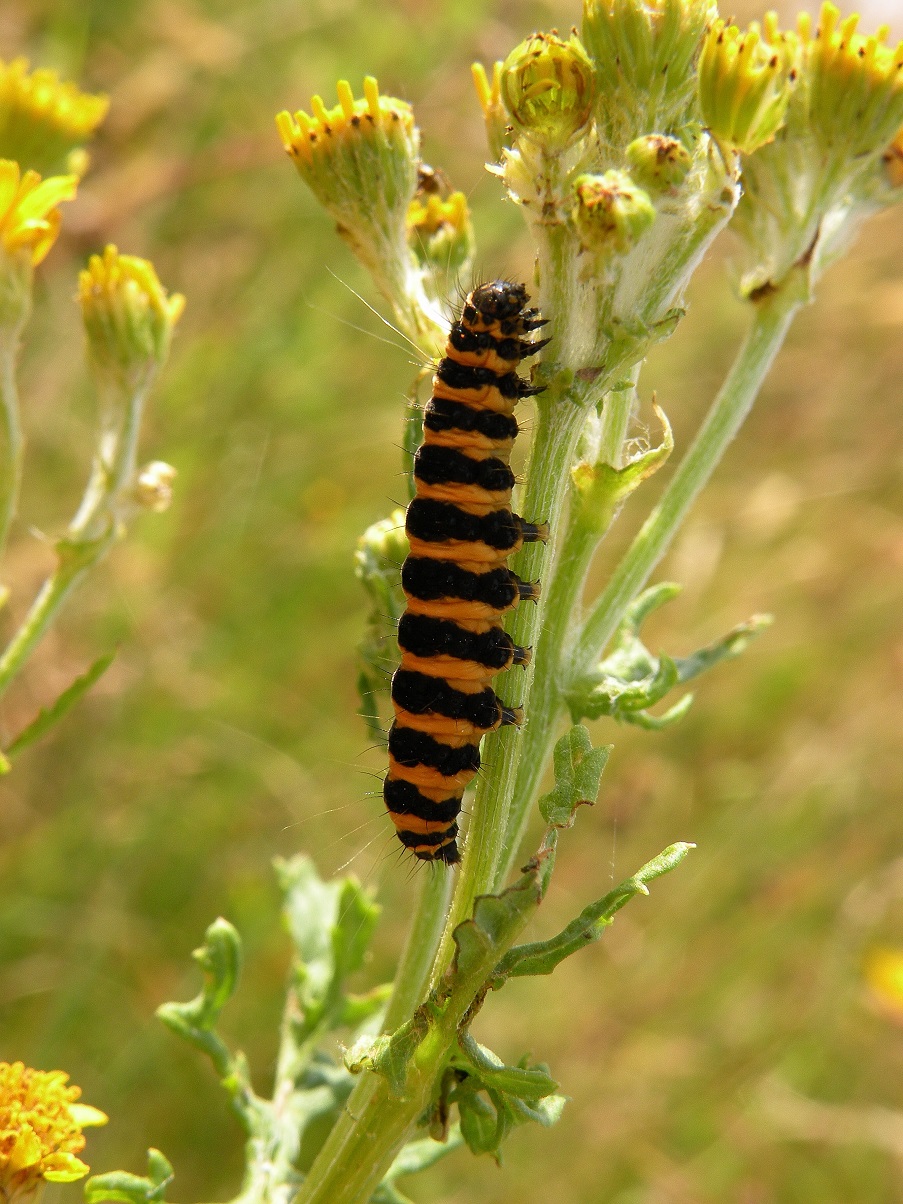
The Pale Tussock caterpillar is very distinctive in striking contrast to the adult moth which is more muted in its appearance. In autumn the fully-grown caterpillar wanders off looking for a suitable place to pupate and is often found during this roving phase. The adult moth (below right) flies at night in May and June and it is attracted to light.
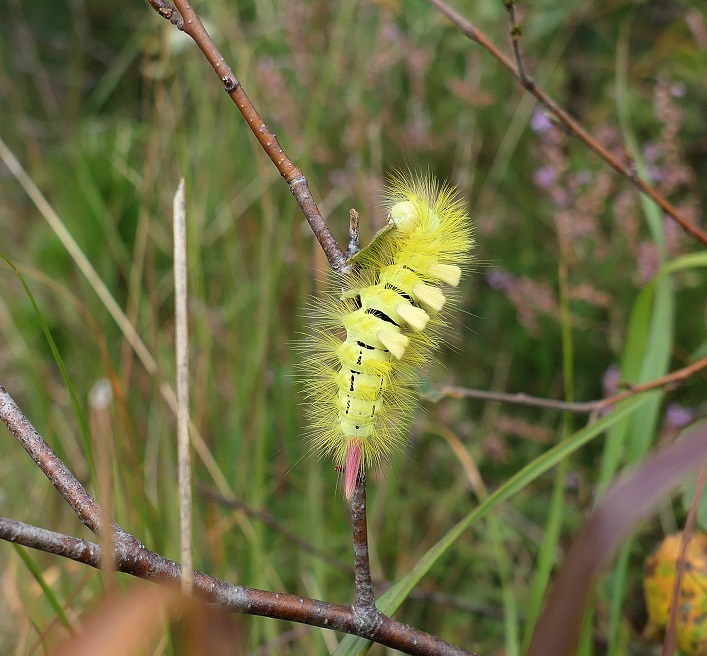
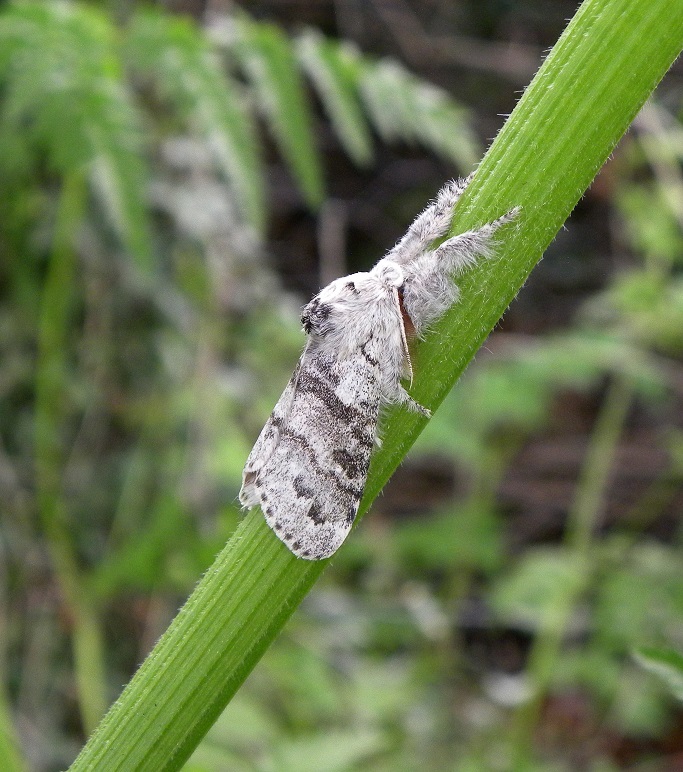
Emmelina monodactyla or Common Plume lives up to its name as it is found in every month of the year throughout Ireland. The adult rests with its wing rolled up and like all plume moths have a characteristic ‘T’ shape. The legs are long and spindly and the wingspan is about 25mm.
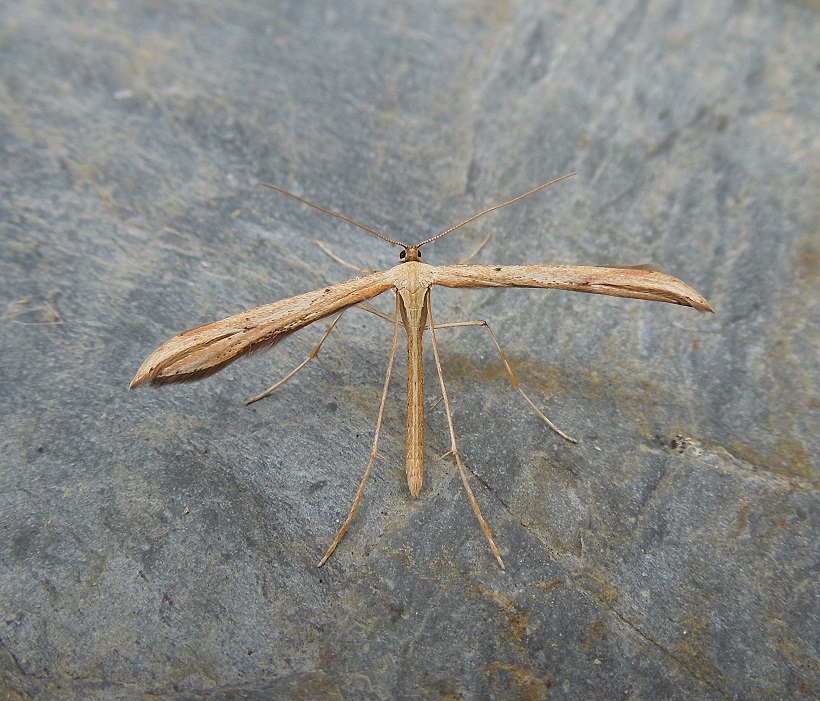
The Common Heath is another day-flyer that can occur in large numbers from April until July. It flies in sunshine and is found around bog and heather. It is easily disturbed when walking in such habitat, flying upwards and then settling again several meters away. The male moths have conspicuous plumed antennae which it uses to help locate females.
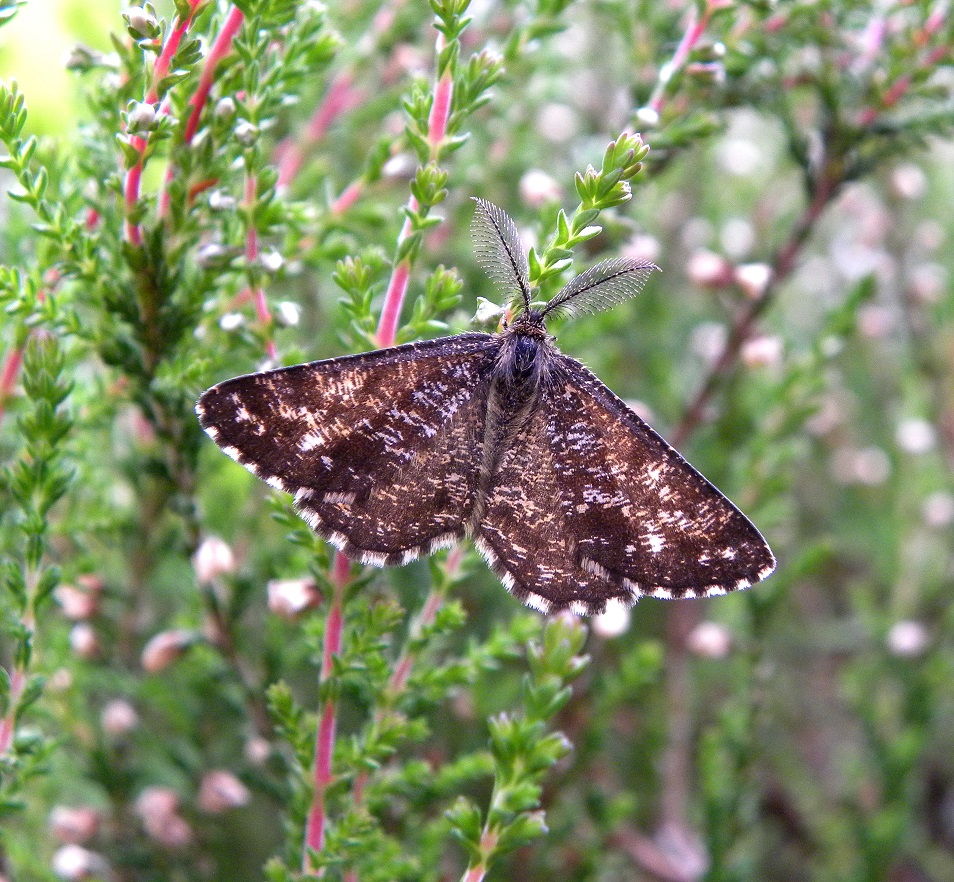
Finally, the Six-spot Burnet is another red and black moth, this one a day-flyer that also advertises its unpalatability. It is the commonest of our burnet moths and large numbers are often seen at coastal locations. While the caterpillar feeds on Common Bird’s-foot-trefoil the adults can sometimes be found feeding on a range of flowers with several together on a single head.
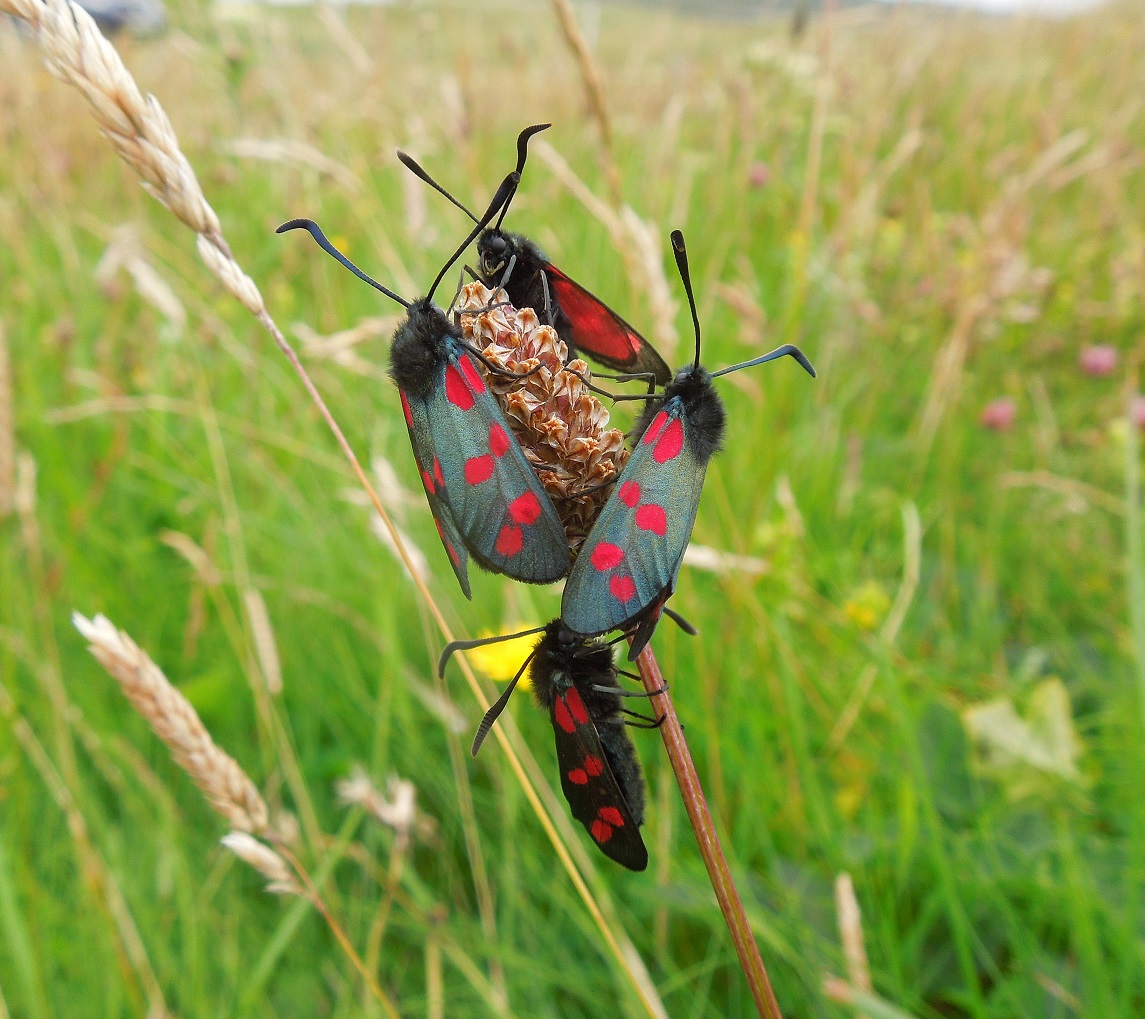
So that’s just a few of the 1400 or so species that occur in Ireland. Moths are everywhere and you don’t need to have a moth trap to see many of them. Moth records are also important as they contribute to the overall picture of species distribution and biodiversity. Records can be sent to MothsIreland or the NBDC via their Citizen Science Portal. If you would like any more information on moths please don’t hesitate to email me at philip@moths.ie
Exhibiting Butterfly Photographs
Butterfly Conservation Ireland member Mike Friel is currently living in South Korea, but Mike and his wife Songha are busy encouraging a love of butterflies there. This is greatly needed given the astonishing changes to the environment taking place on the Korean peninsula, where massive projects are obliterating entire landscapes. Here Mike explains what he did to promote a love for butterflies and moths…
In 2018 I held two butterfly mini-exhibitions in South Korea, where I live. One was outdoors and one indoors. The first was held in Spring, the second in Autumn, as these are the most clement times of year in the country.
I am an amateur photographer, so I had to swallow my humility, select what I (along with a second and third opinion) felt were my most interesting shots of butterflies and moths, and then display them in an attractive and economical way. I wanted to showcase these insects as few enough people here get to see much of their countryside, let alone its wildlife. I think that the following procedures could be applied just as easily in Ireland, with a few variations.
Outdoor Exhibition:
Clearly, the biggest risk outdoors was the rain. We (my wife Songha being the main organizer) decided nonetheless to approach the owner of a garden on Namhae Island, about 40 miles away from our house in the south, to see if he would like the idea of displaying photos for a limited time. As Mr Cha loves flowers, and as his very informal garden is open to the public every day (for a small entry charge), it seemed a good choice to us. To our delight, not only was he enthusiastic about the idea, but he quickly suggested the best place to show the photos, a long stone terrace wall about 10 feet high, at the end of which is a small open-air cafe. Some of the pictures could go on display in the cafe itself.
We discussed arrangements for the opening, to be held on a Saturday, and then hurried home and set about framing the 64 chosen pictures, printed by a local photographic shop. From Ikea we bought frames with plastic photo covers, avoiding heavy, breakable glass. Square frames measured 23 X 23cm, while the sides of rectangular frames ranged from 13cm to 30cm. About half of the photos had been taken locally (including one of a skipper in the garden itself), the rest in Colombia, Thailand, Czech Republic, Hungary and Ireland. I included quite a few moths, as well as two sub-groups, one showing interesting local caterpillars, the other showing some of the most popular adult butterfly feeding flowers in Korea.
Songha wrote and printed out a flyer advertising the event, which was to run from 5th to 22nd May, when the garden would have good butterflies. She distributed this to friends and to anyone else that we thought might be interested. We next paid another visit to Mr Cha, who prepared short wooden battens which we then hammered end-ways into cracks in the wall. We attached screws to the ends for hanging the photos on. We were still concerned about the likelihood of rain damage, but Mr Cha manfully agreed that he would remove all the photos if rain were to hit the garden. (In the end, we got lucky and he only had to do this and put them back again three times!). Mr Cha also offered to hand out the flyer to local shops and offices, and Songha put up an exhibition poster at the garden entrance.
On the opening day, we drove to the garden with all the framed photos, together with food and drinks for refreshments, stopping on the way to buy some fishing line to attach the pictures to the battens in the wall. We also had a few easels, for garden signage and for the sub-group photos. We soon realised we should have put up the photos earlier in the week, as we were rushed for time, especially when we found that our fishing line was designed for tiddlers and tended to break under the strain of the frames! But we sorted things out just before the first visitors arrived, and had the snacks and drinks ready.
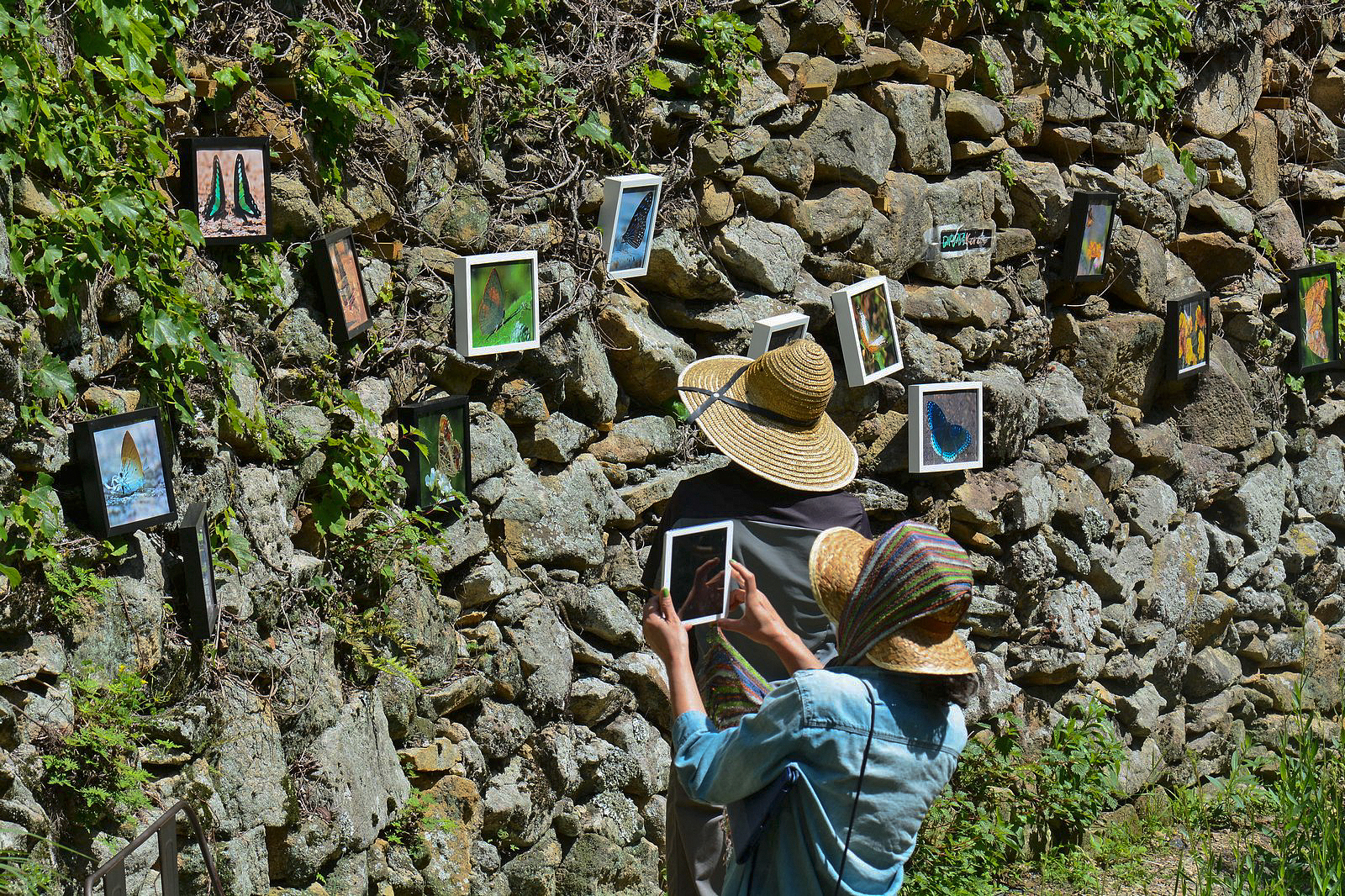
After I gave a short opening talk (which Songha translated into Korean), people dispersed to look around. Sometimes I pointed out the butterflies visiting the garden and answered questions about the pictures. Children often preferred the caterpillars, and we were surprised to find a day-flying moth resting on the wall close to where a photo of the same species was displayed. It was a day of good sunshine, and there was a fair mix of those who had received notice of the exhibition together with total strangers just visiting the garden and happy to enjoy the refreshments.
I was only able to visit the exhibition on three more occasions, but Mr Cha acted as curator in our absence, and he said he had plenty of visitors over the three weeks. On our last visit, a local news reporter was waiting to ask me a few questions. I said to her that I think there are at least three ways in which all of us can help to conserve butterflies. First, join a wildlife conservation organisation and play an active part in it, with your children if possible. Second, if you work in a garden or allotment, make sure it has plants which are useful to butterflies. Third, if you are responsible for any property, think carefully before you alter it. Will the alterations harm or benefit wildlife?
Mr Cha was very pleased with the increase in visitors, and we were happy to have in a small way raised awareness of butterflies and moths among the people who looked at the photos or read the newspaper article.
Indoor Exhibition:
We held the second exhibition at home, showing both my photos and my wife’s paintings of places visited on her travels. We opened it each day in the afternoon from 9th till 21st October, during the best of the autumn weather, when the typhoons had passed and there were still plenty of butterflies visiting the garden. This was the second time I had held a home exhibition. The first time, I had displayed really large unframed prints, but we found that, while being eye-catching, they were expensive and difficult to mount, so this time I used the same print-size and framing as for the outdoor exhibition. We hung some of the photos on walls, and the rest in pairs on boards resting on easels.
Again, Songha produced a flyer to publicise the event. As it was local, this flyer was distributed in a couple of nearby villages and towns. This meant that a wide variety of visitors came. The first to visit were two interested local policemen. I got a shock to come home and see their car outside! As we knew many of the visitors, this time, instead of an opening talk, we held two parties, on the first Saturday and Sunday. We live in a small farming village, and the local old ladies came on Saturday afternoon and ate, while the local old men came separately in the evening and drank.
I was very pleased that so many village people came because just by coming there was a good chance that they would appreciate even more the wildlife for which they are responsible. While many still follow the dictates of agribusiness, I have noticed a growing awareness locally of the dangers of things like chemical overuse and poor plastic disposal. At the same time, they are in general very tolerant of non-destructive wildlife; there is very little hunting, except when the occasional wild boar wreaks havoc to a crop.
On Sunday friends came, and it was great when some kids asked really searching questions. One small boy brought me a large chrysalis which he’d found in the field next door. This was a good opportunity to gently explain to him through his father why it was in the best interests of the butterfly to put it back into the earth quickly.
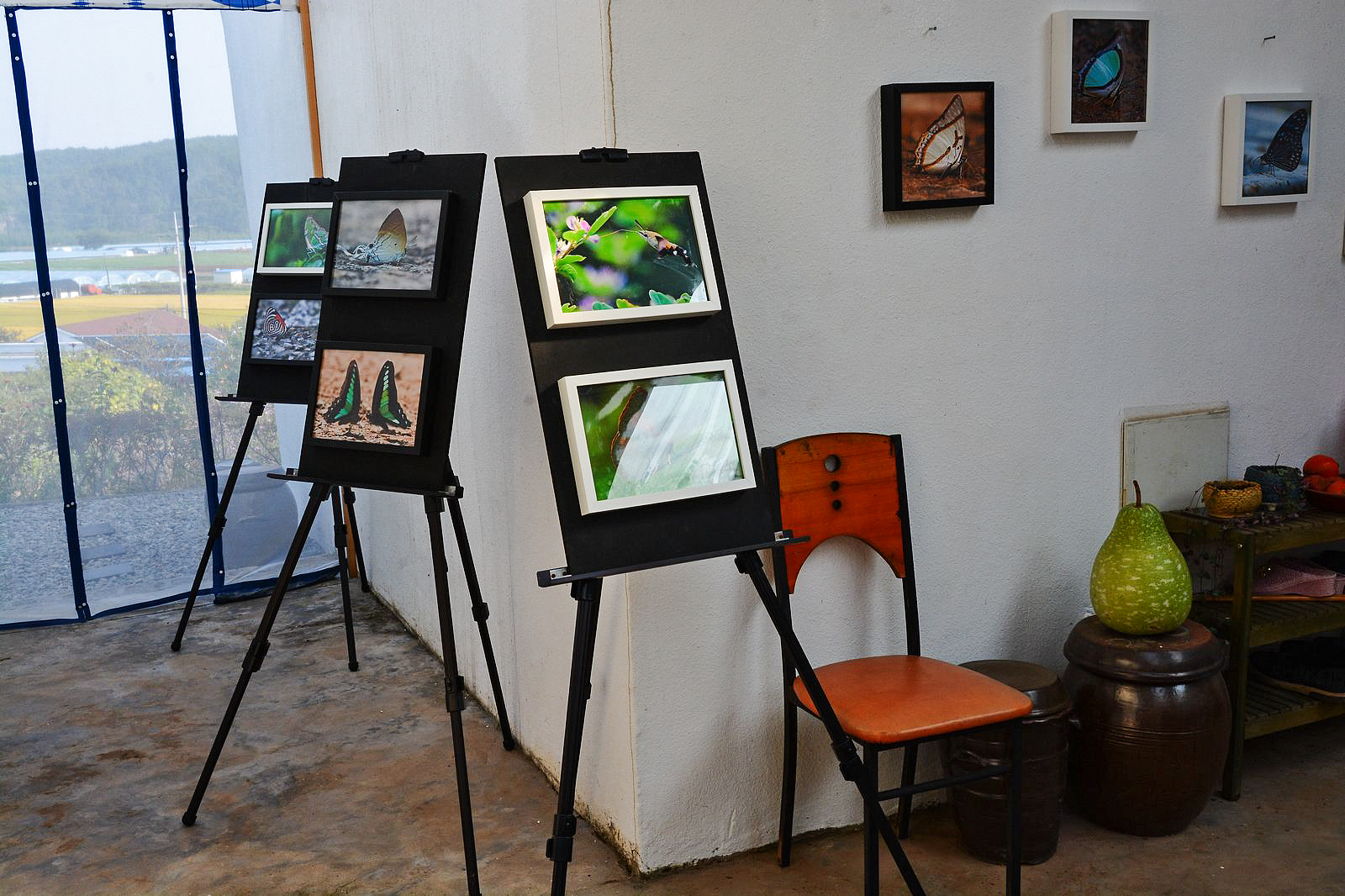
There were some advantages to holding the exhibition at home rather than outdoors at a distance. We were able to talk at all times with the visitors, I could change the pictures sometimes, I was able to show people round the garden and describe the butterflies there, I could show and explain the moth trap, visitors were seeing pictures of insects from their locality (for the first time in the case of most of the moths) …… and we didn’t have to worry about the weather.
I would say to anyone who enjoys photographing butterflies and moths: you surely have interesting shots taken locally and around the country. Printing them is easy these days, and frames are cheap too if you look around a bit. No one will expect you to be a photographer and that means that they will focus their questions on the subjects of your pictures, about which you can tell them quite a lot. The easier option is displaying in your home. With the small-sized prints, no one needs to live in a mansion to do this. Make your mini-exhibition an excuse for a party, but with a serious purpose behind it: to make people more aware of and interested in the conservation of your favourite insects.
Later you can repeat the exercise on a larger scale, in a community hall, a garden open to the public, or a school or college. It helps to have one or more friends or a partner organizing the event with you, and you can even have a small entry charge (though in Korea we didn’t charge for the indoor exhibition as we knew people would usually bring an offering with them). The most important thing is to not think for a second about whether your photos are better or worse than anyone else’s, only that they may well be interesting for people who have never seen butterflies and moths so close before. Then go for it!
British Butterfly Safari: The Butterflies of North Wales and Southern England
“I find that what really remains with me…is…that…view…of the rolling English countryside…other countries can offer more obviously spectacular scenery…but…the English landscape at its finest…possesses a quality…that will mark out the English landscape as the most deeply satisfying in the world…” (The Remains of the Day, Kazuo Ishiguro)
Mr Stevens, the fictional butler of Darlington Hall makes these admiring remarks after he surveys the English landscape from a high vantage point on his way to Salisbury. The English countryside in the southern half of England has a gentle rolling topography and is best viewed from a high point such as Leith Hill, Surrey, or Painswick Beacon, Gloucestershire. While the landscape laid out below in fields bordered by hedgerows looks comfortably like the Irish landscape, there are clear differences. The English landscape looks generally tidier and much more wooded, with woods containing mature oak clothing many hilltops. The grasslands look paler and drier than Irish pastures. Our holiday in North Wales and Southern England took place in the third and fourth weeks in July coinciding with blistering heat and temperatures in the mid-30s Celsius on at least three days of our visit. Our itinerary involved visiting a number of important butterfly sites. Here I describe my experience of five of these.
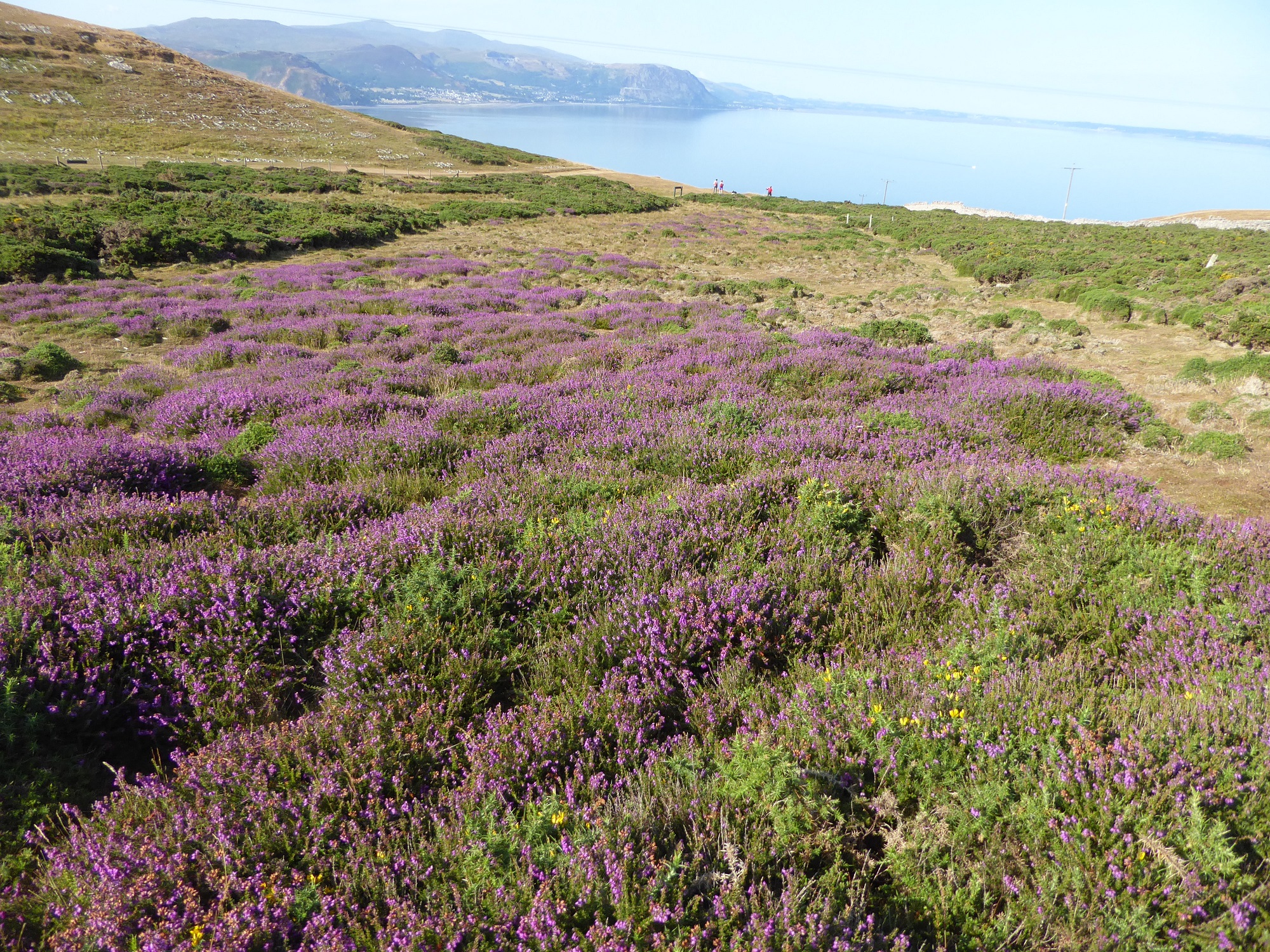 Great Orme’s Head, Wales
Great Orme’s Head, Wales
Our first top butterfly site is in North Wales (in the areas we visited everyone, from young children, teens congregating outside takeaways, adults and the elderly spoke Welsh). The site we visited early on July 19th was Great Orme’s Head, a steep limestone headland maintained by the Conwy Countryside Service. There is an enormous car park at the summit, a tram terminus and a cluster of buildings. These interventions subtract habitat which is very disappointing. It is especially unfortunate here because the site has the remarkable distinction of holding two unique subspecies, the Great Orme’s Grayling Hipparchia semele subspecies Thyone and Silver-studded Blue Plebejus argus subspecies caernensis. The Grayling found here is a dwarf race that is paler and begins to emerge about a month before Graylings elsewhere in Britain. By July 19th many were faded but not worn. They were numerous and active by 9 am, basking on the limestone outcrops, angled sharply towards the stone surface. The main habitats here are heath and limestone grassland, excellent for this unique butterfly. The Great Orme Silver-studded Blue also merges earlier, from about the second week in June, is smaller than Silver-studded Blues found outside the area and the upper side of the female’s wings are mainly blue, not brown as elsewhere.
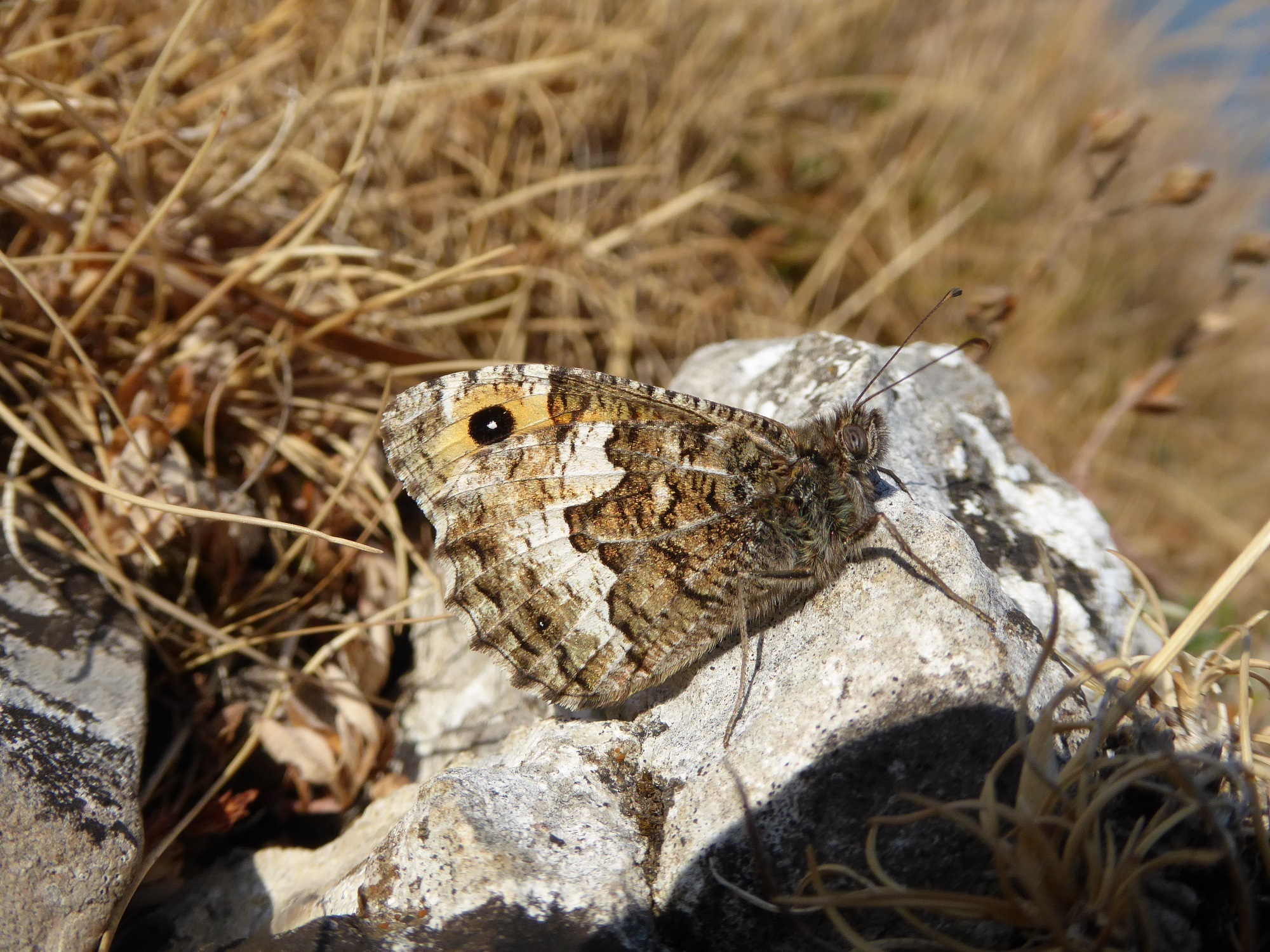 Great Orme’s Grayling © J.Harding.
Great Orme’s Grayling © J.Harding.
This race is now found in the Dullas Valley, about 13km to the east of Great Orme’s Head. It was introduced in the Dullas Valley in 1942 and has since spread. Unfortunately, because of the prolonged heat the butterfly’s flight period was over when I arrived but there were many other butterflies, including what must have been hundreds of Brown Argus and Meadow Brown butterflies. A few Hedge Browns (Gatekeepers) fluttered around the small patches of scrub (why is this butterfly not found this far north in Ireland?). Dark Green Fritillary was also present, but well-worn. The best spots were sheltered areas where Creeping Thistle was flowering as many butterflies, except Graylings, were concentrated in these nooks. In all, I found 20 species of butterfly at Great Orme’s Head that day. This beautiful site is really popular with visitors so get there early if you want to view the butterflies without your quarry being disturbed.
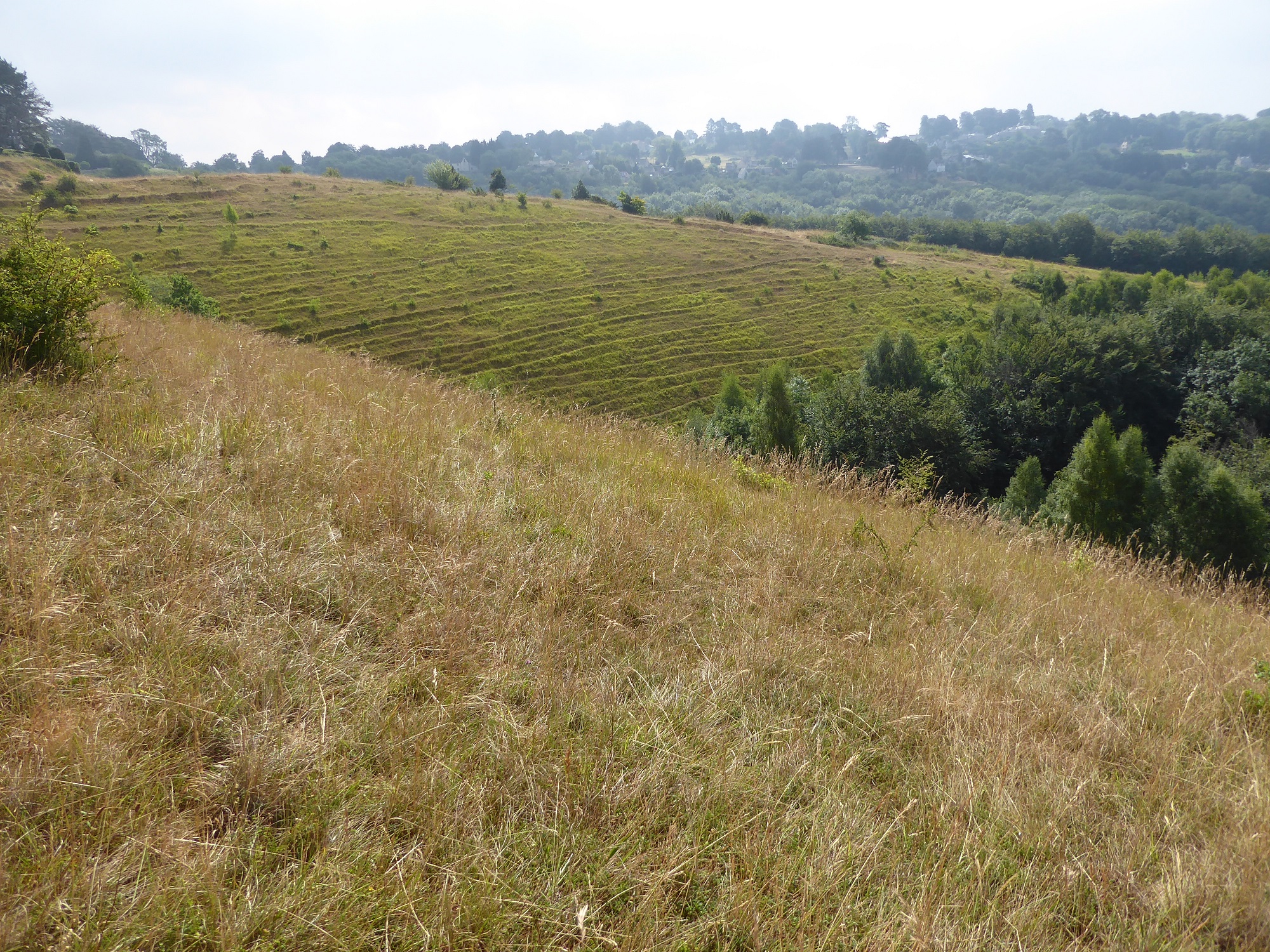 Rodborough Common. Note the terracettes arising from soil creep.
Rodborough Common. Note the terracettes arising from soil creep.
On July 21st, on a day with some cloud, we visited our next target site, Rodborough Common, a limestone grassland designated a Special Area of Conservation situated above the suburbanised Stroud valley in the lovely Gloucestershire Cotswolds. The Common is owned by the National Trust since 1937. The Common is featured in Mathew Oates’ book, In Pursuit of Butterflies: A Fifty-year Affair (2015) where it is greatly praised. Keen to see it, we ascended the steep slope and parked at the first pull-in spot. Once we got beyond the dense grassland adjoining the road and reached shorter, more flowery areas we started to see our first Chalkhill Blues. These were perfect, freshly emerged, sharply powder blue in strong light. Again, Brown Argus were numerous, and Common Blues, also quite common, were notably smaller overall than Irish specimens. Some were very small no doubt reduced by premature pupation of larvae unable to find enough food in the hot dry weather in June which caused food plants to shrivel. Meadow Browns and Small Heaths were again present, the former quite numerous with paler undersides than Irish specimens. Dark Green Fritillaries were again worn. On a lower slope among tall scrub, close to woodland, a worn female Silver-washed Fritillary was busy laying on Beech stumps. In the same area, Hedge Browns were numerous, feeding on Hemp Agrimony. The site is well-managed, with cattle grazing to keep the vegetation short to suit the rarer species like the stunning Adonis Blue, which flies in two broods, in May and August/September.
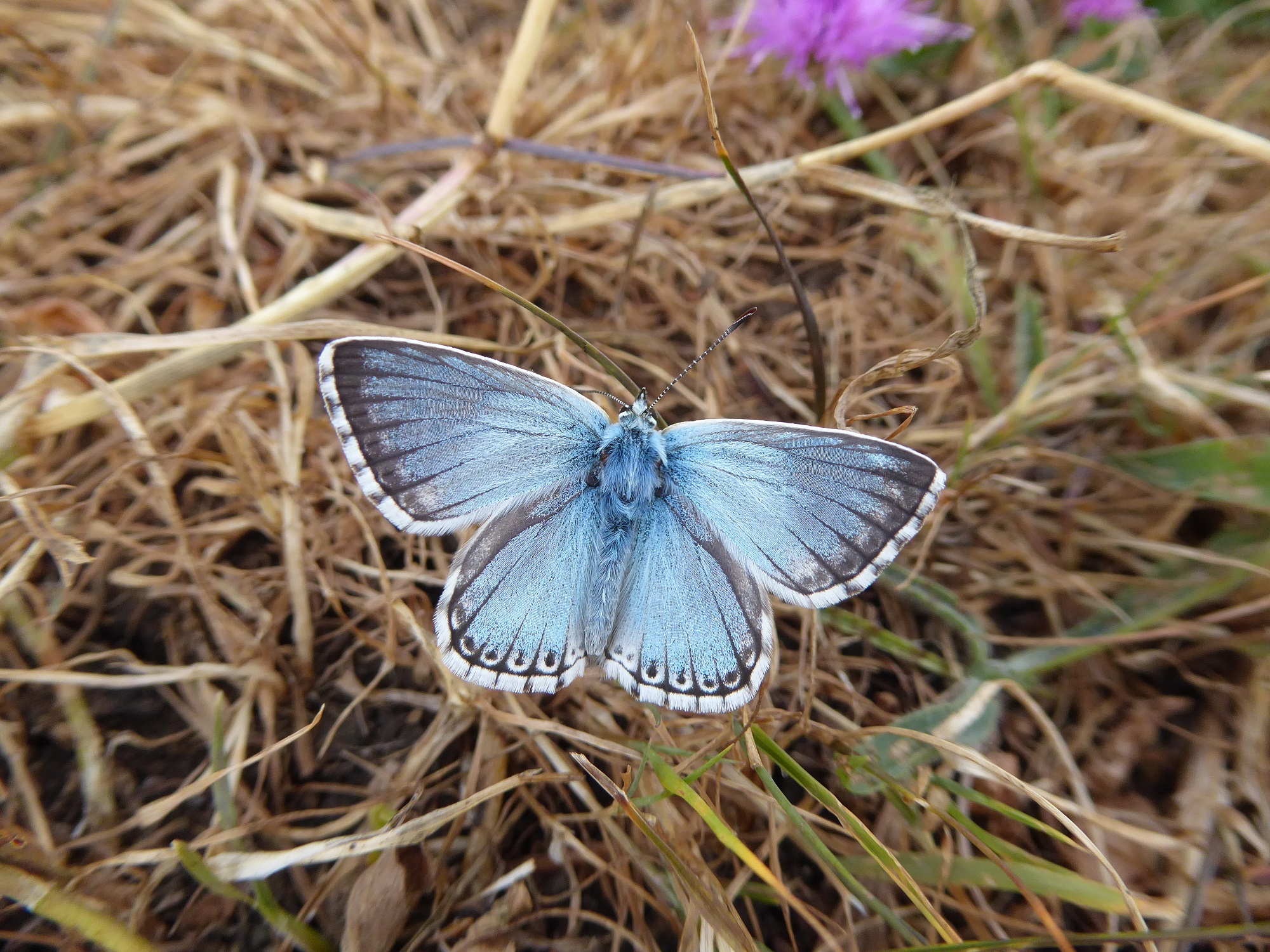 Chalkhill Blue (male) on Rodborough Common. © J.Harding.
Chalkhill Blue (male) on Rodborough Common. © J.Harding.
While in Gloucestershire we stayed in a cottage in the charming Cotswolds village of Painswick. In the cottage I found a book describing Painswick Beacon, a local hilly limestone and chalk grassland common and I set off to find it. It is a very impressive place, and I could have spent every day of the rest of our time there! The site holds five skippers, five resident whites (Clouded Yellow is also likely to occur there when it arrives in England in good numbers), at least two hairstreaks, seven blues, including the highly endangered recently introduced Large Blue, the Small Copper, the Duke of Burgundy, two fritillaries, five aristocrats (Red Admiral, Comma, etc) and six browns. Most of this impressive total of 35 species was on the wing when I visited. Large, Small and Essex Skippers were sighted. A lovely male Brimstone, a deeper yellow than the Irish subspecies, was seen but proved very unsettled. The Large White and Small White were very numerous. I saw around 50 of each on July 22nd, along with all the aristocrats, good numbers of Chalkhill Blues (although highly localised), Common Blues and a few second-generation Small Blues, Marbled Whites, Speckled Woods, Meadow Browns, a single, rather heat-stressed Ringlet and Small Heaths. There is a good population of Hairy Violet on the site, used by the Dark Green Fritillary for breeding. The site contains a golf course which does not adversely affect the common’s biodiversity.
![]() Painswick Common, Gloucestershire. © J.Harding.
Painswick Common, Gloucestershire. © J.Harding.
The grass on the steep slopes is shorn, providing conditions for the Large Blue, whose ant host, Myrmica sabuleti, needs extremely warm, unshaded grassland. The ants take the caterpillars into their nests which then feed on the ants’ grubs. The larvae pupate the following May and emerge in late June, flying for a few short weeks. Alas, the heat brought an early closure to its flight and I missed it! Some areas are seeing non-natives invading former quarried areas, especially clematis, but Paul Baxter and his team manage the Common (he kindly invited me to join their group!) by controlling scrub. Larval food plants for the Large Blue, (Wild Thyme) are also planted. It is a deeply interesting site for many reasons, including its history and the spectacular views of the landscape from the summit. Following four glorious days at Painswick, we visited Blenheim Palace in Oxfordshire where the oak woods and even individual parkland oaks held Purple Hairstreaks. Many settled low down and in Bernwood Forest some were landing on the grass.
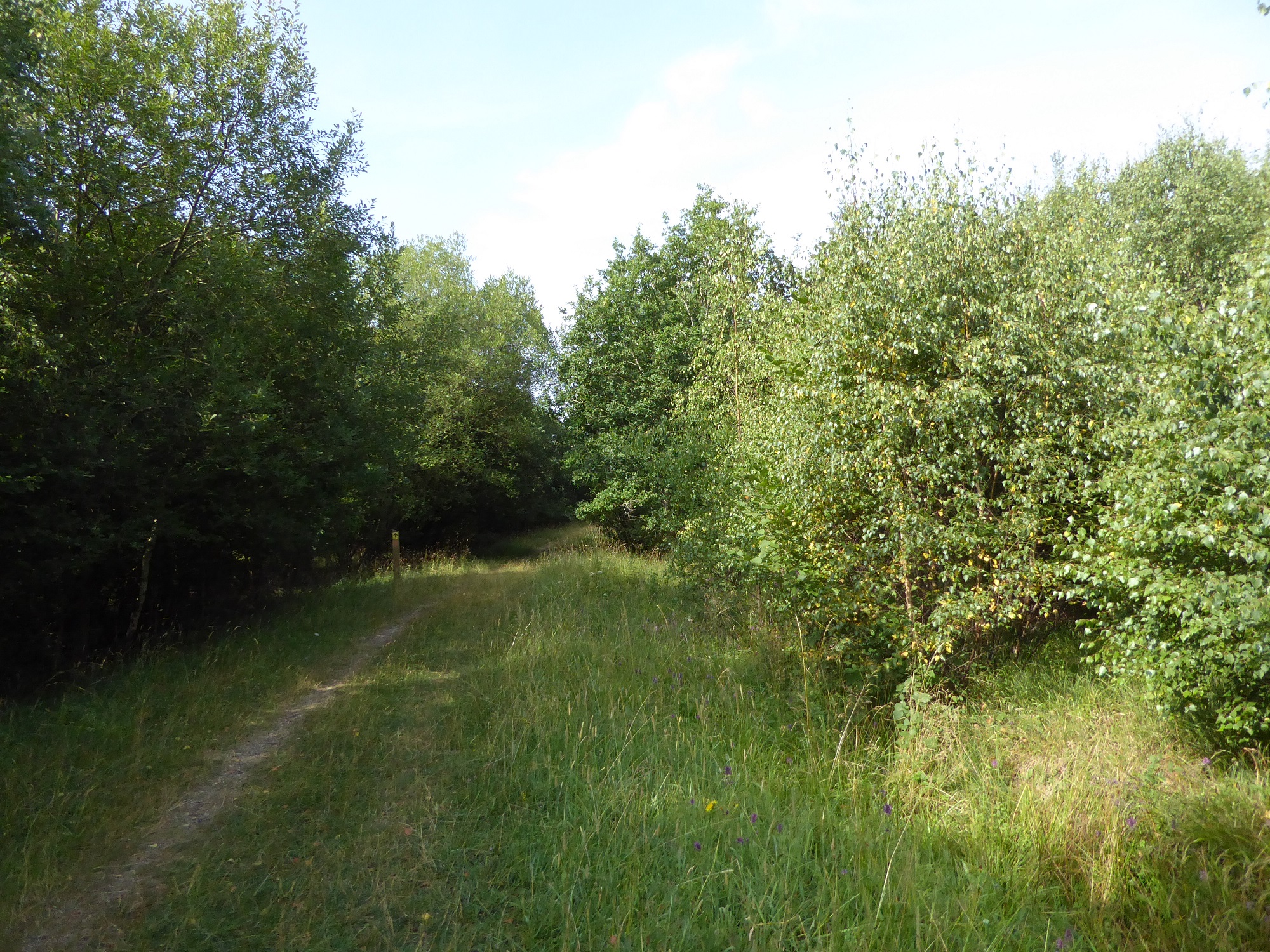 Bernwood Forest, Northamptonshire. © J.Harding.
Bernwood Forest, Northamptonshire. © J.Harding.
Bernwood Forest in Buckinghamshire (13 miles NE of Oxford) is home to around 40 species. On July 25th a fair number of these were seen especially Large Skipper (c.30 seen), Purple Hairstreak and Silver-washed Fritillary (c.30 seen). The wood, which contains stands of non-native coniferous trees and native oak, hawthorn, willow and Purging Buckthorn is on clay soil and the ground looks to be usually wet but was very dry when we visited. The open grassy areas held good numbers of Common Blue, Hedge Brown and Meadow Brown. Broad flowery rides allow good light into what is generally quite open woodland which explains why the butterfly populations here are so high. The adjoining two meadows bordered by well-developed hedges hold Black and Brown Hairstreaks but we were probably too late and too early respectively! We missed Purple Emperor and White Admiral too. The wood is not easy to find without google maps as it is reached by travelling along sinuous narrow country roads. Parking lies on the roughish ground in the woods. From Oxford, we journeyed to Surrey to visit Box Hill, a National Trust chalk grassland and woodland.
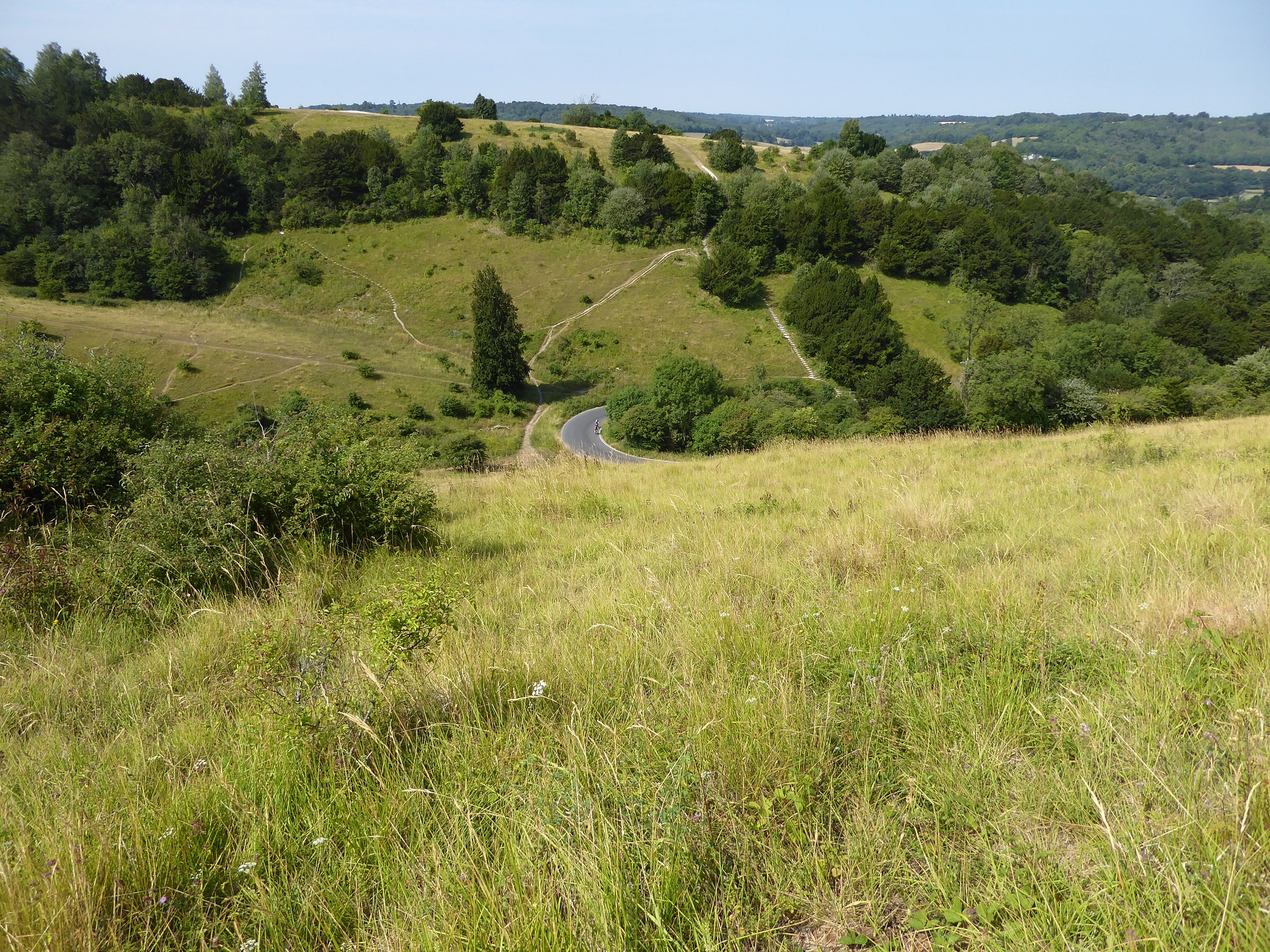 Box Hill, Surrey, © J.Harding.
Box Hill, Surrey, © J.Harding.
Box Hill (Special Area of Conservation) is a wonderful place, its summits offering lovely views of rolling, leafy landscape. July 27th continued very hot so we arrived early to avoid the greater heat later in the day. The particular target butterfly here was the Silver-spotted Skipper, a butterfly that shows a cuddly teddy-bear resemblance. Usually not in flight until August it was out in force when we arrived. It flies fast and low over the chalk, pausing occasionally to take nectar on Dwarf Thistle. I’d last seen it on this site in August 1995 and was delighted to see it still thriving as it is a rare butterfly which was in serious trouble in the 1980s after years of colder summers and deteriorating habitats. According to Thomas 1991, it was confined to about 20 southern downs. Since then, warmer summers and better management has produced a good recovery, but it is still very limited in its distribution, occurring on chalk grassland with a low, sparse sward.
The Chalkhill Blue occurred in small numbers on Box Hill in 1995, and this was still the case in July 2018. Its close relative, the Adonis Blue is found here too and the Purple Emperor now occurs in its oak woods. Other notables are White-letter Hairstreak and White Admiral. Two very nice moths were seen too. Lace Border and Straw Belle, both quite scarce, were seen fluttering over the flowery slopes. Overall the site including nearby habitats is currently home to 37 butterfly species. While impressive, there are worries for some of these species, including the Adonis Blue (small amounts of Horseshoe Vetch, the larval food plant) and Dark Green Fritillary (most of the sward is unsuitable because the Silver-spotted Skipper’s need for a sparse, low sward is prioritised).
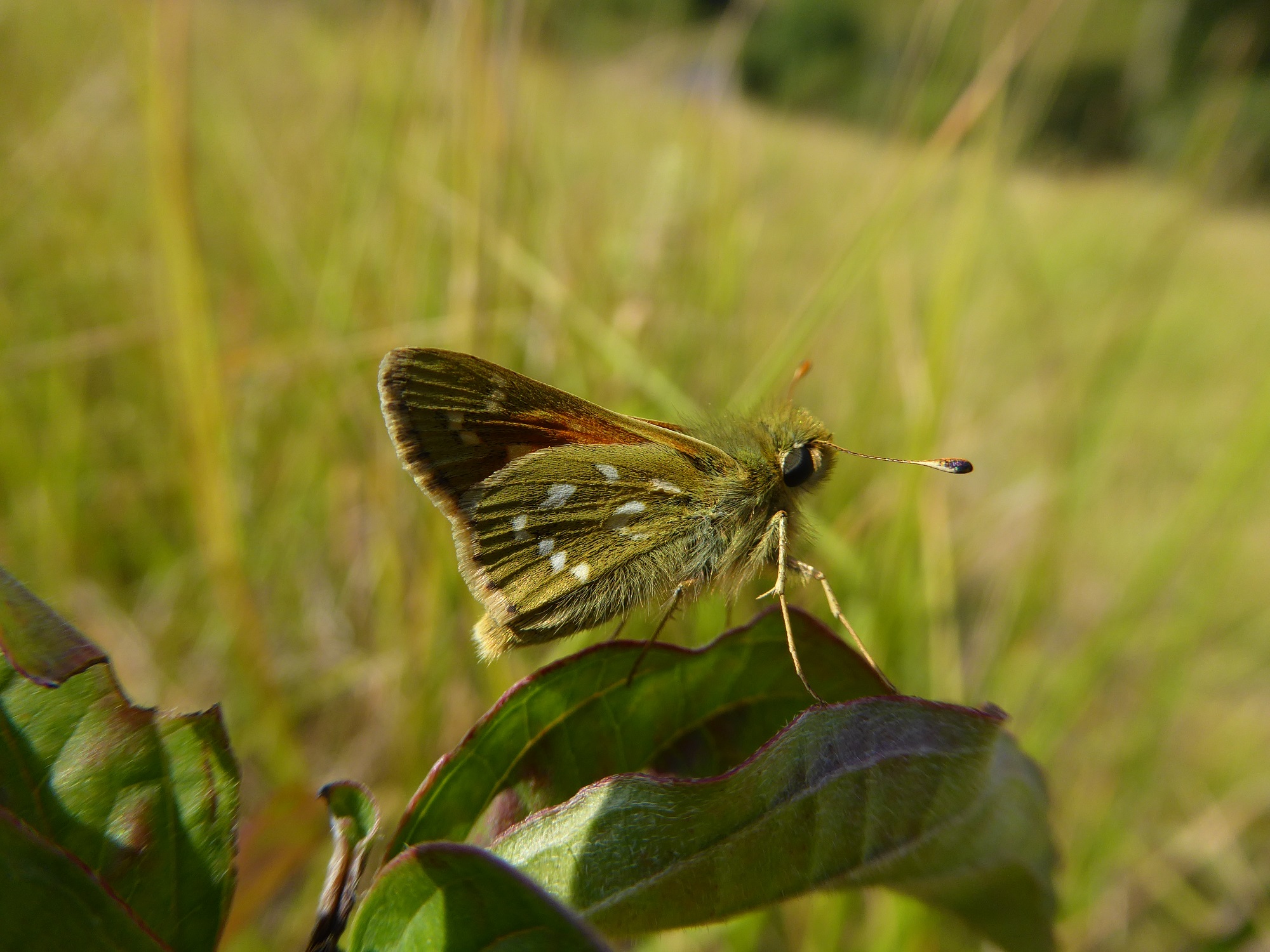 Silver-spotted Skipper. © J.Harding.
Silver-spotted Skipper. © J.Harding.
Furthermore, there have been serious losses, reported by Gail Jeffcoate in her useful booklet, The Box Hill Book of Butterflies (2002). The Small Blue (1996), High Brown Fritillary (c.1970), Pearl-bordered Fritillary (1950s), Duke of Burgundy (early 1990s), Grayling (1950s) and Wall (1990s) have all been lost. The increase in woodland and the increase in shade in the woods on the hill are implicated in some of these losses. The decline of the Kidney Vetch is responsible for the loss of the Small Blue. This plant may be lost through over-grazing which certainly took place in 1995 when I saw the sheep strip the hill of much of its vegetation. Sheep grazing which helped the Silver-spotted Skipper certainly did not help the Small Blue. This underlines how difficult it can be to manage sites for a wide range of butterflies that have different ecological niches. We need landscape-level conservation, not isolated sites where only some species’ needs can be prioritised sadly, at times, at the expense of other species.
On July 28th the weather broke, and the extreme heat was over. It was just as well, as the drought was threatening to destroy butterfly larvae. In 1977 butterfly populations plummeted following the drought of 1976. While 2018 and 1976 are the joint hottest summers on record for Britain, the rains came in September, in 1976. In 2018 rain arrived in late July, thankfully.
My overall impression of butterflying in North Wales and England is positive. There are 59 species in Britain compared with 35 in Ireland and some species that are rare here, such as Purple Hairstreak and Hedge Brown are very common in the southern half of Britain. However, I am confused by the very small number of Peacocks I saw. Many of the good sites are in good condition and have good parking and other facilities, and are generally easy to find. However, the sites are heavily visited and there seems to be nowhere that one can ramble without meeting dog walkers. There is no wilderness atmosphere in any of the areas I visited, in contrast with many areas in Ireland, including even well-populated counties like Kildare and Louth. Most worryingly, the protected areas, numerically many, are quite small. Furthermore, the losses at Box Hill have been repeated over most of Britain especially since the 1950s. Larger areas need to be managed for nature if biodiversity is to be properly safeguarded for time to come.
BUTTERFLY CONSERVATION IRELAND ANNUAL REPORT 2018
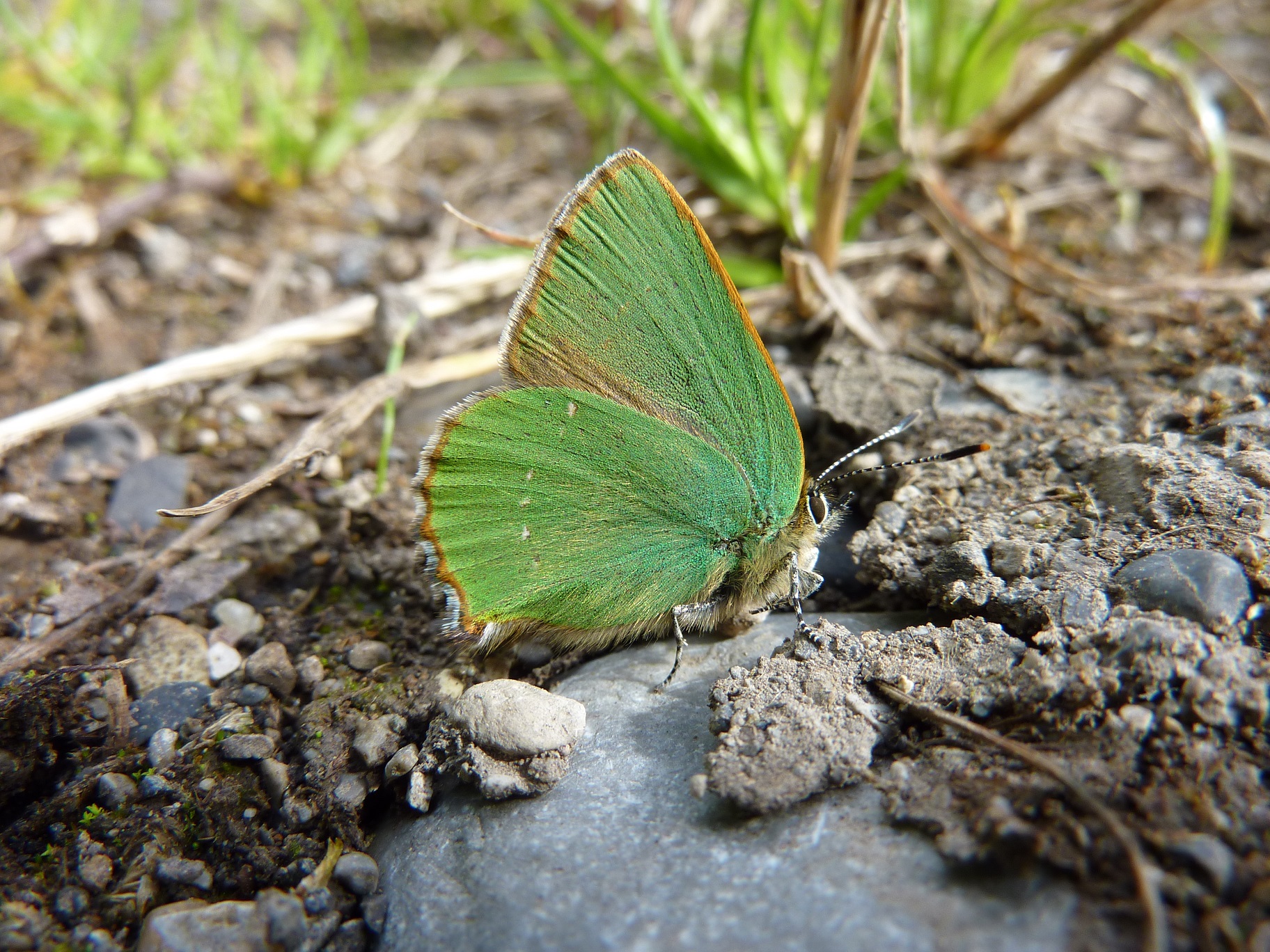 Green Hairstreak ©J.Harding
Green Hairstreak ©J.Harding
BUTTERFLY CONSERVATION IRELAND is a company limited by guarantee. Registered in Ireland No. 451571.
BUTTERFLY CONSERVATION IRELAND is a charity. Registered Charity no.: 20069131.
CONTACT DETAILS:
By email: conservation.butterfly@gmail.com.
By Post:
Butterfly Conservation Ireland,
Pagestown,
Maynooth,
County Kildare.
By phone: 01-6289901.
Website: https://butterflyconservation.ie/wp/
Facebook: https://www.facebook.com/ButterflyConservationIreland/

